The Entrepreneurship Prospects of Tesla
VerifiedAdded on 2021/10/12
|35
|9926
|41
AI Summary
1.0 Introduction 3 2.0 Identification of the innovative nature of Tesla 4 3.0 Identification of the risk taking nature of Tesla 5 4.0 Identification of proactive nature of Tesla 5 5.0 Identification of entrepreneurship intensity of Tesla 6 6.0 Innovation goals of Tesla 7 7.0 Market orientation of Tesla 8 8.0 Evaluation of allocation of resources 9 8.1 Identification of the critical resources 99.0 9.0 Identification of strategic resources 10 10.0 Entrepreneurial personality traits 11 11.0 Identification of management style 11 12.0 Structure of Tesla 12 13.1 Effect on entrepreneurship 13 13.2Organizational
Contribute Materials
Your contribution can guide someone’s learning journey. Share your
documents today.
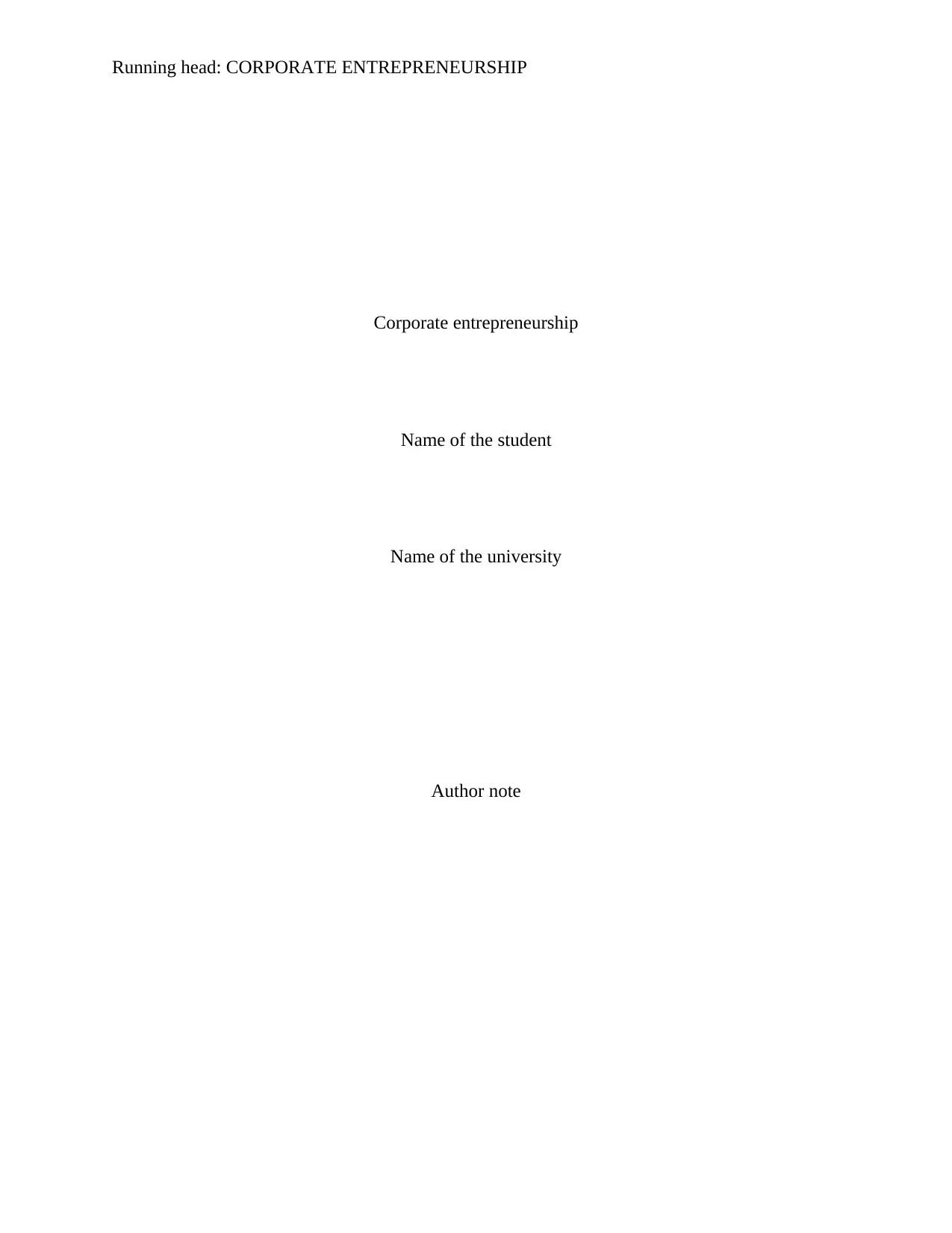
Running head: CORPORATE ENTREPRENEURSHIP
Corporate entrepreneurship
Name of the student
Name of the university
Author note
Corporate entrepreneurship
Name of the student
Name of the university
Author note
Secure Best Marks with AI Grader
Need help grading? Try our AI Grader for instant feedback on your assignments.
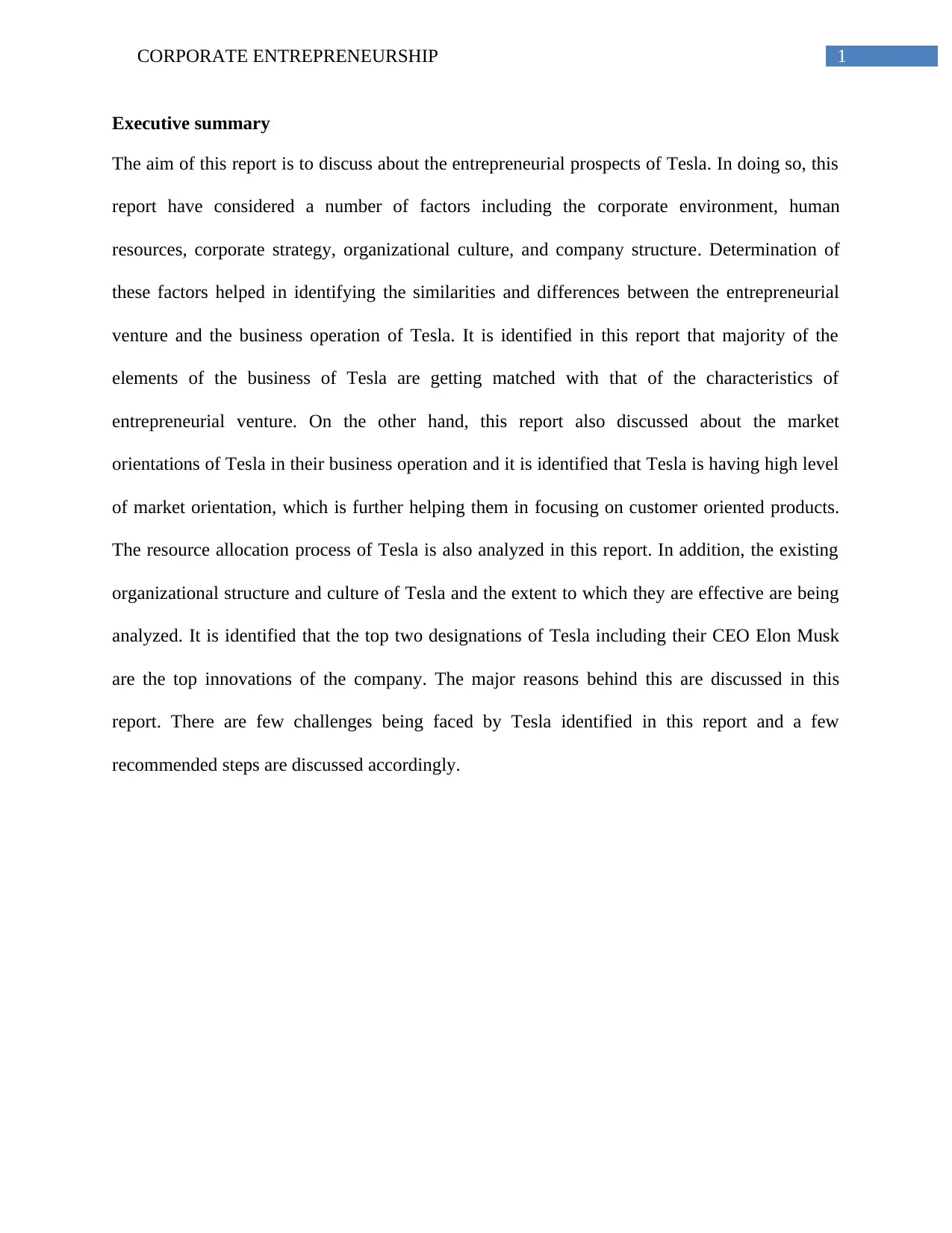
1CORPORATE ENTREPRENEURSHIP
Executive summary
The aim of this report is to discuss about the entrepreneurial prospects of Tesla. In doing so, this
report have considered a number of factors including the corporate environment, human
resources, corporate strategy, organizational culture, and company structure. Determination of
these factors helped in identifying the similarities and differences between the entrepreneurial
venture and the business operation of Tesla. It is identified in this report that majority of the
elements of the business of Tesla are getting matched with that of the characteristics of
entrepreneurial venture. On the other hand, this report also discussed about the market
orientations of Tesla in their business operation and it is identified that Tesla is having high level
of market orientation, which is further helping them in focusing on customer oriented products.
The resource allocation process of Tesla is also analyzed in this report. In addition, the existing
organizational structure and culture of Tesla and the extent to which they are effective are being
analyzed. It is identified that the top two designations of Tesla including their CEO Elon Musk
are the top innovations of the company. The major reasons behind this are discussed in this
report. There are few challenges being faced by Tesla identified in this report and a few
recommended steps are discussed accordingly.
Executive summary
The aim of this report is to discuss about the entrepreneurial prospects of Tesla. In doing so, this
report have considered a number of factors including the corporate environment, human
resources, corporate strategy, organizational culture, and company structure. Determination of
these factors helped in identifying the similarities and differences between the entrepreneurial
venture and the business operation of Tesla. It is identified in this report that majority of the
elements of the business of Tesla are getting matched with that of the characteristics of
entrepreneurial venture. On the other hand, this report also discussed about the market
orientations of Tesla in their business operation and it is identified that Tesla is having high level
of market orientation, which is further helping them in focusing on customer oriented products.
The resource allocation process of Tesla is also analyzed in this report. In addition, the existing
organizational structure and culture of Tesla and the extent to which they are effective are being
analyzed. It is identified that the top two designations of Tesla including their CEO Elon Musk
are the top innovations of the company. The major reasons behind this are discussed in this
report. There are few challenges being faced by Tesla identified in this report and a few
recommended steps are discussed accordingly.
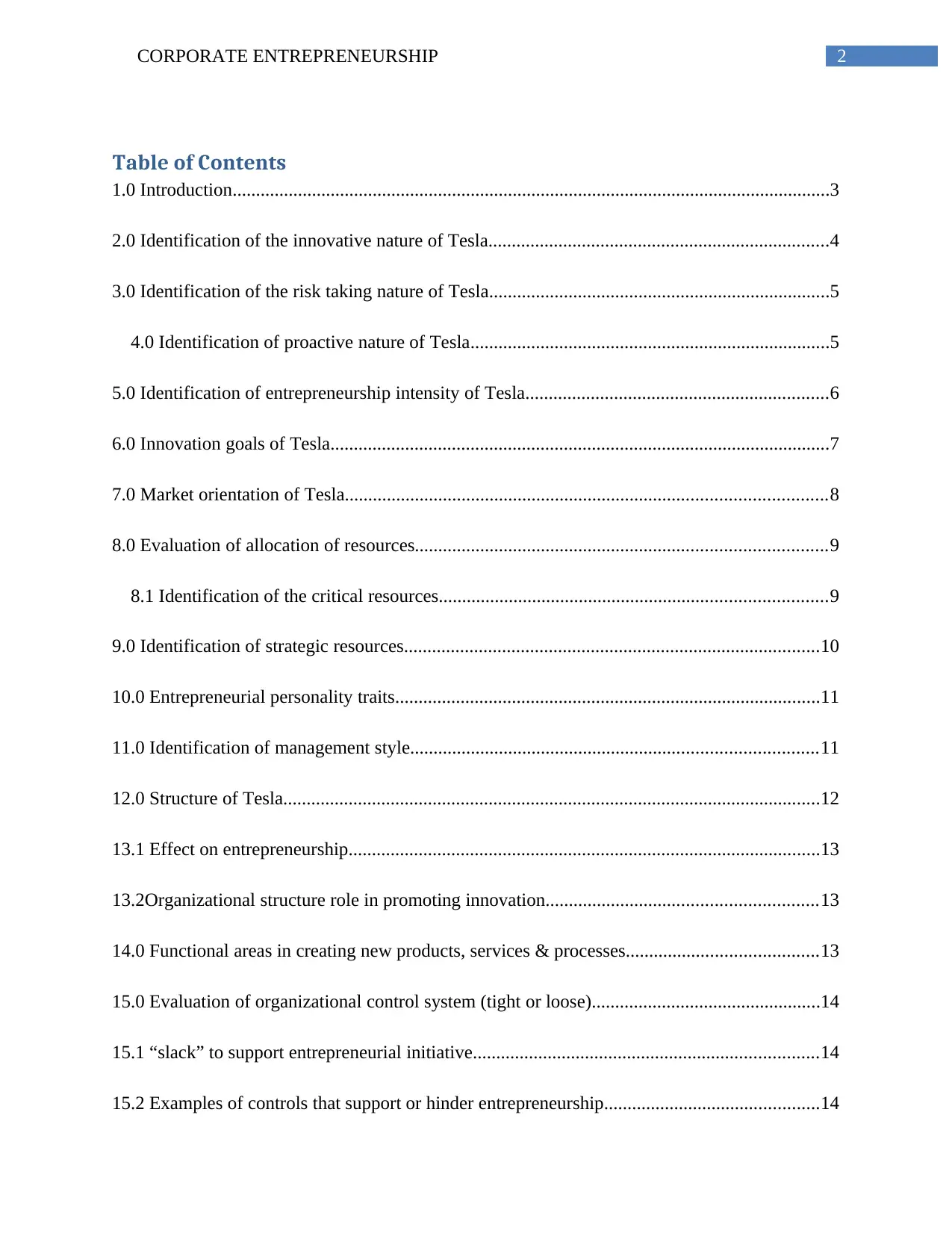
2CORPORATE ENTREPRENEURSHIP
Table of Contents
1.0 Introduction................................................................................................................................3
2.0 Identification of the innovative nature of Tesla.........................................................................4
3.0 Identification of the risk taking nature of Tesla.........................................................................5
4.0 Identification of proactive nature of Tesla.............................................................................5
5.0 Identification of entrepreneurship intensity of Tesla.................................................................6
6.0 Innovation goals of Tesla...........................................................................................................7
7.0 Market orientation of Tesla.......................................................................................................8
8.0 Evaluation of allocation of resources........................................................................................9
8.1 Identification of the critical resources...................................................................................9
9.0 Identification of strategic resources.........................................................................................10
10.0 Entrepreneurial personality traits...........................................................................................11
11.0 Identification of management style.......................................................................................11
12.0 Structure of Tesla...................................................................................................................12
13.1 Effect on entrepreneurship.....................................................................................................13
13.2Organizational structure role in promoting innovation..........................................................13
14.0 Functional areas in creating new products, services & processes.........................................13
15.0 Evaluation of organizational control system (tight or loose).................................................14
15.1 “slack” to support entrepreneurial initiative..........................................................................14
15.2 Examples of controls that support or hinder entrepreneurship..............................................14
Table of Contents
1.0 Introduction................................................................................................................................3
2.0 Identification of the innovative nature of Tesla.........................................................................4
3.0 Identification of the risk taking nature of Tesla.........................................................................5
4.0 Identification of proactive nature of Tesla.............................................................................5
5.0 Identification of entrepreneurship intensity of Tesla.................................................................6
6.0 Innovation goals of Tesla...........................................................................................................7
7.0 Market orientation of Tesla.......................................................................................................8
8.0 Evaluation of allocation of resources........................................................................................9
8.1 Identification of the critical resources...................................................................................9
9.0 Identification of strategic resources.........................................................................................10
10.0 Entrepreneurial personality traits...........................................................................................11
11.0 Identification of management style.......................................................................................11
12.0 Structure of Tesla...................................................................................................................12
13.1 Effect on entrepreneurship.....................................................................................................13
13.2Organizational structure role in promoting innovation..........................................................13
14.0 Functional areas in creating new products, services & processes.........................................13
15.0 Evaluation of organizational control system (tight or loose).................................................14
15.1 “slack” to support entrepreneurial initiative..........................................................................14
15.2 Examples of controls that support or hinder entrepreneurship..............................................14
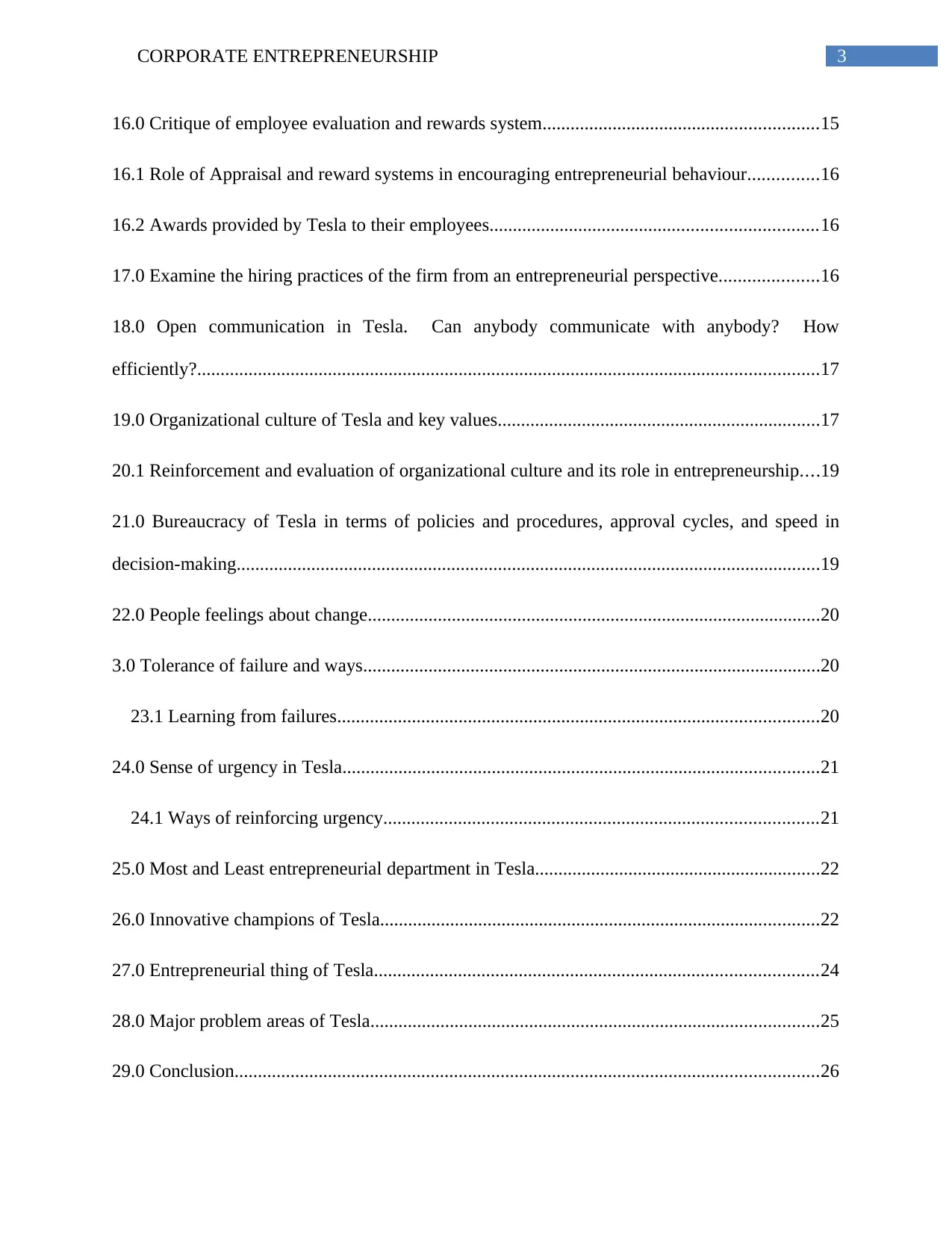
3CORPORATE ENTREPRENEURSHIP
16.0 Critique of employee evaluation and rewards system...........................................................15
16.1 Role of Appraisal and reward systems in encouraging entrepreneurial behaviour...............16
16.2 Awards provided by Tesla to their employees......................................................................16
17.0 Examine the hiring practices of the firm from an entrepreneurial perspective.....................16
18.0 Open communication in Tesla. Can anybody communicate with anybody? How
efficiently?.....................................................................................................................................17
19.0 Organizational culture of Tesla and key values.....................................................................17
20.1 Reinforcement and evaluation of organizational culture and its role in entrepreneurship....19
21.0 Bureaucracy of Tesla in terms of policies and procedures, approval cycles, and speed in
decision-making.............................................................................................................................19
22.0 People feelings about change.................................................................................................20
3.0 Tolerance of failure and ways..................................................................................................20
23.1 Learning from failures.......................................................................................................20
24.0 Sense of urgency in Tesla......................................................................................................21
24.1 Ways of reinforcing urgency.............................................................................................21
25.0 Most and Least entrepreneurial department in Tesla.............................................................22
26.0 Innovative champions of Tesla..............................................................................................22
27.0 Entrepreneurial thing of Tesla...............................................................................................24
28.0 Major problem areas of Tesla................................................................................................25
29.0 Conclusion.............................................................................................................................26
16.0 Critique of employee evaluation and rewards system...........................................................15
16.1 Role of Appraisal and reward systems in encouraging entrepreneurial behaviour...............16
16.2 Awards provided by Tesla to their employees......................................................................16
17.0 Examine the hiring practices of the firm from an entrepreneurial perspective.....................16
18.0 Open communication in Tesla. Can anybody communicate with anybody? How
efficiently?.....................................................................................................................................17
19.0 Organizational culture of Tesla and key values.....................................................................17
20.1 Reinforcement and evaluation of organizational culture and its role in entrepreneurship....19
21.0 Bureaucracy of Tesla in terms of policies and procedures, approval cycles, and speed in
decision-making.............................................................................................................................19
22.0 People feelings about change.................................................................................................20
3.0 Tolerance of failure and ways..................................................................................................20
23.1 Learning from failures.......................................................................................................20
24.0 Sense of urgency in Tesla......................................................................................................21
24.1 Ways of reinforcing urgency.............................................................................................21
25.0 Most and Least entrepreneurial department in Tesla.............................................................22
26.0 Innovative champions of Tesla..............................................................................................22
27.0 Entrepreneurial thing of Tesla...............................................................................................24
28.0 Major problem areas of Tesla................................................................................................25
29.0 Conclusion.............................................................................................................................26
Secure Best Marks with AI Grader
Need help grading? Try our AI Grader for instant feedback on your assignments.
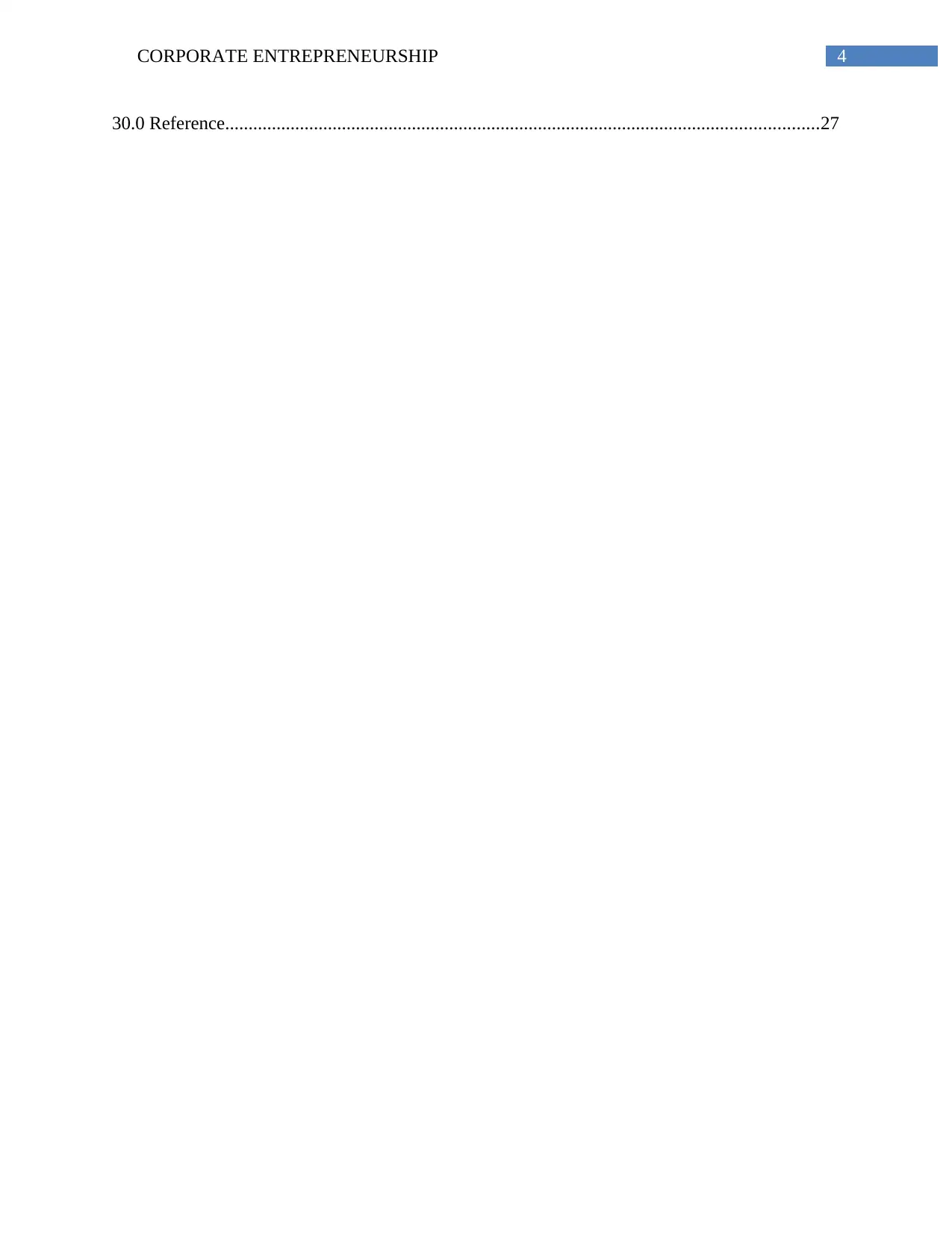
4CORPORATE ENTREPRENEURSHIP
30.0 Reference...............................................................................................................................27
30.0 Reference...............................................................................................................................27
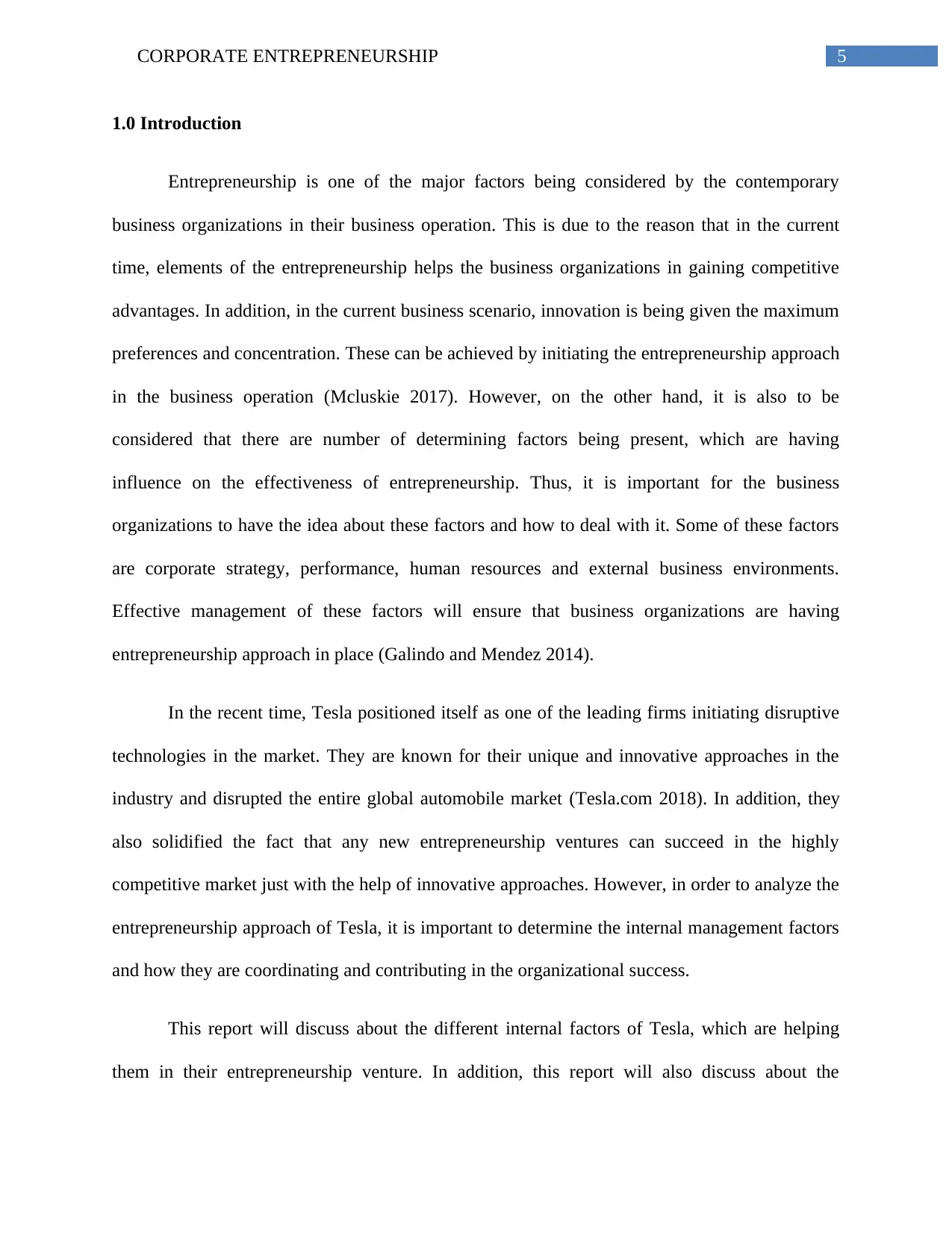
5CORPORATE ENTREPRENEURSHIP
1.0 Introduction
Entrepreneurship is one of the major factors being considered by the contemporary
business organizations in their business operation. This is due to the reason that in the current
time, elements of the entrepreneurship helps the business organizations in gaining competitive
advantages. In addition, in the current business scenario, innovation is being given the maximum
preferences and concentration. These can be achieved by initiating the entrepreneurship approach
in the business operation (Mcluskie 2017). However, on the other hand, it is also to be
considered that there are number of determining factors being present, which are having
influence on the effectiveness of entrepreneurship. Thus, it is important for the business
organizations to have the idea about these factors and how to deal with it. Some of these factors
are corporate strategy, performance, human resources and external business environments.
Effective management of these factors will ensure that business organizations are having
entrepreneurship approach in place (Galindo and Mendez 2014).
In the recent time, Tesla positioned itself as one of the leading firms initiating disruptive
technologies in the market. They are known for their unique and innovative approaches in the
industry and disrupted the entire global automobile market (Tesla.com 2018). In addition, they
also solidified the fact that any new entrepreneurship ventures can succeed in the highly
competitive market just with the help of innovative approaches. However, in order to analyze the
entrepreneurship approach of Tesla, it is important to determine the internal management factors
and how they are coordinating and contributing in the organizational success.
This report will discuss about the different internal factors of Tesla, which are helping
them in their entrepreneurship venture. In addition, this report will also discuss about the
1.0 Introduction
Entrepreneurship is one of the major factors being considered by the contemporary
business organizations in their business operation. This is due to the reason that in the current
time, elements of the entrepreneurship helps the business organizations in gaining competitive
advantages. In addition, in the current business scenario, innovation is being given the maximum
preferences and concentration. These can be achieved by initiating the entrepreneurship approach
in the business operation (Mcluskie 2017). However, on the other hand, it is also to be
considered that there are number of determining factors being present, which are having
influence on the effectiveness of entrepreneurship. Thus, it is important for the business
organizations to have the idea about these factors and how to deal with it. Some of these factors
are corporate strategy, performance, human resources and external business environments.
Effective management of these factors will ensure that business organizations are having
entrepreneurship approach in place (Galindo and Mendez 2014).
In the recent time, Tesla positioned itself as one of the leading firms initiating disruptive
technologies in the market. They are known for their unique and innovative approaches in the
industry and disrupted the entire global automobile market (Tesla.com 2018). In addition, they
also solidified the fact that any new entrepreneurship ventures can succeed in the highly
competitive market just with the help of innovative approaches. However, in order to analyze the
entrepreneurship approach of Tesla, it is important to determine the internal management factors
and how they are coordinating and contributing in the organizational success.
This report will discuss about the different internal factors of Tesla, which are helping
them in their entrepreneurship venture. In addition, this report will also discuss about the
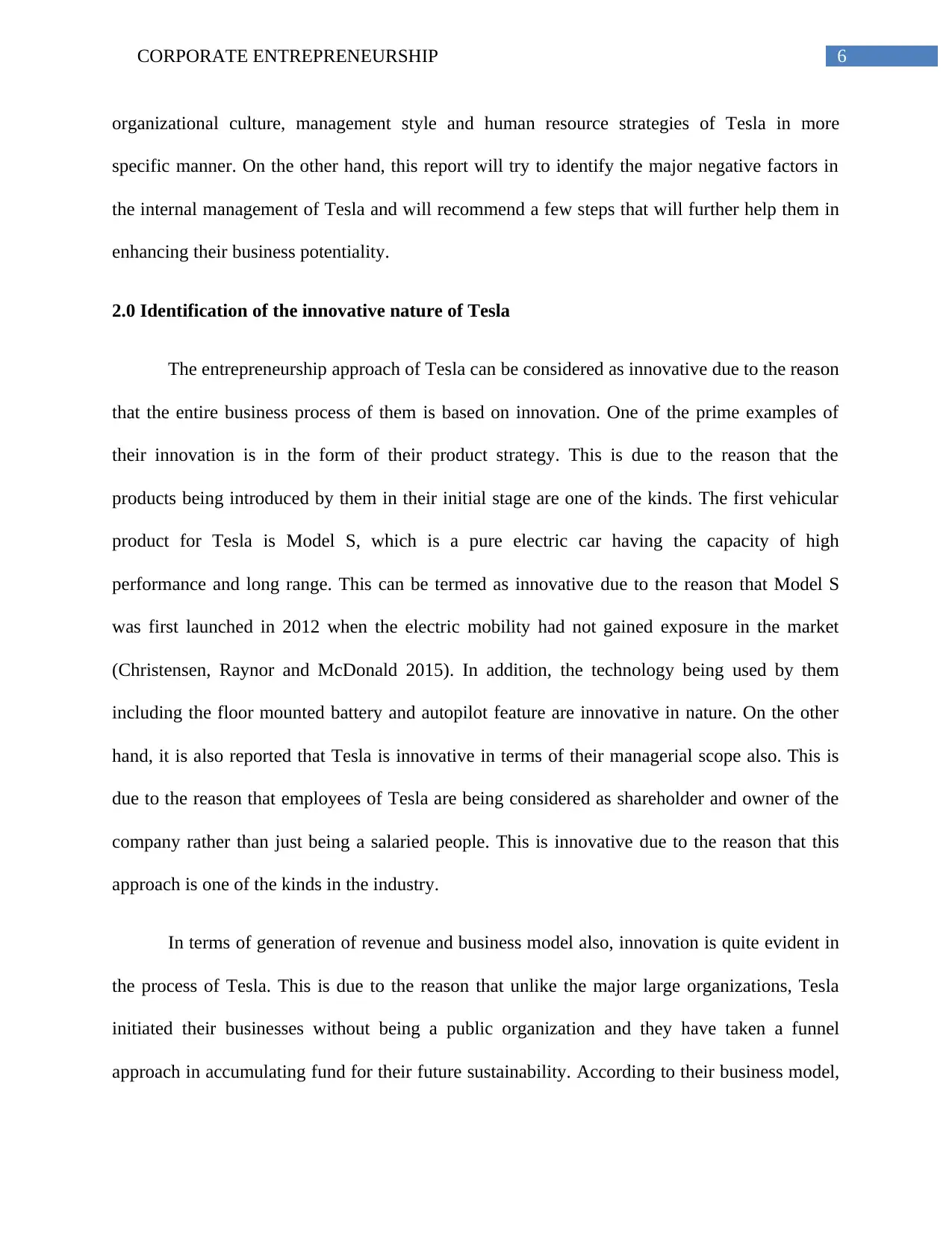
6CORPORATE ENTREPRENEURSHIP
organizational culture, management style and human resource strategies of Tesla in more
specific manner. On the other hand, this report will try to identify the major negative factors in
the internal management of Tesla and will recommend a few steps that will further help them in
enhancing their business potentiality.
2.0 Identification of the innovative nature of Tesla
The entrepreneurship approach of Tesla can be considered as innovative due to the reason
that the entire business process of them is based on innovation. One of the prime examples of
their innovation is in the form of their product strategy. This is due to the reason that the
products being introduced by them in their initial stage are one of the kinds. The first vehicular
product for Tesla is Model S, which is a pure electric car having the capacity of high
performance and long range. This can be termed as innovative due to the reason that Model S
was first launched in 2012 when the electric mobility had not gained exposure in the market
(Christensen, Raynor and McDonald 2015). In addition, the technology being used by them
including the floor mounted battery and autopilot feature are innovative in nature. On the other
hand, it is also reported that Tesla is innovative in terms of their managerial scope also. This is
due to the reason that employees of Tesla are being considered as shareholder and owner of the
company rather than just being a salaried people. This is innovative due to the reason that this
approach is one of the kinds in the industry.
In terms of generation of revenue and business model also, innovation is quite evident in
the process of Tesla. This is due to the reason that unlike the major large organizations, Tesla
initiated their businesses without being a public organization and they have taken a funnel
approach in accumulating fund for their future sustainability. According to their business model,
organizational culture, management style and human resource strategies of Tesla in more
specific manner. On the other hand, this report will try to identify the major negative factors in
the internal management of Tesla and will recommend a few steps that will further help them in
enhancing their business potentiality.
2.0 Identification of the innovative nature of Tesla
The entrepreneurship approach of Tesla can be considered as innovative due to the reason
that the entire business process of them is based on innovation. One of the prime examples of
their innovation is in the form of their product strategy. This is due to the reason that the
products being introduced by them in their initial stage are one of the kinds. The first vehicular
product for Tesla is Model S, which is a pure electric car having the capacity of high
performance and long range. This can be termed as innovative due to the reason that Model S
was first launched in 2012 when the electric mobility had not gained exposure in the market
(Christensen, Raynor and McDonald 2015). In addition, the technology being used by them
including the floor mounted battery and autopilot feature are innovative in nature. On the other
hand, it is also reported that Tesla is innovative in terms of their managerial scope also. This is
due to the reason that employees of Tesla are being considered as shareholder and owner of the
company rather than just being a salaried people. This is innovative due to the reason that this
approach is one of the kinds in the industry.
In terms of generation of revenue and business model also, innovation is quite evident in
the process of Tesla. This is due to the reason that unlike the major large organizations, Tesla
initiated their businesses without being a public organization and they have taken a funnel
approach in accumulating fund for their future sustainability. According to their business model,
Paraphrase This Document
Need a fresh take? Get an instant paraphrase of this document with our AI Paraphraser
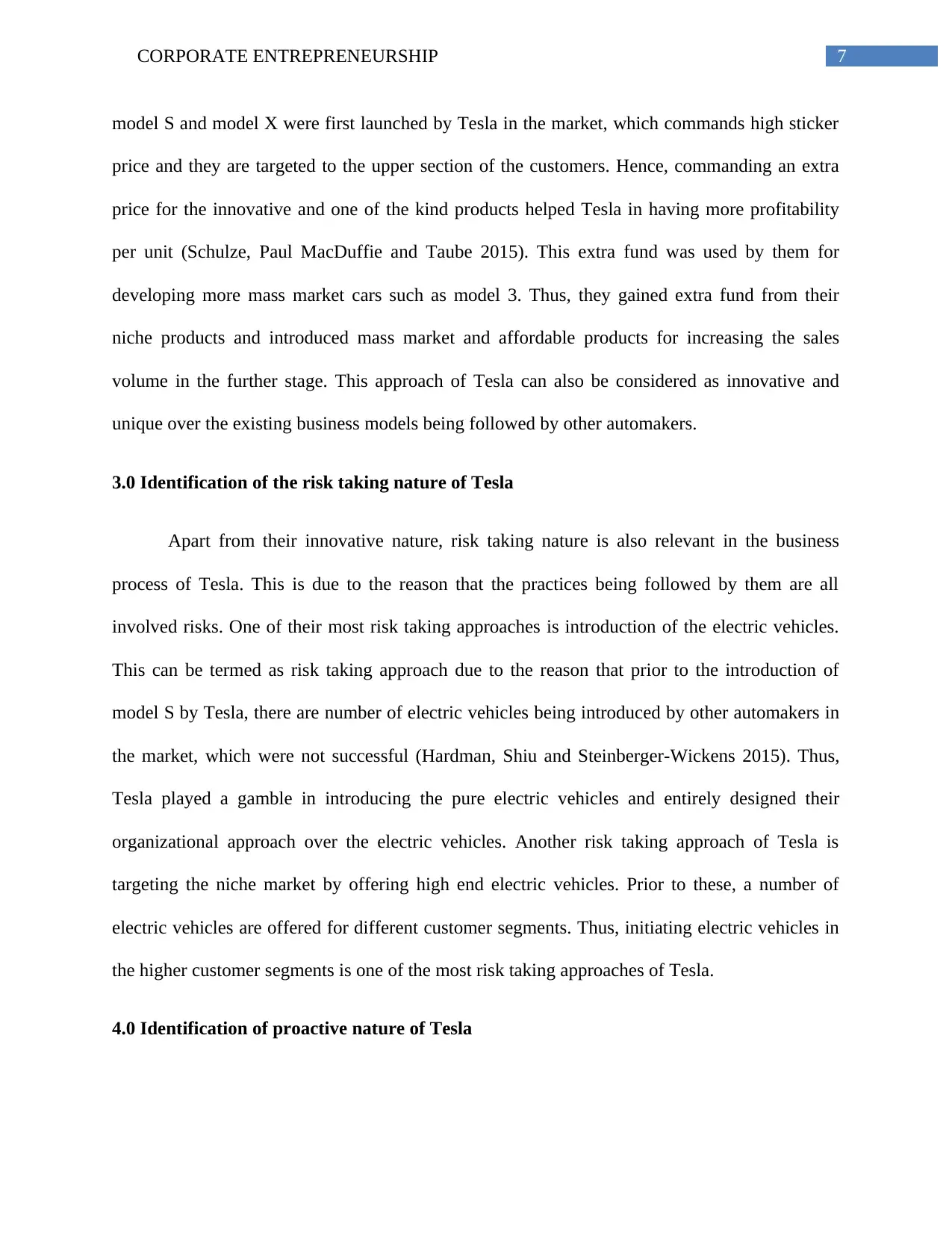
7CORPORATE ENTREPRENEURSHIP
model S and model X were first launched by Tesla in the market, which commands high sticker
price and they are targeted to the upper section of the customers. Hence, commanding an extra
price for the innovative and one of the kind products helped Tesla in having more profitability
per unit (Schulze, Paul MacDuffie and Taube 2015). This extra fund was used by them for
developing more mass market cars such as model 3. Thus, they gained extra fund from their
niche products and introduced mass market and affordable products for increasing the sales
volume in the further stage. This approach of Tesla can also be considered as innovative and
unique over the existing business models being followed by other automakers.
3.0 Identification of the risk taking nature of Tesla
Apart from their innovative nature, risk taking nature is also relevant in the business
process of Tesla. This is due to the reason that the practices being followed by them are all
involved risks. One of their most risk taking approaches is introduction of the electric vehicles.
This can be termed as risk taking approach due to the reason that prior to the introduction of
model S by Tesla, there are number of electric vehicles being introduced by other automakers in
the market, which were not successful (Hardman, Shiu and Steinberger-Wickens 2015). Thus,
Tesla played a gamble in introducing the pure electric vehicles and entirely designed their
organizational approach over the electric vehicles. Another risk taking approach of Tesla is
targeting the niche market by offering high end electric vehicles. Prior to these, a number of
electric vehicles are offered for different customer segments. Thus, initiating electric vehicles in
the higher customer segments is one of the most risk taking approaches of Tesla.
4.0 Identification of proactive nature of Tesla
model S and model X were first launched by Tesla in the market, which commands high sticker
price and they are targeted to the upper section of the customers. Hence, commanding an extra
price for the innovative and one of the kind products helped Tesla in having more profitability
per unit (Schulze, Paul MacDuffie and Taube 2015). This extra fund was used by them for
developing more mass market cars such as model 3. Thus, they gained extra fund from their
niche products and introduced mass market and affordable products for increasing the sales
volume in the further stage. This approach of Tesla can also be considered as innovative and
unique over the existing business models being followed by other automakers.
3.0 Identification of the risk taking nature of Tesla
Apart from their innovative nature, risk taking nature is also relevant in the business
process of Tesla. This is due to the reason that the practices being followed by them are all
involved risks. One of their most risk taking approaches is introduction of the electric vehicles.
This can be termed as risk taking approach due to the reason that prior to the introduction of
model S by Tesla, there are number of electric vehicles being introduced by other automakers in
the market, which were not successful (Hardman, Shiu and Steinberger-Wickens 2015). Thus,
Tesla played a gamble in introducing the pure electric vehicles and entirely designed their
organizational approach over the electric vehicles. Another risk taking approach of Tesla is
targeting the niche market by offering high end electric vehicles. Prior to these, a number of
electric vehicles are offered for different customer segments. Thus, initiating electric vehicles in
the higher customer segments is one of the most risk taking approaches of Tesla.
4.0 Identification of proactive nature of Tesla
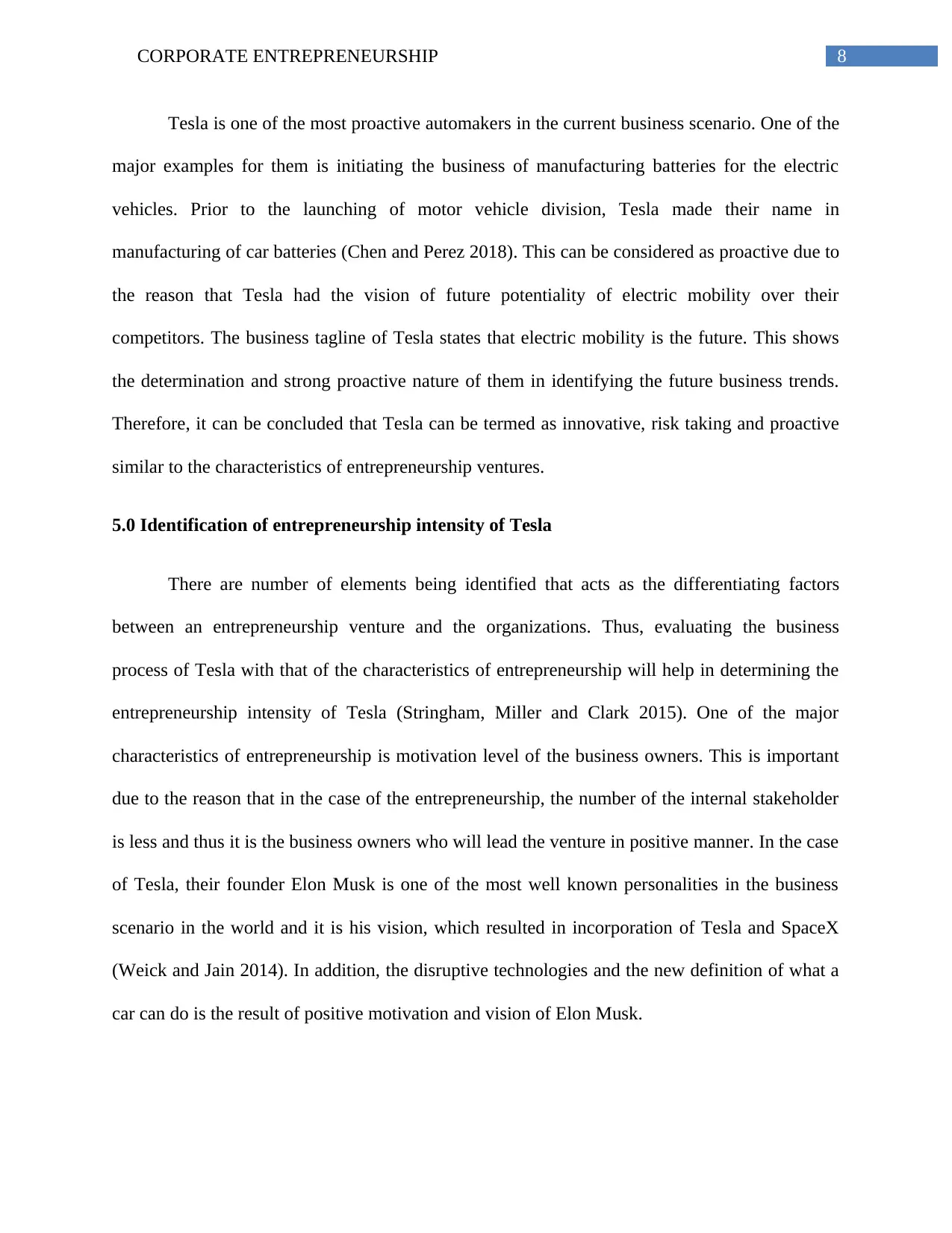
8CORPORATE ENTREPRENEURSHIP
Tesla is one of the most proactive automakers in the current business scenario. One of the
major examples for them is initiating the business of manufacturing batteries for the electric
vehicles. Prior to the launching of motor vehicle division, Tesla made their name in
manufacturing of car batteries (Chen and Perez 2018). This can be considered as proactive due to
the reason that Tesla had the vision of future potentiality of electric mobility over their
competitors. The business tagline of Tesla states that electric mobility is the future. This shows
the determination and strong proactive nature of them in identifying the future business trends.
Therefore, it can be concluded that Tesla can be termed as innovative, risk taking and proactive
similar to the characteristics of entrepreneurship ventures.
5.0 Identification of entrepreneurship intensity of Tesla
There are number of elements being identified that acts as the differentiating factors
between an entrepreneurship venture and the organizations. Thus, evaluating the business
process of Tesla with that of the characteristics of entrepreneurship will help in determining the
entrepreneurship intensity of Tesla (Stringham, Miller and Clark 2015). One of the major
characteristics of entrepreneurship is motivation level of the business owners. This is important
due to the reason that in the case of the entrepreneurship, the number of the internal stakeholder
is less and thus it is the business owners who will lead the venture in positive manner. In the case
of Tesla, their founder Elon Musk is one of the most well known personalities in the business
scenario in the world and it is his vision, which resulted in incorporation of Tesla and SpaceX
(Weick and Jain 2014). In addition, the disruptive technologies and the new definition of what a
car can do is the result of positive motivation and vision of Elon Musk.
Tesla is one of the most proactive automakers in the current business scenario. One of the
major examples for them is initiating the business of manufacturing batteries for the electric
vehicles. Prior to the launching of motor vehicle division, Tesla made their name in
manufacturing of car batteries (Chen and Perez 2018). This can be considered as proactive due to
the reason that Tesla had the vision of future potentiality of electric mobility over their
competitors. The business tagline of Tesla states that electric mobility is the future. This shows
the determination and strong proactive nature of them in identifying the future business trends.
Therefore, it can be concluded that Tesla can be termed as innovative, risk taking and proactive
similar to the characteristics of entrepreneurship ventures.
5.0 Identification of entrepreneurship intensity of Tesla
There are number of elements being identified that acts as the differentiating factors
between an entrepreneurship venture and the organizations. Thus, evaluating the business
process of Tesla with that of the characteristics of entrepreneurship will help in determining the
entrepreneurship intensity of Tesla (Stringham, Miller and Clark 2015). One of the major
characteristics of entrepreneurship is motivation level of the business owners. This is important
due to the reason that in the case of the entrepreneurship, the number of the internal stakeholder
is less and thus it is the business owners who will lead the venture in positive manner. In the case
of Tesla, their founder Elon Musk is one of the most well known personalities in the business
scenario in the world and it is his vision, which resulted in incorporation of Tesla and SpaceX
(Weick and Jain 2014). In addition, the disruptive technologies and the new definition of what a
car can do is the result of positive motivation and vision of Elon Musk.
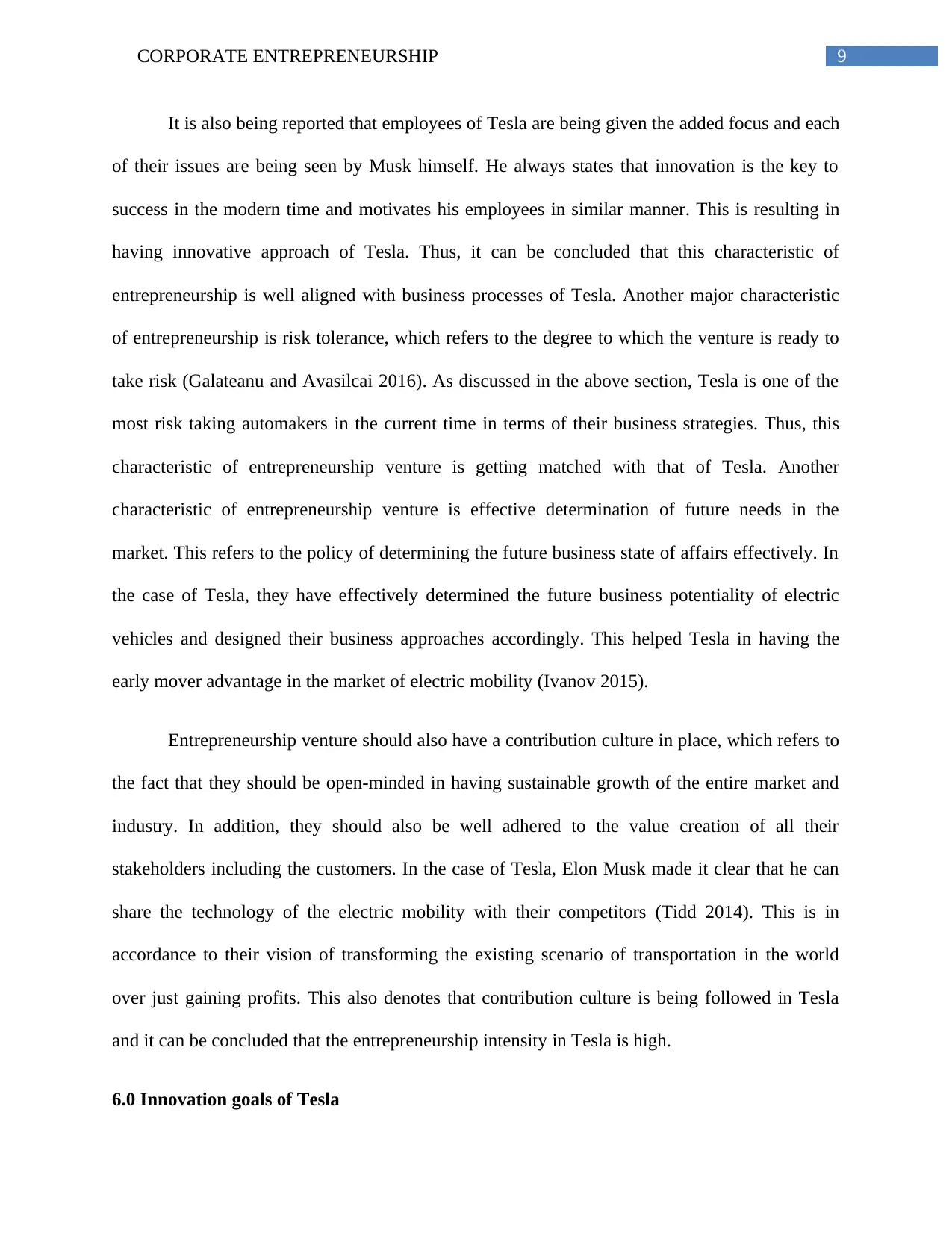
9CORPORATE ENTREPRENEURSHIP
It is also being reported that employees of Tesla are being given the added focus and each
of their issues are being seen by Musk himself. He always states that innovation is the key to
success in the modern time and motivates his employees in similar manner. This is resulting in
having innovative approach of Tesla. Thus, it can be concluded that this characteristic of
entrepreneurship is well aligned with business processes of Tesla. Another major characteristic
of entrepreneurship is risk tolerance, which refers to the degree to which the venture is ready to
take risk (Galateanu and Avasilcai 2016). As discussed in the above section, Tesla is one of the
most risk taking automakers in the current time in terms of their business strategies. Thus, this
characteristic of entrepreneurship venture is getting matched with that of Tesla. Another
characteristic of entrepreneurship venture is effective determination of future needs in the
market. This refers to the policy of determining the future business state of affairs effectively. In
the case of Tesla, they have effectively determined the future business potentiality of electric
vehicles and designed their business approaches accordingly. This helped Tesla in having the
early mover advantage in the market of electric mobility (Ivanov 2015).
Entrepreneurship venture should also have a contribution culture in place, which refers to
the fact that they should be open-minded in having sustainable growth of the entire market and
industry. In addition, they should also be well adhered to the value creation of all their
stakeholders including the customers. In the case of Tesla, Elon Musk made it clear that he can
share the technology of the electric mobility with their competitors (Tidd 2014). This is in
accordance to their vision of transforming the existing scenario of transportation in the world
over just gaining profits. This also denotes that contribution culture is being followed in Tesla
and it can be concluded that the entrepreneurship intensity in Tesla is high.
6.0 Innovation goals of Tesla
It is also being reported that employees of Tesla are being given the added focus and each
of their issues are being seen by Musk himself. He always states that innovation is the key to
success in the modern time and motivates his employees in similar manner. This is resulting in
having innovative approach of Tesla. Thus, it can be concluded that this characteristic of
entrepreneurship is well aligned with business processes of Tesla. Another major characteristic
of entrepreneurship is risk tolerance, which refers to the degree to which the venture is ready to
take risk (Galateanu and Avasilcai 2016). As discussed in the above section, Tesla is one of the
most risk taking automakers in the current time in terms of their business strategies. Thus, this
characteristic of entrepreneurship venture is getting matched with that of Tesla. Another
characteristic of entrepreneurship venture is effective determination of future needs in the
market. This refers to the policy of determining the future business state of affairs effectively. In
the case of Tesla, they have effectively determined the future business potentiality of electric
vehicles and designed their business approaches accordingly. This helped Tesla in having the
early mover advantage in the market of electric mobility (Ivanov 2015).
Entrepreneurship venture should also have a contribution culture in place, which refers to
the fact that they should be open-minded in having sustainable growth of the entire market and
industry. In addition, they should also be well adhered to the value creation of all their
stakeholders including the customers. In the case of Tesla, Elon Musk made it clear that he can
share the technology of the electric mobility with their competitors (Tidd 2014). This is in
accordance to their vision of transforming the existing scenario of transportation in the world
over just gaining profits. This also denotes that contribution culture is being followed in Tesla
and it can be concluded that the entrepreneurship intensity in Tesla is high.
6.0 Innovation goals of Tesla
Secure Best Marks with AI Grader
Need help grading? Try our AI Grader for instant feedback on your assignments.
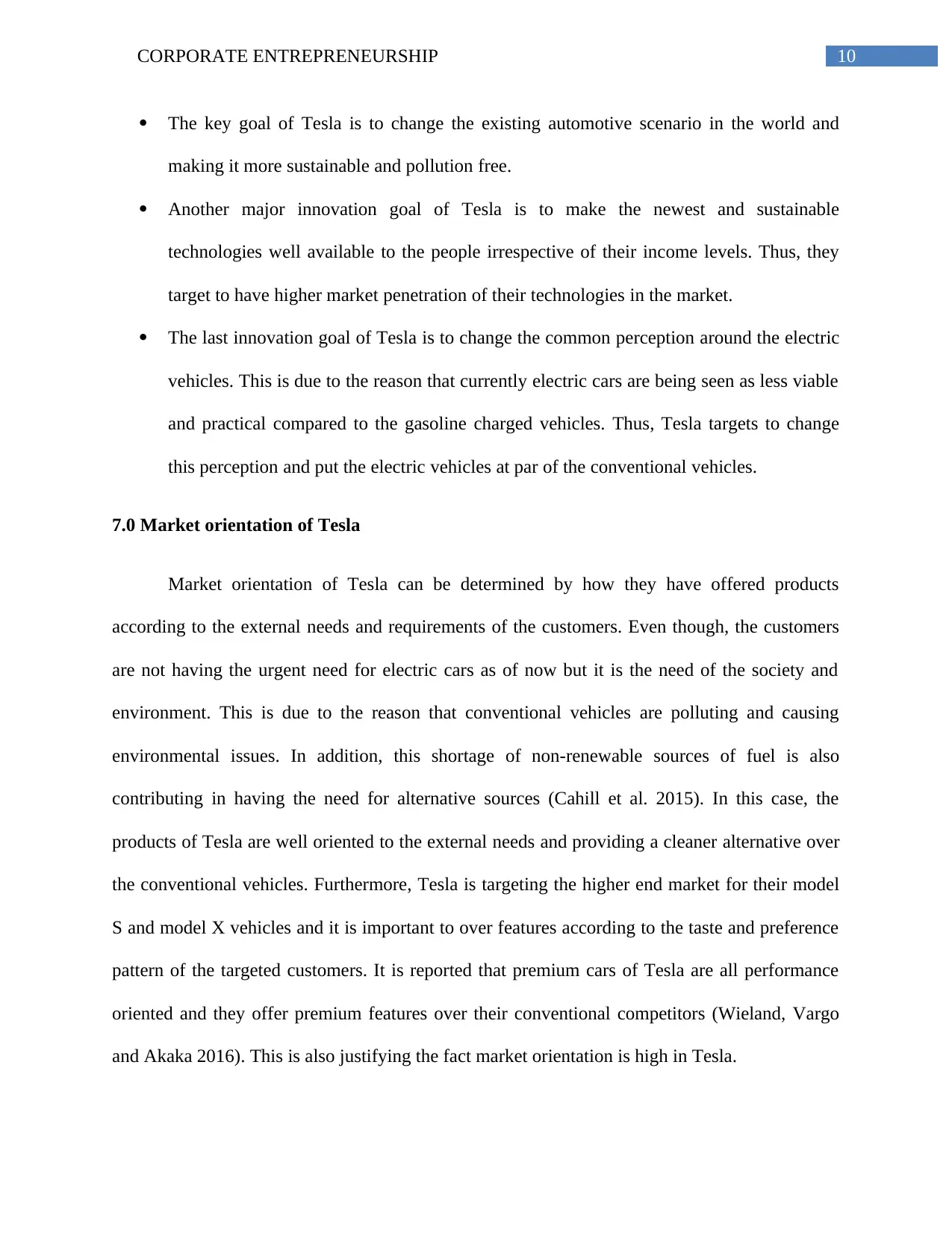
10CORPORATE ENTREPRENEURSHIP
The key goal of Tesla is to change the existing automotive scenario in the world and
making it more sustainable and pollution free.
Another major innovation goal of Tesla is to make the newest and sustainable
technologies well available to the people irrespective of their income levels. Thus, they
target to have higher market penetration of their technologies in the market.
The last innovation goal of Tesla is to change the common perception around the electric
vehicles. This is due to the reason that currently electric cars are being seen as less viable
and practical compared to the gasoline charged vehicles. Thus, Tesla targets to change
this perception and put the electric vehicles at par of the conventional vehicles.
7.0 Market orientation of Tesla
Market orientation of Tesla can be determined by how they have offered products
according to the external needs and requirements of the customers. Even though, the customers
are not having the urgent need for electric cars as of now but it is the need of the society and
environment. This is due to the reason that conventional vehicles are polluting and causing
environmental issues. In addition, this shortage of non-renewable sources of fuel is also
contributing in having the need for alternative sources (Cahill et al. 2015). In this case, the
products of Tesla are well oriented to the external needs and providing a cleaner alternative over
the conventional vehicles. Furthermore, Tesla is targeting the higher end market for their model
S and model X vehicles and it is important to over features according to the taste and preference
pattern of the targeted customers. It is reported that premium cars of Tesla are all performance
oriented and they offer premium features over their conventional competitors (Wieland, Vargo
and Akaka 2016). This is also justifying the fact market orientation is high in Tesla.
The key goal of Tesla is to change the existing automotive scenario in the world and
making it more sustainable and pollution free.
Another major innovation goal of Tesla is to make the newest and sustainable
technologies well available to the people irrespective of their income levels. Thus, they
target to have higher market penetration of their technologies in the market.
The last innovation goal of Tesla is to change the common perception around the electric
vehicles. This is due to the reason that currently electric cars are being seen as less viable
and practical compared to the gasoline charged vehicles. Thus, Tesla targets to change
this perception and put the electric vehicles at par of the conventional vehicles.
7.0 Market orientation of Tesla
Market orientation of Tesla can be determined by how they have offered products
according to the external needs and requirements of the customers. Even though, the customers
are not having the urgent need for electric cars as of now but it is the need of the society and
environment. This is due to the reason that conventional vehicles are polluting and causing
environmental issues. In addition, this shortage of non-renewable sources of fuel is also
contributing in having the need for alternative sources (Cahill et al. 2015). In this case, the
products of Tesla are well oriented to the external needs and providing a cleaner alternative over
the conventional vehicles. Furthermore, Tesla is targeting the higher end market for their model
S and model X vehicles and it is important to over features according to the taste and preference
pattern of the targeted customers. It is reported that premium cars of Tesla are all performance
oriented and they offer premium features over their conventional competitors (Wieland, Vargo
and Akaka 2016). This is also justifying the fact market orientation is high in Tesla.
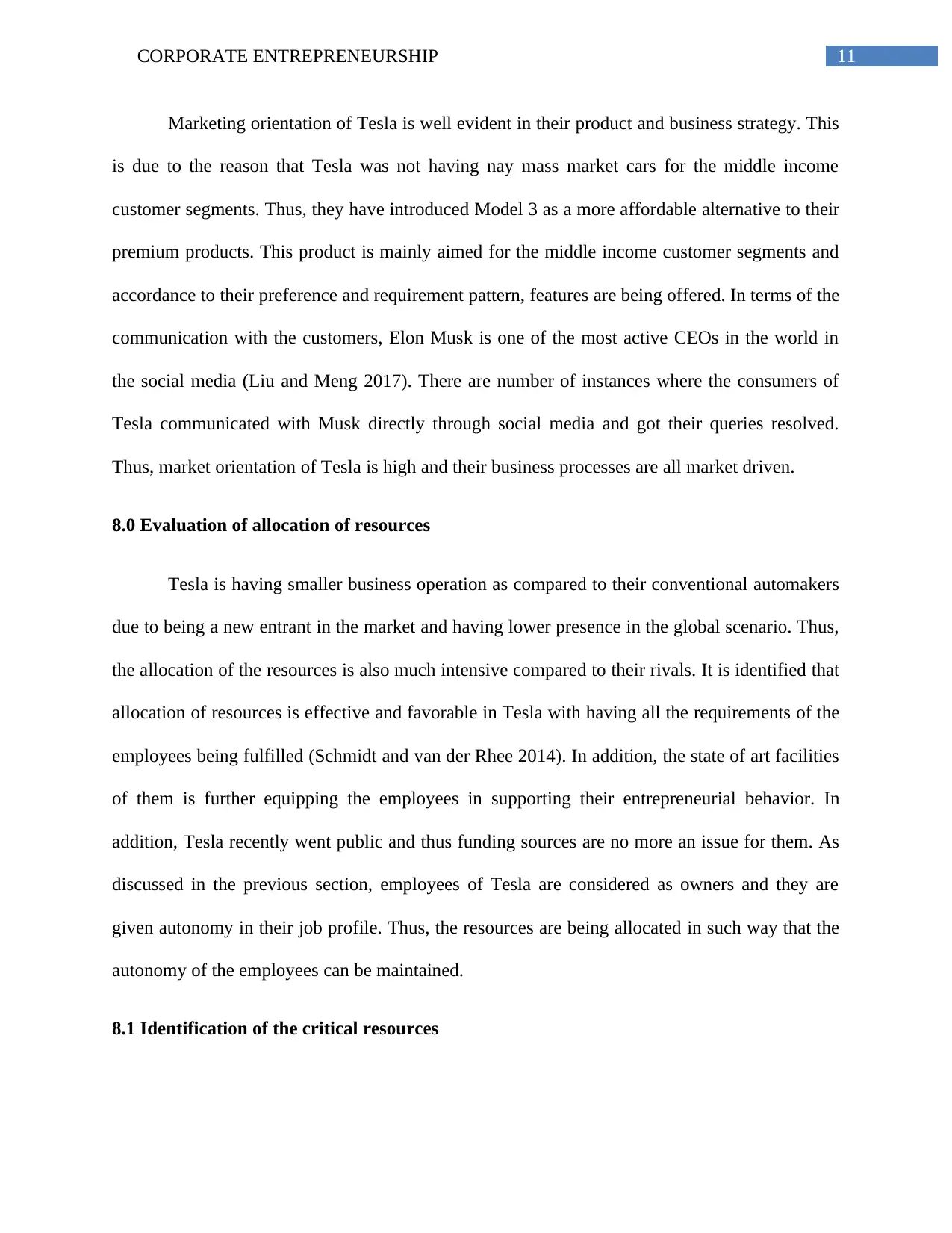
11CORPORATE ENTREPRENEURSHIP
Marketing orientation of Tesla is well evident in their product and business strategy. This
is due to the reason that Tesla was not having nay mass market cars for the middle income
customer segments. Thus, they have introduced Model 3 as a more affordable alternative to their
premium products. This product is mainly aimed for the middle income customer segments and
accordance to their preference and requirement pattern, features are being offered. In terms of the
communication with the customers, Elon Musk is one of the most active CEOs in the world in
the social media (Liu and Meng 2017). There are number of instances where the consumers of
Tesla communicated with Musk directly through social media and got their queries resolved.
Thus, market orientation of Tesla is high and their business processes are all market driven.
8.0 Evaluation of allocation of resources
Tesla is having smaller business operation as compared to their conventional automakers
due to being a new entrant in the market and having lower presence in the global scenario. Thus,
the allocation of the resources is also much intensive compared to their rivals. It is identified that
allocation of resources is effective and favorable in Tesla with having all the requirements of the
employees being fulfilled (Schmidt and van der Rhee 2014). In addition, the state of art facilities
of them is further equipping the employees in supporting their entrepreneurial behavior. In
addition, Tesla recently went public and thus funding sources are no more an issue for them. As
discussed in the previous section, employees of Tesla are considered as owners and they are
given autonomy in their job profile. Thus, the resources are being allocated in such way that the
autonomy of the employees can be maintained.
8.1 Identification of the critical resources
Marketing orientation of Tesla is well evident in their product and business strategy. This
is due to the reason that Tesla was not having nay mass market cars for the middle income
customer segments. Thus, they have introduced Model 3 as a more affordable alternative to their
premium products. This product is mainly aimed for the middle income customer segments and
accordance to their preference and requirement pattern, features are being offered. In terms of the
communication with the customers, Elon Musk is one of the most active CEOs in the world in
the social media (Liu and Meng 2017). There are number of instances where the consumers of
Tesla communicated with Musk directly through social media and got their queries resolved.
Thus, market orientation of Tesla is high and their business processes are all market driven.
8.0 Evaluation of allocation of resources
Tesla is having smaller business operation as compared to their conventional automakers
due to being a new entrant in the market and having lower presence in the global scenario. Thus,
the allocation of the resources is also much intensive compared to their rivals. It is identified that
allocation of resources is effective and favorable in Tesla with having all the requirements of the
employees being fulfilled (Schmidt and van der Rhee 2014). In addition, the state of art facilities
of them is further equipping the employees in supporting their entrepreneurial behavior. In
addition, Tesla recently went public and thus funding sources are no more an issue for them. As
discussed in the previous section, employees of Tesla are considered as owners and they are
given autonomy in their job profile. Thus, the resources are being allocated in such way that the
autonomy of the employees can be maintained.
8.1 Identification of the critical resources
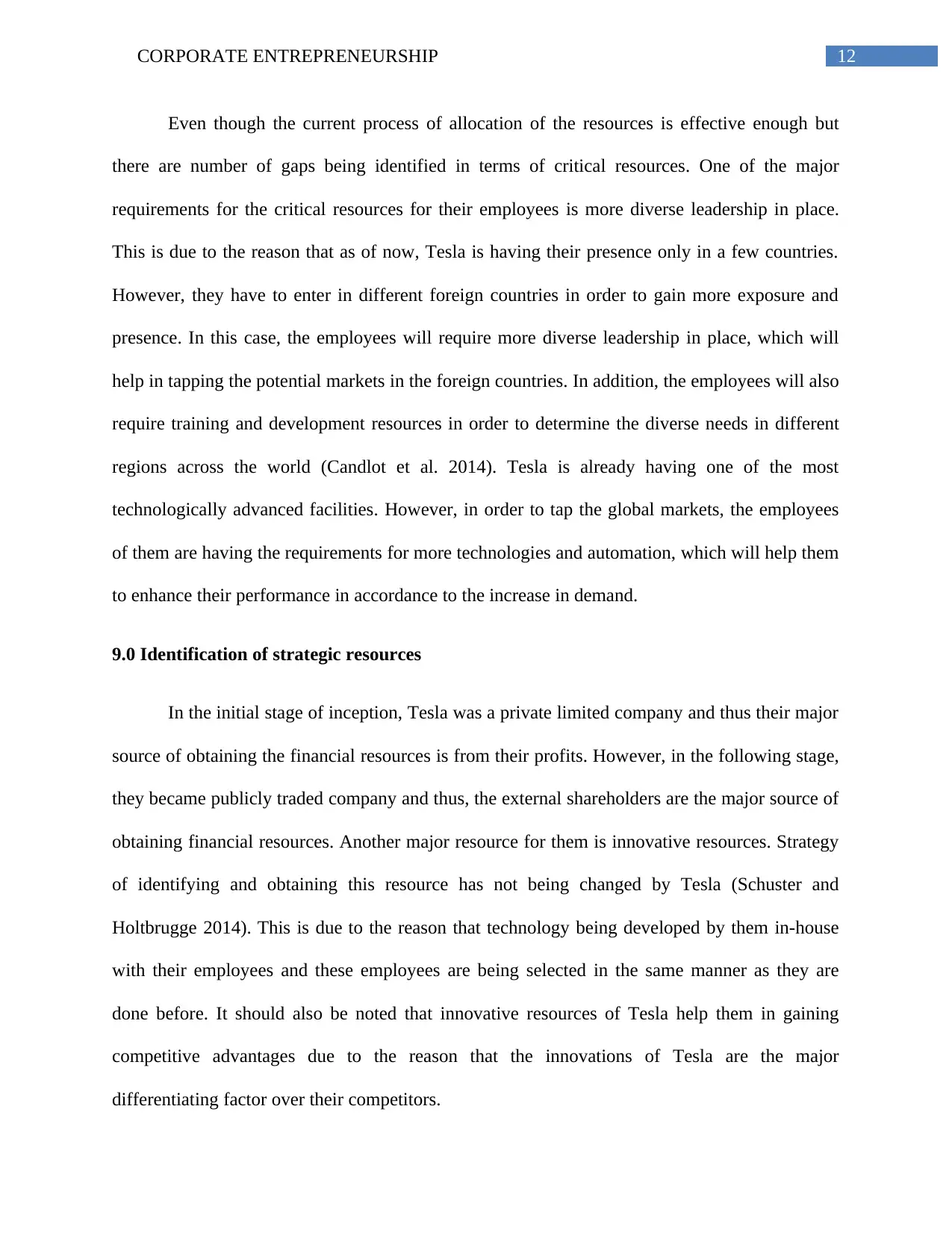
12CORPORATE ENTREPRENEURSHIP
Even though the current process of allocation of the resources is effective enough but
there are number of gaps being identified in terms of critical resources. One of the major
requirements for the critical resources for their employees is more diverse leadership in place.
This is due to the reason that as of now, Tesla is having their presence only in a few countries.
However, they have to enter in different foreign countries in order to gain more exposure and
presence. In this case, the employees will require more diverse leadership in place, which will
help in tapping the potential markets in the foreign countries. In addition, the employees will also
require training and development resources in order to determine the diverse needs in different
regions across the world (Candlot et al. 2014). Tesla is already having one of the most
technologically advanced facilities. However, in order to tap the global markets, the employees
of them are having the requirements for more technologies and automation, which will help them
to enhance their performance in accordance to the increase in demand.
9.0 Identification of strategic resources
In the initial stage of inception, Tesla was a private limited company and thus their major
source of obtaining the financial resources is from their profits. However, in the following stage,
they became publicly traded company and thus, the external shareholders are the major source of
obtaining financial resources. Another major resource for them is innovative resources. Strategy
of identifying and obtaining this resource has not being changed by Tesla (Schuster and
Holtbrugge 2014). This is due to the reason that technology being developed by them in-house
with their employees and these employees are being selected in the same manner as they are
done before. It should also be noted that innovative resources of Tesla help them in gaining
competitive advantages due to the reason that the innovations of Tesla are the major
differentiating factor over their competitors.
Even though the current process of allocation of the resources is effective enough but
there are number of gaps being identified in terms of critical resources. One of the major
requirements for the critical resources for their employees is more diverse leadership in place.
This is due to the reason that as of now, Tesla is having their presence only in a few countries.
However, they have to enter in different foreign countries in order to gain more exposure and
presence. In this case, the employees will require more diverse leadership in place, which will
help in tapping the potential markets in the foreign countries. In addition, the employees will also
require training and development resources in order to determine the diverse needs in different
regions across the world (Candlot et al. 2014). Tesla is already having one of the most
technologically advanced facilities. However, in order to tap the global markets, the employees
of them are having the requirements for more technologies and automation, which will help them
to enhance their performance in accordance to the increase in demand.
9.0 Identification of strategic resources
In the initial stage of inception, Tesla was a private limited company and thus their major
source of obtaining the financial resources is from their profits. However, in the following stage,
they became publicly traded company and thus, the external shareholders are the major source of
obtaining financial resources. Another major resource for them is innovative resources. Strategy
of identifying and obtaining this resource has not being changed by Tesla (Schuster and
Holtbrugge 2014). This is due to the reason that technology being developed by them in-house
with their employees and these employees are being selected in the same manner as they are
done before. It should also be noted that innovative resources of Tesla help them in gaining
competitive advantages due to the reason that the innovations of Tesla are the major
differentiating factor over their competitors.
Paraphrase This Document
Need a fresh take? Get an instant paraphrase of this document with our AI Paraphraser
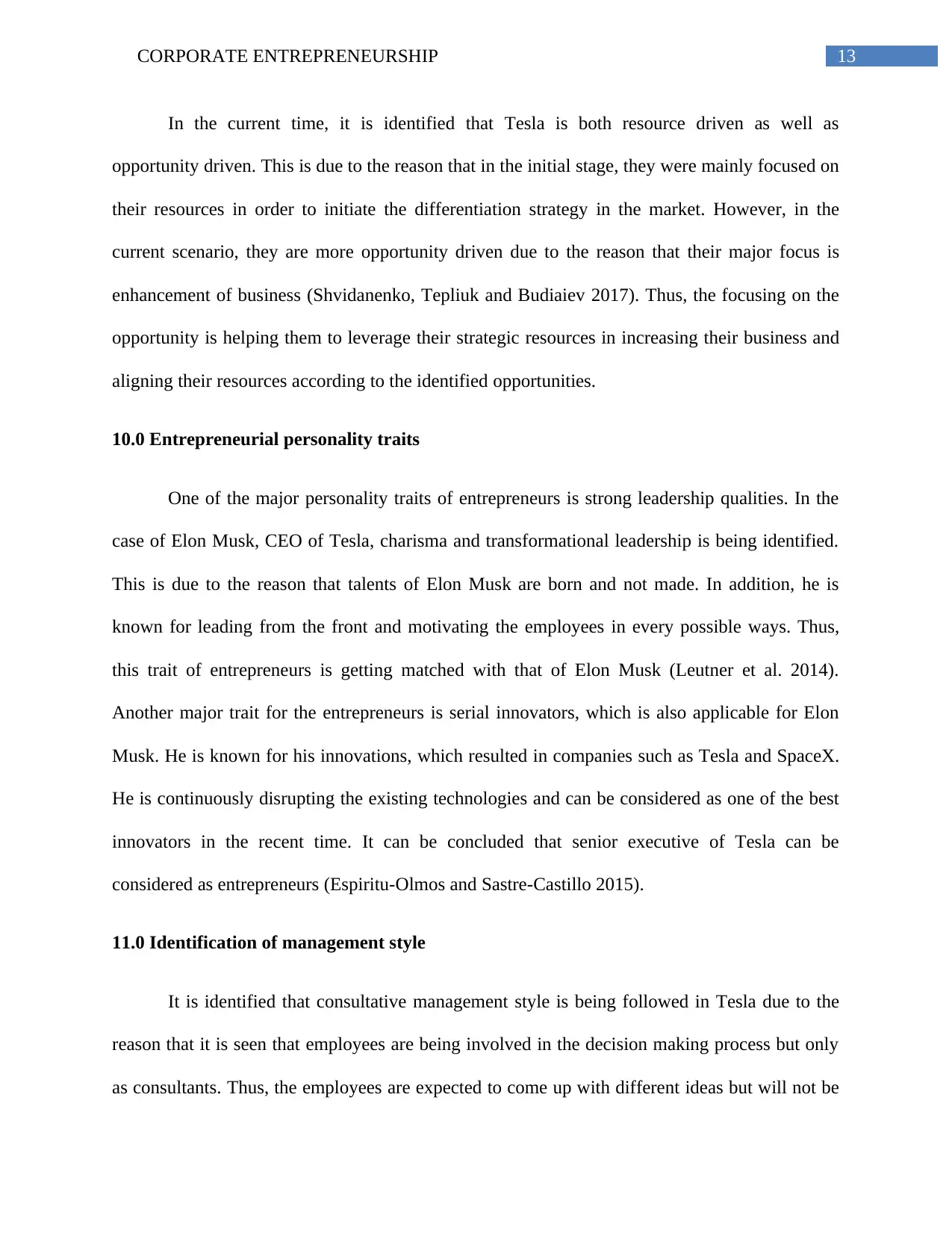
13CORPORATE ENTREPRENEURSHIP
In the current time, it is identified that Tesla is both resource driven as well as
opportunity driven. This is due to the reason that in the initial stage, they were mainly focused on
their resources in order to initiate the differentiation strategy in the market. However, in the
current scenario, they are more opportunity driven due to the reason that their major focus is
enhancement of business (Shvidanenko, Tepliuk and Budiaiev 2017). Thus, the focusing on the
opportunity is helping them to leverage their strategic resources in increasing their business and
aligning their resources according to the identified opportunities.
10.0 Entrepreneurial personality traits
One of the major personality traits of entrepreneurs is strong leadership qualities. In the
case of Elon Musk, CEO of Tesla, charisma and transformational leadership is being identified.
This is due to the reason that talents of Elon Musk are born and not made. In addition, he is
known for leading from the front and motivating the employees in every possible ways. Thus,
this trait of entrepreneurs is getting matched with that of Elon Musk (Leutner et al. 2014).
Another major trait for the entrepreneurs is serial innovators, which is also applicable for Elon
Musk. He is known for his innovations, which resulted in companies such as Tesla and SpaceX.
He is continuously disrupting the existing technologies and can be considered as one of the best
innovators in the recent time. It can be concluded that senior executive of Tesla can be
considered as entrepreneurs (Espiritu-Olmos and Sastre-Castillo 2015).
11.0 Identification of management style
It is identified that consultative management style is being followed in Tesla due to the
reason that it is seen that employees are being involved in the decision making process but only
as consultants. Thus, the employees are expected to come up with different ideas but will not be
In the current time, it is identified that Tesla is both resource driven as well as
opportunity driven. This is due to the reason that in the initial stage, they were mainly focused on
their resources in order to initiate the differentiation strategy in the market. However, in the
current scenario, they are more opportunity driven due to the reason that their major focus is
enhancement of business (Shvidanenko, Tepliuk and Budiaiev 2017). Thus, the focusing on the
opportunity is helping them to leverage their strategic resources in increasing their business and
aligning their resources according to the identified opportunities.
10.0 Entrepreneurial personality traits
One of the major personality traits of entrepreneurs is strong leadership qualities. In the
case of Elon Musk, CEO of Tesla, charisma and transformational leadership is being identified.
This is due to the reason that talents of Elon Musk are born and not made. In addition, he is
known for leading from the front and motivating the employees in every possible ways. Thus,
this trait of entrepreneurs is getting matched with that of Elon Musk (Leutner et al. 2014).
Another major trait for the entrepreneurs is serial innovators, which is also applicable for Elon
Musk. He is known for his innovations, which resulted in companies such as Tesla and SpaceX.
He is continuously disrupting the existing technologies and can be considered as one of the best
innovators in the recent time. It can be concluded that senior executive of Tesla can be
considered as entrepreneurs (Espiritu-Olmos and Sastre-Castillo 2015).
11.0 Identification of management style
It is identified that consultative management style is being followed in Tesla due to the
reason that it is seen that employees are being involved in the decision making process but only
as consultants. Thus, the employees are expected to come up with different ideas but will not be
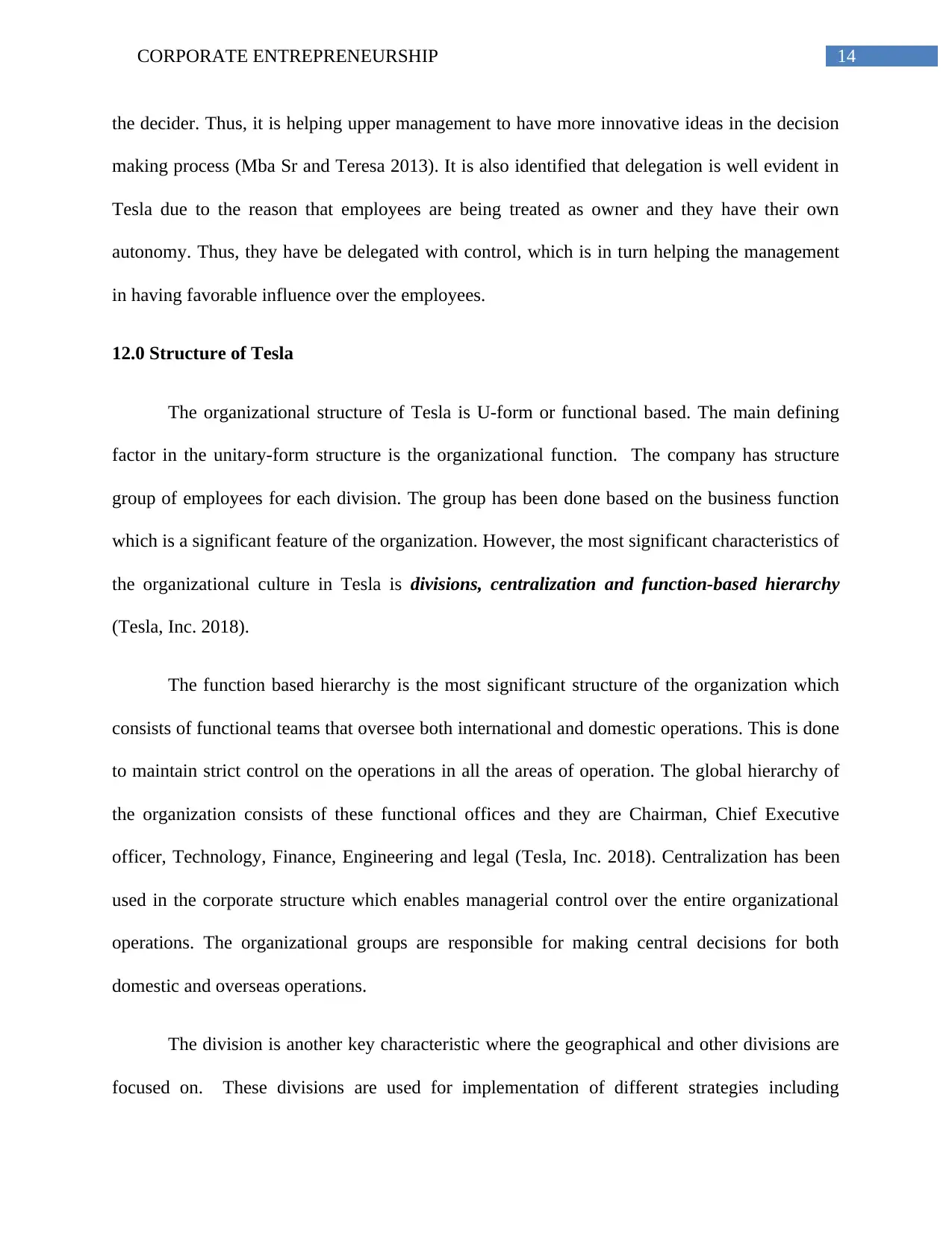
14CORPORATE ENTREPRENEURSHIP
the decider. Thus, it is helping upper management to have more innovative ideas in the decision
making process (Mba Sr and Teresa 2013). It is also identified that delegation is well evident in
Tesla due to the reason that employees are being treated as owner and they have their own
autonomy. Thus, they have be delegated with control, which is in turn helping the management
in having favorable influence over the employees.
12.0 Structure of Tesla
The organizational structure of Tesla is U-form or functional based. The main defining
factor in the unitary-form structure is the organizational function. The company has structure
group of employees for each division. The group has been done based on the business function
which is a significant feature of the organization. However, the most significant characteristics of
the organizational culture in Tesla is divisions, centralization and function-based hierarchy
(Tesla, Inc. 2018).
The function based hierarchy is the most significant structure of the organization which
consists of functional teams that oversee both international and domestic operations. This is done
to maintain strict control on the operations in all the areas of operation. The global hierarchy of
the organization consists of these functional offices and they are Chairman, Chief Executive
officer, Technology, Finance, Engineering and legal (Tesla, Inc. 2018). Centralization has been
used in the corporate structure which enables managerial control over the entire organizational
operations. The organizational groups are responsible for making central decisions for both
domestic and overseas operations.
The division is another key characteristic where the geographical and other divisions are
focused on. These divisions are used for implementation of different strategies including
the decider. Thus, it is helping upper management to have more innovative ideas in the decision
making process (Mba Sr and Teresa 2013). It is also identified that delegation is well evident in
Tesla due to the reason that employees are being treated as owner and they have their own
autonomy. Thus, they have be delegated with control, which is in turn helping the management
in having favorable influence over the employees.
12.0 Structure of Tesla
The organizational structure of Tesla is U-form or functional based. The main defining
factor in the unitary-form structure is the organizational function. The company has structure
group of employees for each division. The group has been done based on the business function
which is a significant feature of the organization. However, the most significant characteristics of
the organizational culture in Tesla is divisions, centralization and function-based hierarchy
(Tesla, Inc. 2018).
The function based hierarchy is the most significant structure of the organization which
consists of functional teams that oversee both international and domestic operations. This is done
to maintain strict control on the operations in all the areas of operation. The global hierarchy of
the organization consists of these functional offices and they are Chairman, Chief Executive
officer, Technology, Finance, Engineering and legal (Tesla, Inc. 2018). Centralization has been
used in the corporate structure which enables managerial control over the entire organizational
operations. The organizational groups are responsible for making central decisions for both
domestic and overseas operations.
The division is another key characteristic where the geographical and other divisions are
focused on. These divisions are used for implementation of different strategies including
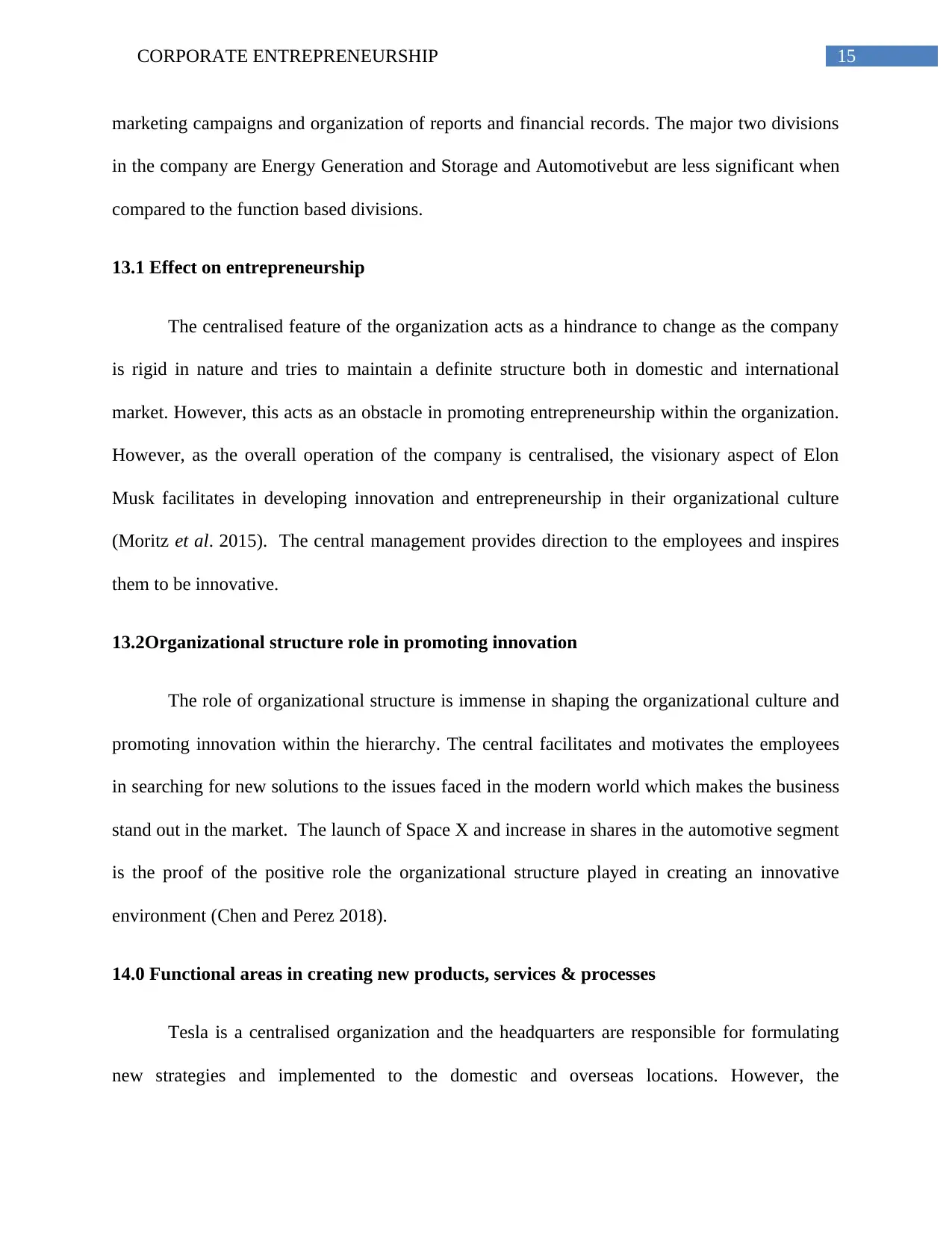
15CORPORATE ENTREPRENEURSHIP
marketing campaigns and organization of reports and financial records. The major two divisions
in the company are Energy Generation and Storage and Automotivebut are less significant when
compared to the function based divisions.
13.1 Effect on entrepreneurship
The centralised feature of the organization acts as a hindrance to change as the company
is rigid in nature and tries to maintain a definite structure both in domestic and international
market. However, this acts as an obstacle in promoting entrepreneurship within the organization.
However, as the overall operation of the company is centralised, the visionary aspect of Elon
Musk facilitates in developing innovation and entrepreneurship in their organizational culture
(Moritz et al. 2015). The central management provides direction to the employees and inspires
them to be innovative.
13.2Organizational structure role in promoting innovation
The role of organizational structure is immense in shaping the organizational culture and
promoting innovation within the hierarchy. The central facilitates and motivates the employees
in searching for new solutions to the issues faced in the modern world which makes the business
stand out in the market. The launch of Space X and increase in shares in the automotive segment
is the proof of the positive role the organizational structure played in creating an innovative
environment (Chen and Perez 2018).
14.0 Functional areas in creating new products, services & processes
Tesla is a centralised organization and the headquarters are responsible for formulating
new strategies and implemented to the domestic and overseas locations. However, the
marketing campaigns and organization of reports and financial records. The major two divisions
in the company are Energy Generation and Storage and Automotivebut are less significant when
compared to the function based divisions.
13.1 Effect on entrepreneurship
The centralised feature of the organization acts as a hindrance to change as the company
is rigid in nature and tries to maintain a definite structure both in domestic and international
market. However, this acts as an obstacle in promoting entrepreneurship within the organization.
However, as the overall operation of the company is centralised, the visionary aspect of Elon
Musk facilitates in developing innovation and entrepreneurship in their organizational culture
(Moritz et al. 2015). The central management provides direction to the employees and inspires
them to be innovative.
13.2Organizational structure role in promoting innovation
The role of organizational structure is immense in shaping the organizational culture and
promoting innovation within the hierarchy. The central facilitates and motivates the employees
in searching for new solutions to the issues faced in the modern world which makes the business
stand out in the market. The launch of Space X and increase in shares in the automotive segment
is the proof of the positive role the organizational structure played in creating an innovative
environment (Chen and Perez 2018).
14.0 Functional areas in creating new products, services & processes
Tesla is a centralised organization and the headquarters are responsible for formulating
new strategies and implemented to the domestic and overseas locations. However, the
Secure Best Marks with AI Grader
Need help grading? Try our AI Grader for instant feedback on your assignments.
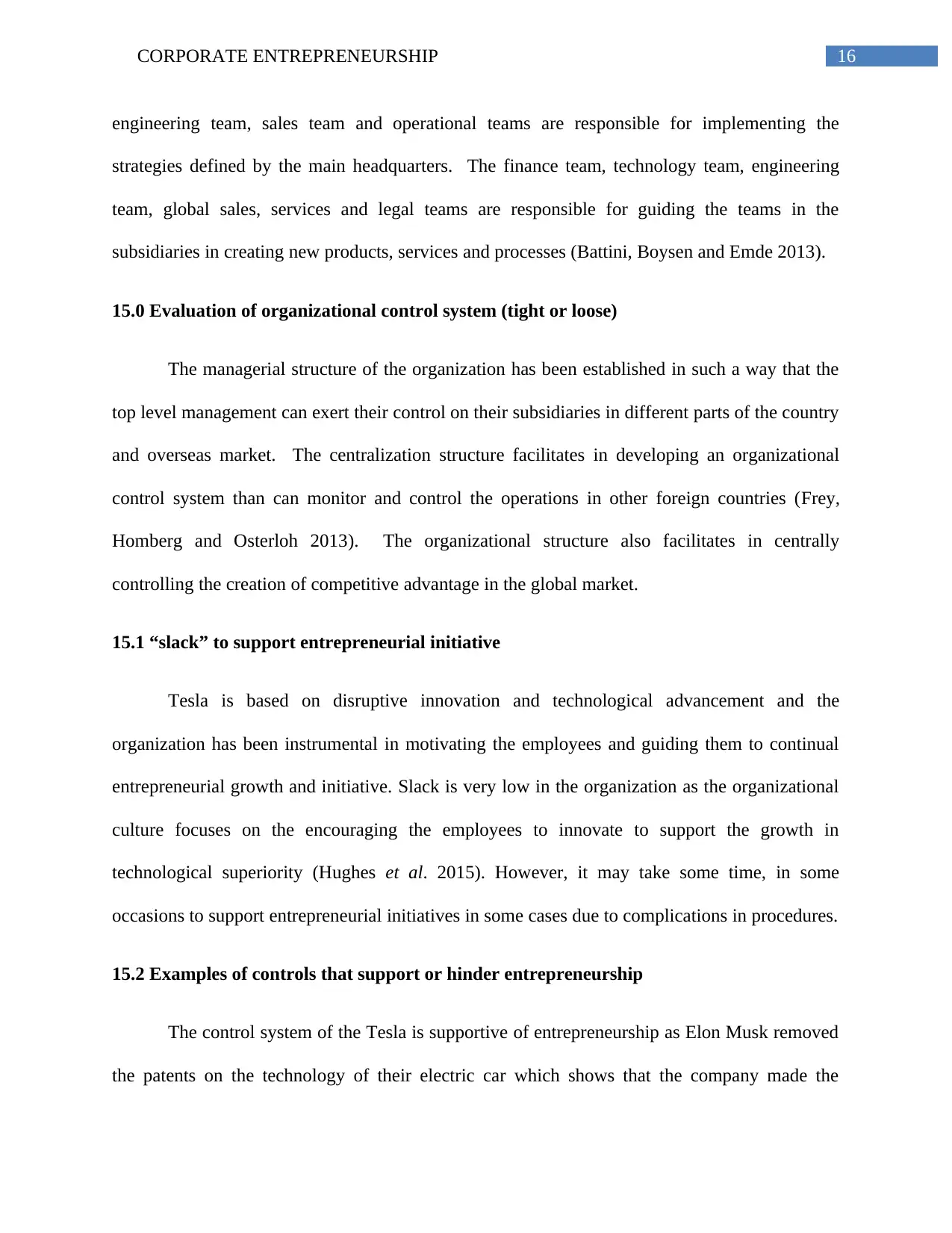
16CORPORATE ENTREPRENEURSHIP
engineering team, sales team and operational teams are responsible for implementing the
strategies defined by the main headquarters. The finance team, technology team, engineering
team, global sales, services and legal teams are responsible for guiding the teams in the
subsidiaries in creating new products, services and processes (Battini, Boysen and Emde 2013).
15.0 Evaluation of organizational control system (tight or loose)
The managerial structure of the organization has been established in such a way that the
top level management can exert their control on their subsidiaries in different parts of the country
and overseas market. The centralization structure facilitates in developing an organizational
control system than can monitor and control the operations in other foreign countries (Frey,
Homberg and Osterloh 2013). The organizational structure also facilitates in centrally
controlling the creation of competitive advantage in the global market.
15.1 “slack” to support entrepreneurial initiative
Tesla is based on disruptive innovation and technological advancement and the
organization has been instrumental in motivating the employees and guiding them to continual
entrepreneurial growth and initiative. Slack is very low in the organization as the organizational
culture focuses on the encouraging the employees to innovate to support the growth in
technological superiority (Hughes et al. 2015). However, it may take some time, in some
occasions to support entrepreneurial initiatives in some cases due to complications in procedures.
15.2 Examples of controls that support or hinder entrepreneurship
The control system of the Tesla is supportive of entrepreneurship as Elon Musk removed
the patents on the technology of their electric car which shows that the company made the
engineering team, sales team and operational teams are responsible for implementing the
strategies defined by the main headquarters. The finance team, technology team, engineering
team, global sales, services and legal teams are responsible for guiding the teams in the
subsidiaries in creating new products, services and processes (Battini, Boysen and Emde 2013).
15.0 Evaluation of organizational control system (tight or loose)
The managerial structure of the organization has been established in such a way that the
top level management can exert their control on their subsidiaries in different parts of the country
and overseas market. The centralization structure facilitates in developing an organizational
control system than can monitor and control the operations in other foreign countries (Frey,
Homberg and Osterloh 2013). The organizational structure also facilitates in centrally
controlling the creation of competitive advantage in the global market.
15.1 “slack” to support entrepreneurial initiative
Tesla is based on disruptive innovation and technological advancement and the
organization has been instrumental in motivating the employees and guiding them to continual
entrepreneurial growth and initiative. Slack is very low in the organization as the organizational
culture focuses on the encouraging the employees to innovate to support the growth in
technological superiority (Hughes et al. 2015). However, it may take some time, in some
occasions to support entrepreneurial initiatives in some cases due to complications in procedures.
15.2 Examples of controls that support or hinder entrepreneurship
The control system of the Tesla is supportive of entrepreneurship as Elon Musk removed
the patents on the technology of their electric car which shows that the company made the
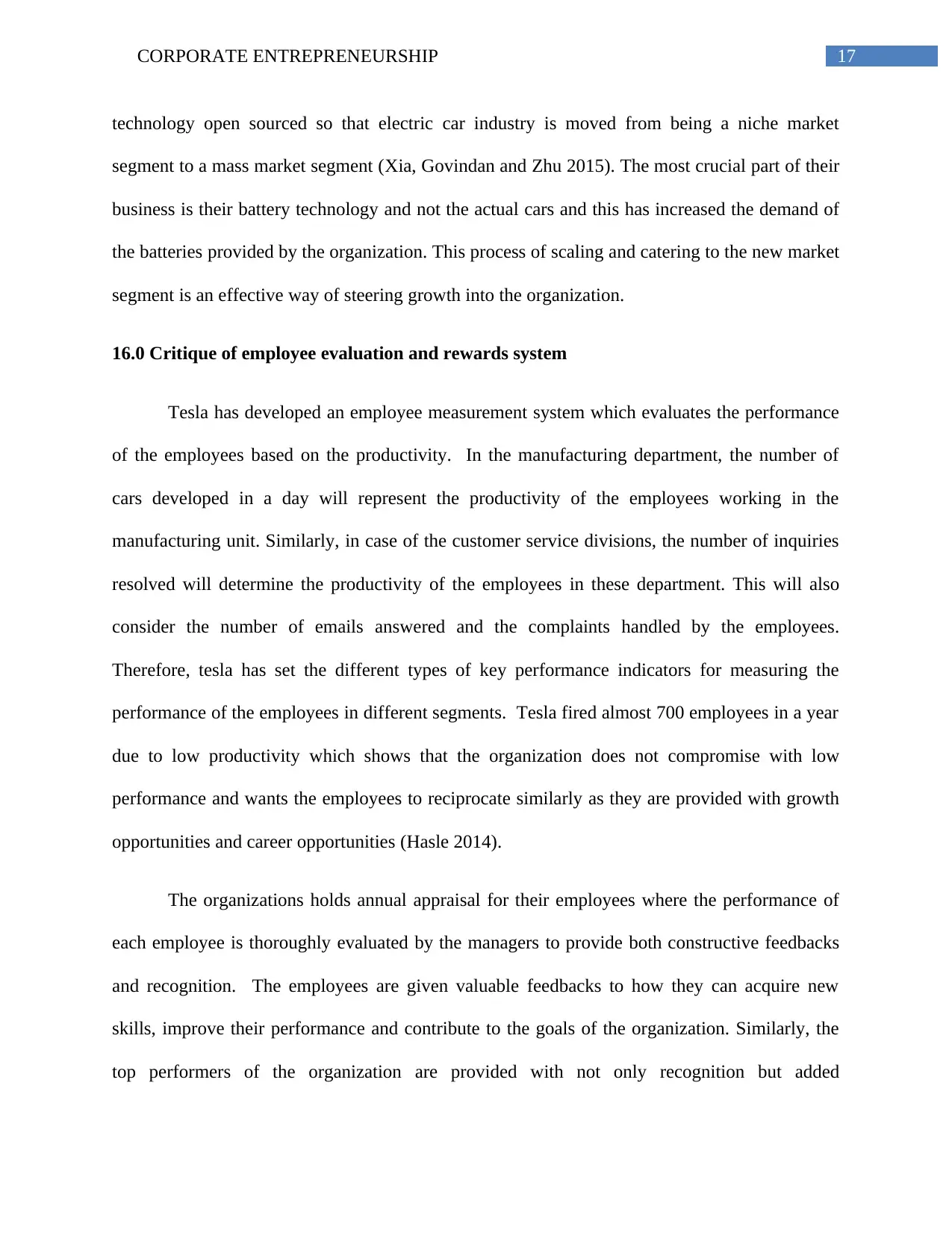
17CORPORATE ENTREPRENEURSHIP
technology open sourced so that electric car industry is moved from being a niche market
segment to a mass market segment (Xia, Govindan and Zhu 2015). The most crucial part of their
business is their battery technology and not the actual cars and this has increased the demand of
the batteries provided by the organization. This process of scaling and catering to the new market
segment is an effective way of steering growth into the organization.
16.0 Critique of employee evaluation and rewards system
Tesla has developed an employee measurement system which evaluates the performance
of the employees based on the productivity. In the manufacturing department, the number of
cars developed in a day will represent the productivity of the employees working in the
manufacturing unit. Similarly, in case of the customer service divisions, the number of inquiries
resolved will determine the productivity of the employees in these department. This will also
consider the number of emails answered and the complaints handled by the employees.
Therefore, tesla has set the different types of key performance indicators for measuring the
performance of the employees in different segments. Tesla fired almost 700 employees in a year
due to low productivity which shows that the organization does not compromise with low
performance and wants the employees to reciprocate similarly as they are provided with growth
opportunities and career opportunities (Hasle 2014).
The organizations holds annual appraisal for their employees where the performance of
each employee is thoroughly evaluated by the managers to provide both constructive feedbacks
and recognition. The employees are given valuable feedbacks to how they can acquire new
skills, improve their performance and contribute to the goals of the organization. Similarly, the
top performers of the organization are provided with not only recognition but added
technology open sourced so that electric car industry is moved from being a niche market
segment to a mass market segment (Xia, Govindan and Zhu 2015). The most crucial part of their
business is their battery technology and not the actual cars and this has increased the demand of
the batteries provided by the organization. This process of scaling and catering to the new market
segment is an effective way of steering growth into the organization.
16.0 Critique of employee evaluation and rewards system
Tesla has developed an employee measurement system which evaluates the performance
of the employees based on the productivity. In the manufacturing department, the number of
cars developed in a day will represent the productivity of the employees working in the
manufacturing unit. Similarly, in case of the customer service divisions, the number of inquiries
resolved will determine the productivity of the employees in these department. This will also
consider the number of emails answered and the complaints handled by the employees.
Therefore, tesla has set the different types of key performance indicators for measuring the
performance of the employees in different segments. Tesla fired almost 700 employees in a year
due to low productivity which shows that the organization does not compromise with low
performance and wants the employees to reciprocate similarly as they are provided with growth
opportunities and career opportunities (Hasle 2014).
The organizations holds annual appraisal for their employees where the performance of
each employee is thoroughly evaluated by the managers to provide both constructive feedbacks
and recognition. The employees are given valuable feedbacks to how they can acquire new
skills, improve their performance and contribute to the goals of the organization. Similarly, the
top performers of the organization are provided with not only recognition but added
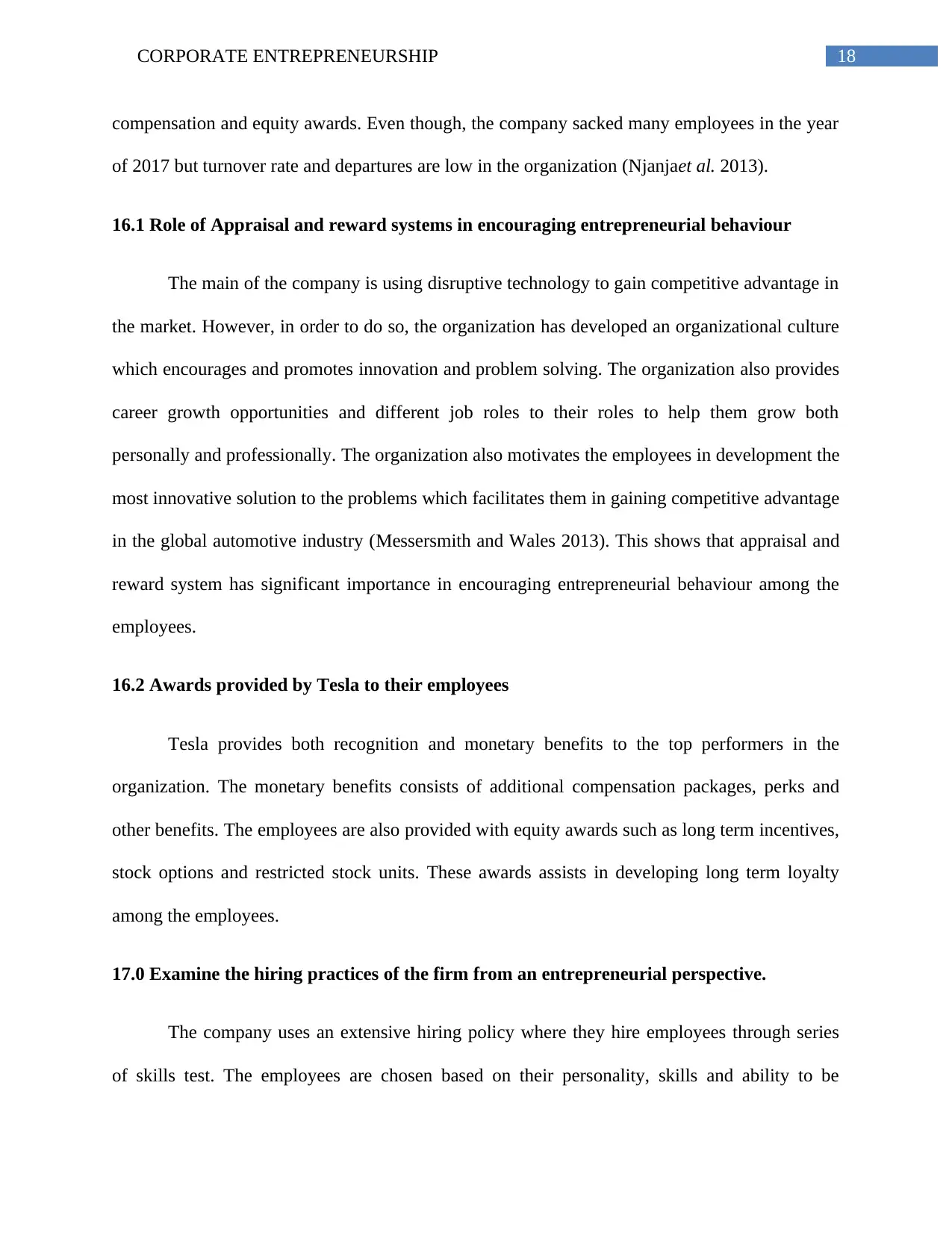
18CORPORATE ENTREPRENEURSHIP
compensation and equity awards. Even though, the company sacked many employees in the year
of 2017 but turnover rate and departures are low in the organization (Njanjaet al. 2013).
16.1 Role of Appraisal and reward systems in encouraging entrepreneurial behaviour
The main of the company is using disruptive technology to gain competitive advantage in
the market. However, in order to do so, the organization has developed an organizational culture
which encourages and promotes innovation and problem solving. The organization also provides
career growth opportunities and different job roles to their roles to help them grow both
personally and professionally. The organization also motivates the employees in development the
most innovative solution to the problems which facilitates them in gaining competitive advantage
in the global automotive industry (Messersmith and Wales 2013). This shows that appraisal and
reward system has significant importance in encouraging entrepreneurial behaviour among the
employees.
16.2 Awards provided by Tesla to their employees
Tesla provides both recognition and monetary benefits to the top performers in the
organization. The monetary benefits consists of additional compensation packages, perks and
other benefits. The employees are also provided with equity awards such as long term incentives,
stock options and restricted stock units. These awards assists in developing long term loyalty
among the employees.
17.0 Examine the hiring practices of the firm from an entrepreneurial perspective.
The company uses an extensive hiring policy where they hire employees through series
of skills test. The employees are chosen based on their personality, skills and ability to be
compensation and equity awards. Even though, the company sacked many employees in the year
of 2017 but turnover rate and departures are low in the organization (Njanjaet al. 2013).
16.1 Role of Appraisal and reward systems in encouraging entrepreneurial behaviour
The main of the company is using disruptive technology to gain competitive advantage in
the market. However, in order to do so, the organization has developed an organizational culture
which encourages and promotes innovation and problem solving. The organization also provides
career growth opportunities and different job roles to their roles to help them grow both
personally and professionally. The organization also motivates the employees in development the
most innovative solution to the problems which facilitates them in gaining competitive advantage
in the global automotive industry (Messersmith and Wales 2013). This shows that appraisal and
reward system has significant importance in encouraging entrepreneurial behaviour among the
employees.
16.2 Awards provided by Tesla to their employees
Tesla provides both recognition and monetary benefits to the top performers in the
organization. The monetary benefits consists of additional compensation packages, perks and
other benefits. The employees are also provided with equity awards such as long term incentives,
stock options and restricted stock units. These awards assists in developing long term loyalty
among the employees.
17.0 Examine the hiring practices of the firm from an entrepreneurial perspective.
The company uses an extensive hiring policy where they hire employees through series
of skills test. The employees are chosen based on their personality, skills and ability to be
Paraphrase This Document
Need a fresh take? Get an instant paraphrase of this document with our AI Paraphraser
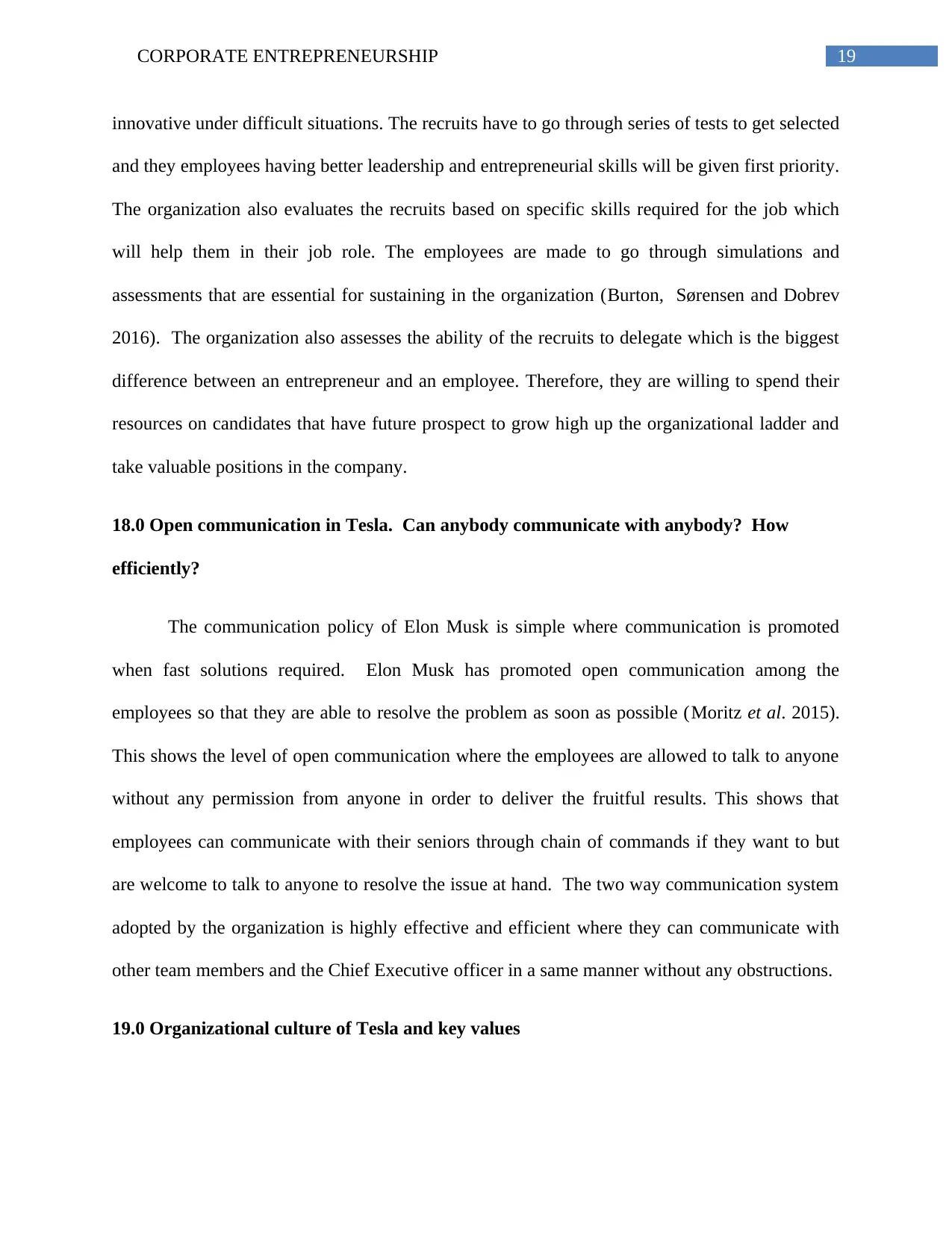
19CORPORATE ENTREPRENEURSHIP
innovative under difficult situations. The recruits have to go through series of tests to get selected
and they employees having better leadership and entrepreneurial skills will be given first priority.
The organization also evaluates the recruits based on specific skills required for the job which
will help them in their job role. The employees are made to go through simulations and
assessments that are essential for sustaining in the organization (Burton, Sørensen and Dobrev
2016). The organization also assesses the ability of the recruits to delegate which is the biggest
difference between an entrepreneur and an employee. Therefore, they are willing to spend their
resources on candidates that have future prospect to grow high up the organizational ladder and
take valuable positions in the company.
18.0 Open communication in Tesla. Can anybody communicate with anybody? How
efficiently?
The communication policy of Elon Musk is simple where communication is promoted
when fast solutions required. Elon Musk has promoted open communication among the
employees so that they are able to resolve the problem as soon as possible (Moritz et al. 2015).
This shows the level of open communication where the employees are allowed to talk to anyone
without any permission from anyone in order to deliver the fruitful results. This shows that
employees can communicate with their seniors through chain of commands if they want to but
are welcome to talk to anyone to resolve the issue at hand. The two way communication system
adopted by the organization is highly effective and efficient where they can communicate with
other team members and the Chief Executive officer in a same manner without any obstructions.
19.0 Organizational culture of Tesla and key values
innovative under difficult situations. The recruits have to go through series of tests to get selected
and they employees having better leadership and entrepreneurial skills will be given first priority.
The organization also evaluates the recruits based on specific skills required for the job which
will help them in their job role. The employees are made to go through simulations and
assessments that are essential for sustaining in the organization (Burton, Sørensen and Dobrev
2016). The organization also assesses the ability of the recruits to delegate which is the biggest
difference between an entrepreneur and an employee. Therefore, they are willing to spend their
resources on candidates that have future prospect to grow high up the organizational ladder and
take valuable positions in the company.
18.0 Open communication in Tesla. Can anybody communicate with anybody? How
efficiently?
The communication policy of Elon Musk is simple where communication is promoted
when fast solutions required. Elon Musk has promoted open communication among the
employees so that they are able to resolve the problem as soon as possible (Moritz et al. 2015).
This shows the level of open communication where the employees are allowed to talk to anyone
without any permission from anyone in order to deliver the fruitful results. This shows that
employees can communicate with their seniors through chain of commands if they want to but
are welcome to talk to anyone to resolve the issue at hand. The two way communication system
adopted by the organization is highly effective and efficient where they can communicate with
other team members and the Chief Executive officer in a same manner without any obstructions.
19.0 Organizational culture of Tesla and key values
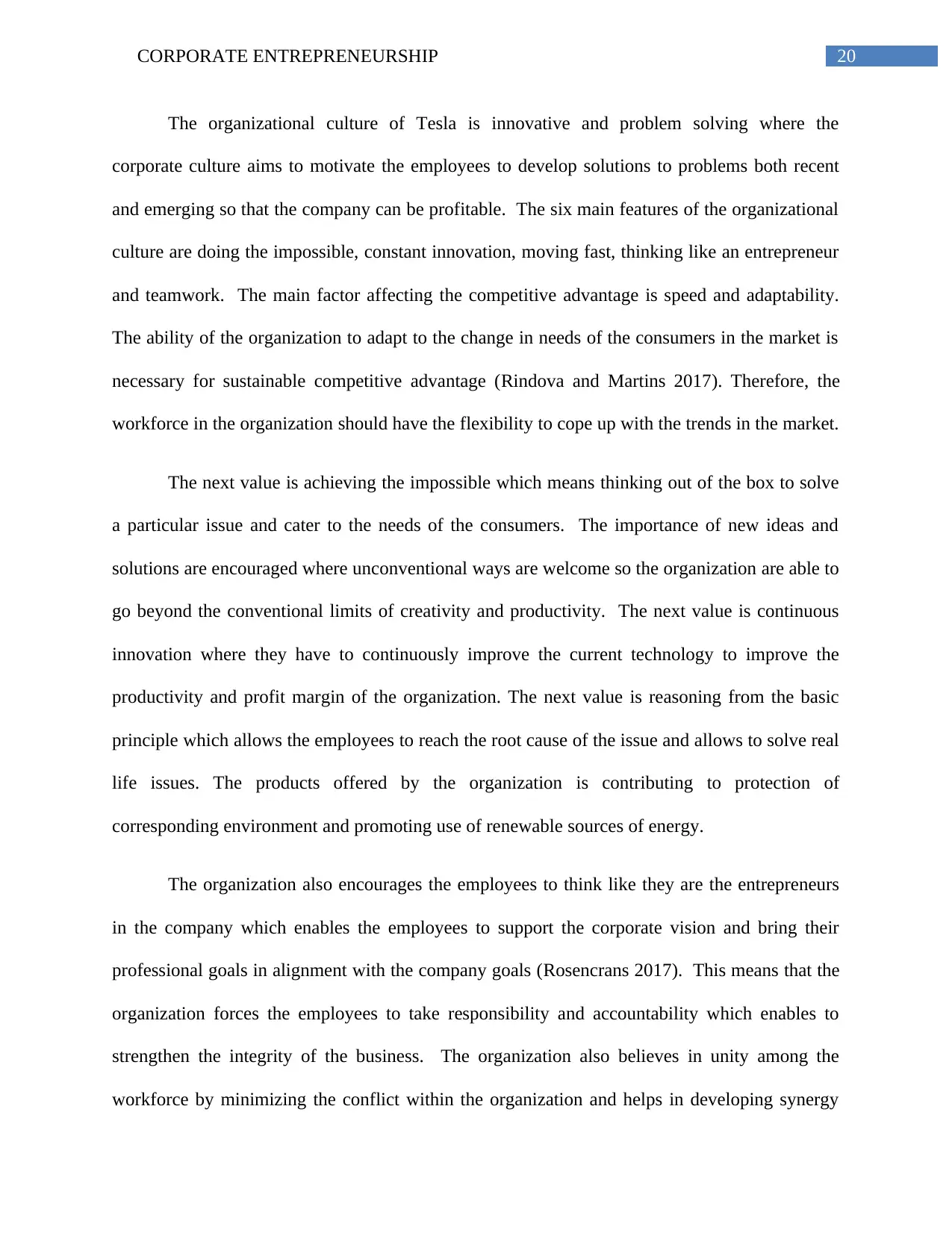
20CORPORATE ENTREPRENEURSHIP
The organizational culture of Tesla is innovative and problem solving where the
corporate culture aims to motivate the employees to develop solutions to problems both recent
and emerging so that the company can be profitable. The six main features of the organizational
culture are doing the impossible, constant innovation, moving fast, thinking like an entrepreneur
and teamwork. The main factor affecting the competitive advantage is speed and adaptability.
The ability of the organization to adapt to the change in needs of the consumers in the market is
necessary for sustainable competitive advantage (Rindova and Martins 2017). Therefore, the
workforce in the organization should have the flexibility to cope up with the trends in the market.
The next value is achieving the impossible which means thinking out of the box to solve
a particular issue and cater to the needs of the consumers. The importance of new ideas and
solutions are encouraged where unconventional ways are welcome so the organization are able to
go beyond the conventional limits of creativity and productivity. The next value is continuous
innovation where they have to continuously improve the current technology to improve the
productivity and profit margin of the organization. The next value is reasoning from the basic
principle which allows the employees to reach the root cause of the issue and allows to solve real
life issues. The products offered by the organization is contributing to protection of
corresponding environment and promoting use of renewable sources of energy.
The organization also encourages the employees to think like they are the entrepreneurs
in the company which enables the employees to support the corporate vision and bring their
professional goals in alignment with the company goals (Rosencrans 2017). This means that the
organization forces the employees to take responsibility and accountability which enables to
strengthen the integrity of the business. The organization also believes in unity among the
workforce by minimizing the conflict within the organization and helps in developing synergy
The organizational culture of Tesla is innovative and problem solving where the
corporate culture aims to motivate the employees to develop solutions to problems both recent
and emerging so that the company can be profitable. The six main features of the organizational
culture are doing the impossible, constant innovation, moving fast, thinking like an entrepreneur
and teamwork. The main factor affecting the competitive advantage is speed and adaptability.
The ability of the organization to adapt to the change in needs of the consumers in the market is
necessary for sustainable competitive advantage (Rindova and Martins 2017). Therefore, the
workforce in the organization should have the flexibility to cope up with the trends in the market.
The next value is achieving the impossible which means thinking out of the box to solve
a particular issue and cater to the needs of the consumers. The importance of new ideas and
solutions are encouraged where unconventional ways are welcome so the organization are able to
go beyond the conventional limits of creativity and productivity. The next value is continuous
innovation where they have to continuously improve the current technology to improve the
productivity and profit margin of the organization. The next value is reasoning from the basic
principle which allows the employees to reach the root cause of the issue and allows to solve real
life issues. The products offered by the organization is contributing to protection of
corresponding environment and promoting use of renewable sources of energy.
The organization also encourages the employees to think like they are the entrepreneurs
in the company which enables the employees to support the corporate vision and bring their
professional goals in alignment with the company goals (Rosencrans 2017). This means that the
organization forces the employees to take responsibility and accountability which enables to
strengthen the integrity of the business. The organization also believes in unity among the
workforce by minimizing the conflict within the organization and helps in developing synergy
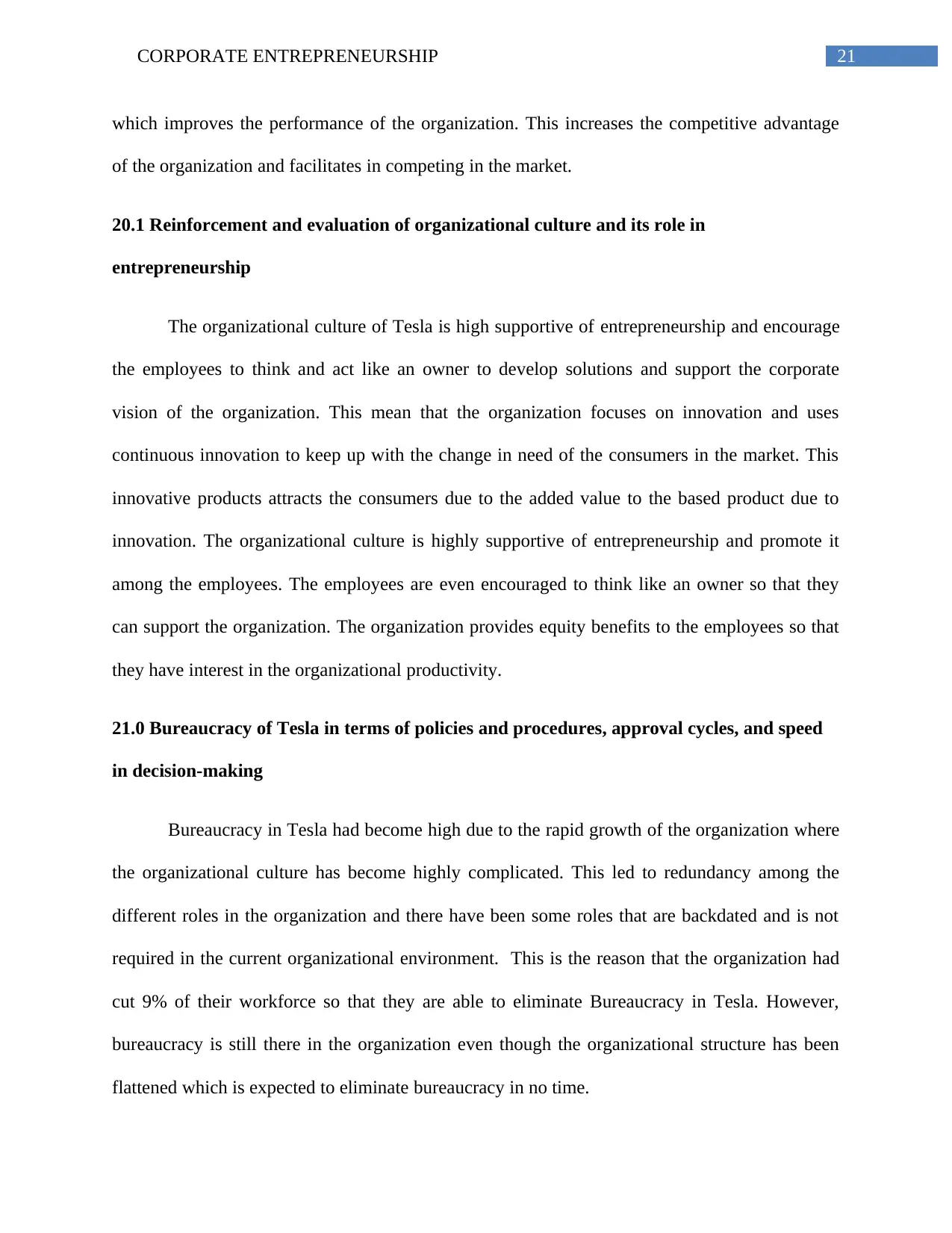
21CORPORATE ENTREPRENEURSHIP
which improves the performance of the organization. This increases the competitive advantage
of the organization and facilitates in competing in the market.
20.1 Reinforcement and evaluation of organizational culture and its role in
entrepreneurship
The organizational culture of Tesla is high supportive of entrepreneurship and encourage
the employees to think and act like an owner to develop solutions and support the corporate
vision of the organization. This mean that the organization focuses on innovation and uses
continuous innovation to keep up with the change in need of the consumers in the market. This
innovative products attracts the consumers due to the added value to the based product due to
innovation. The organizational culture is highly supportive of entrepreneurship and promote it
among the employees. The employees are even encouraged to think like an owner so that they
can support the organization. The organization provides equity benefits to the employees so that
they have interest in the organizational productivity.
21.0 Bureaucracy of Tesla in terms of policies and procedures, approval cycles, and speed
in decision-making
Bureaucracy in Tesla had become high due to the rapid growth of the organization where
the organizational culture has become highly complicated. This led to redundancy among the
different roles in the organization and there have been some roles that are backdated and is not
required in the current organizational environment. This is the reason that the organization had
cut 9% of their workforce so that they are able to eliminate Bureaucracy in Tesla. However,
bureaucracy is still there in the organization even though the organizational structure has been
flattened which is expected to eliminate bureaucracy in no time.
which improves the performance of the organization. This increases the competitive advantage
of the organization and facilitates in competing in the market.
20.1 Reinforcement and evaluation of organizational culture and its role in
entrepreneurship
The organizational culture of Tesla is high supportive of entrepreneurship and encourage
the employees to think and act like an owner to develop solutions and support the corporate
vision of the organization. This mean that the organization focuses on innovation and uses
continuous innovation to keep up with the change in need of the consumers in the market. This
innovative products attracts the consumers due to the added value to the based product due to
innovation. The organizational culture is highly supportive of entrepreneurship and promote it
among the employees. The employees are even encouraged to think like an owner so that they
can support the organization. The organization provides equity benefits to the employees so that
they have interest in the organizational productivity.
21.0 Bureaucracy of Tesla in terms of policies and procedures, approval cycles, and speed
in decision-making
Bureaucracy in Tesla had become high due to the rapid growth of the organization where
the organizational culture has become highly complicated. This led to redundancy among the
different roles in the organization and there have been some roles that are backdated and is not
required in the current organizational environment. This is the reason that the organization had
cut 9% of their workforce so that they are able to eliminate Bureaucracy in Tesla. However,
bureaucracy is still there in the organization even though the organizational structure has been
flattened which is expected to eliminate bureaucracy in no time.
Secure Best Marks with AI Grader
Need help grading? Try our AI Grader for instant feedback on your assignments.
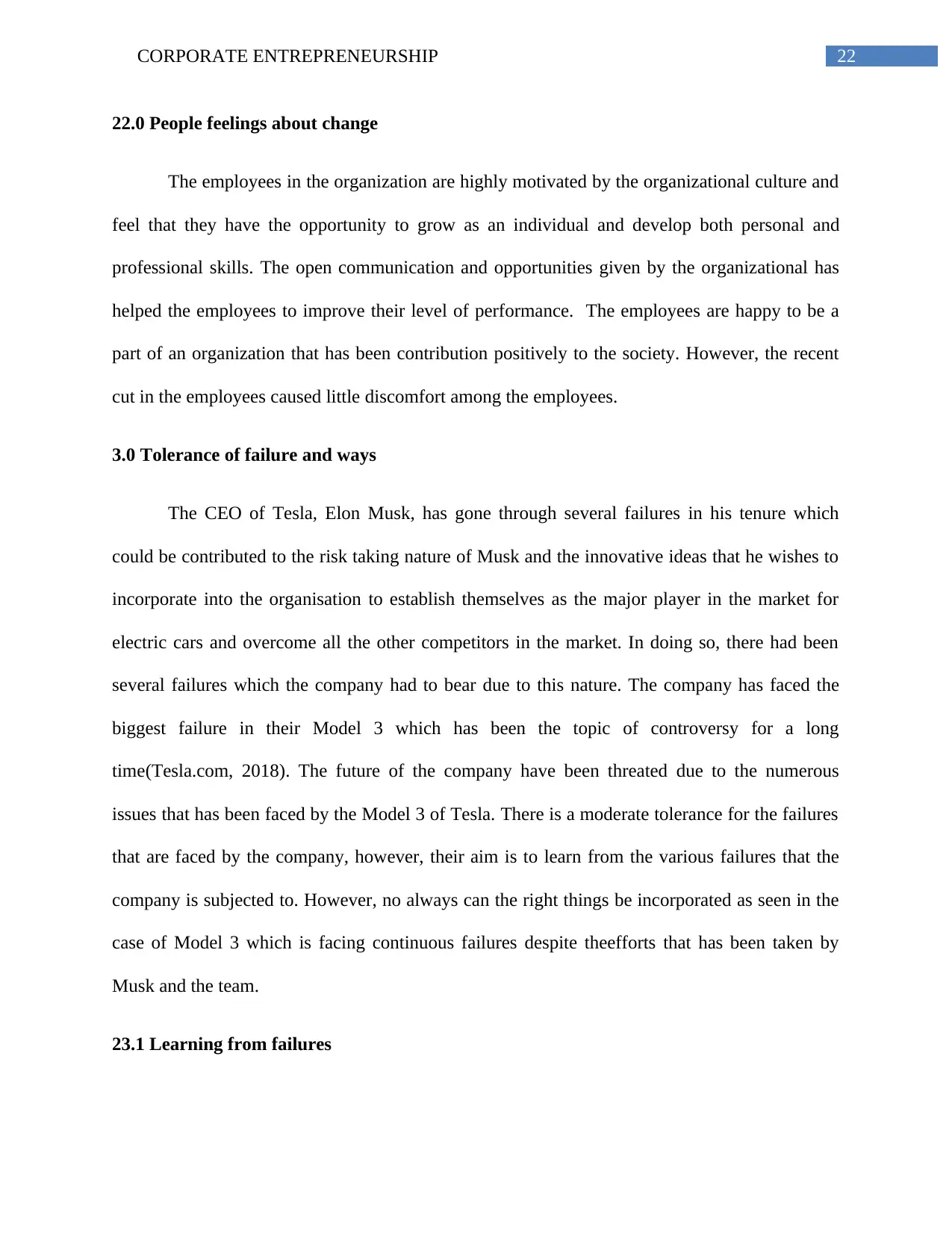
22CORPORATE ENTREPRENEURSHIP
22.0 People feelings about change
The employees in the organization are highly motivated by the organizational culture and
feel that they have the opportunity to grow as an individual and develop both personal and
professional skills. The open communication and opportunities given by the organizational has
helped the employees to improve their level of performance. The employees are happy to be a
part of an organization that has been contribution positively to the society. However, the recent
cut in the employees caused little discomfort among the employees.
3.0 Tolerance of failure and ways
The CEO of Tesla, Elon Musk, has gone through several failures in his tenure which
could be contributed to the risk taking nature of Musk and the innovative ideas that he wishes to
incorporate into the organisation to establish themselves as the major player in the market for
electric cars and overcome all the other competitors in the market. In doing so, there had been
several failures which the company had to bear due to this nature. The company has faced the
biggest failure in their Model 3 which has been the topic of controversy for a long
time(Tesla.com, 2018). The future of the company have been threated due to the numerous
issues that has been faced by the Model 3 of Tesla. There is a moderate tolerance for the failures
that are faced by the company, however, their aim is to learn from the various failures that the
company is subjected to. However, no always can the right things be incorporated as seen in the
case of Model 3 which is facing continuous failures despite theefforts that has been taken by
Musk and the team.
23.1 Learning from failures
22.0 People feelings about change
The employees in the organization are highly motivated by the organizational culture and
feel that they have the opportunity to grow as an individual and develop both personal and
professional skills. The open communication and opportunities given by the organizational has
helped the employees to improve their level of performance. The employees are happy to be a
part of an organization that has been contribution positively to the society. However, the recent
cut in the employees caused little discomfort among the employees.
3.0 Tolerance of failure and ways
The CEO of Tesla, Elon Musk, has gone through several failures in his tenure which
could be contributed to the risk taking nature of Musk and the innovative ideas that he wishes to
incorporate into the organisation to establish themselves as the major player in the market for
electric cars and overcome all the other competitors in the market. In doing so, there had been
several failures which the company had to bear due to this nature. The company has faced the
biggest failure in their Model 3 which has been the topic of controversy for a long
time(Tesla.com, 2018). The future of the company have been threated due to the numerous
issues that has been faced by the Model 3 of Tesla. There is a moderate tolerance for the failures
that are faced by the company, however, their aim is to learn from the various failures that the
company is subjected to. However, no always can the right things be incorporated as seen in the
case of Model 3 which is facing continuous failures despite theefforts that has been taken by
Musk and the team.
23.1 Learning from failures
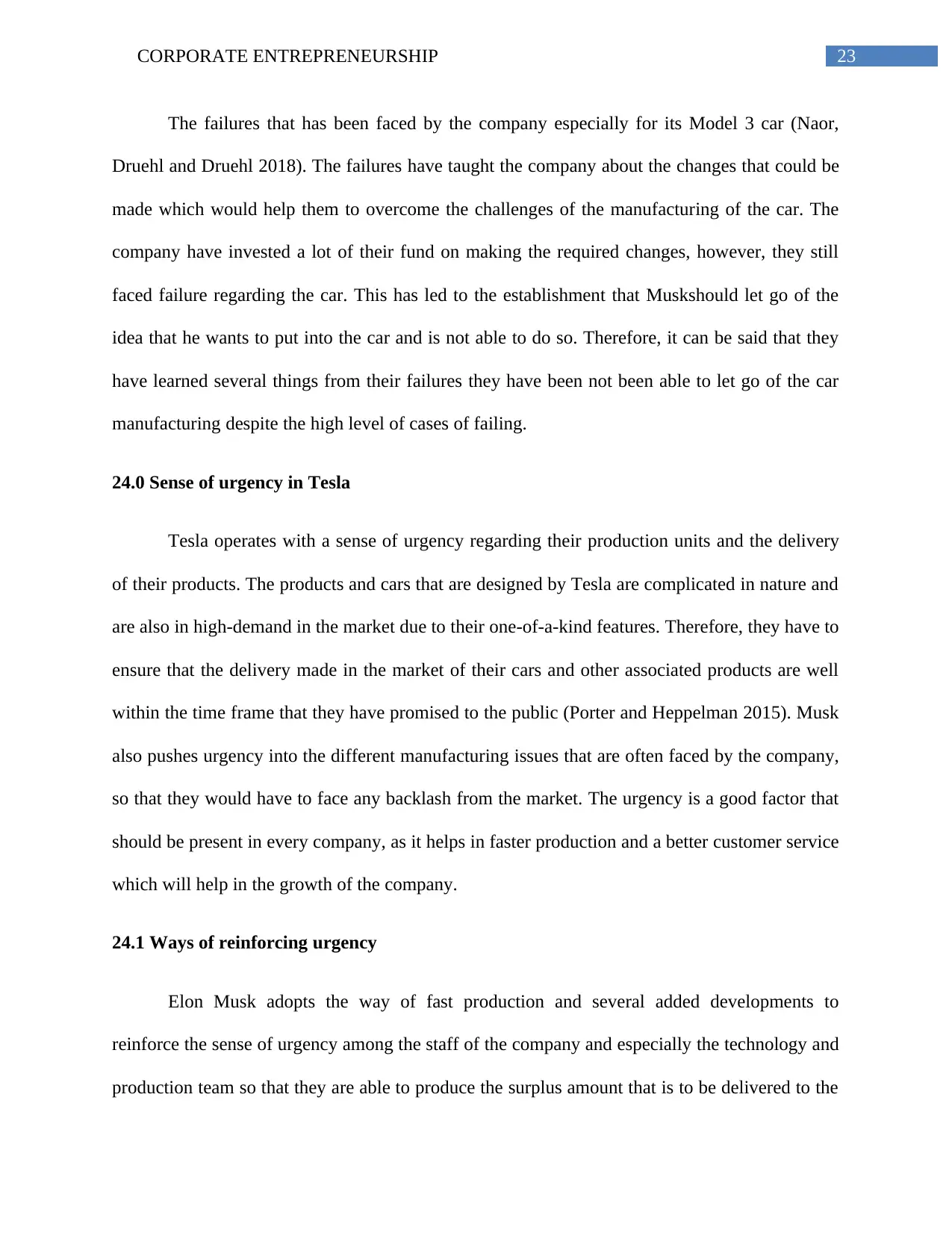
23CORPORATE ENTREPRENEURSHIP
The failures that has been faced by the company especially for its Model 3 car (Naor,
Druehl and Druehl 2018). The failures have taught the company about the changes that could be
made which would help them to overcome the challenges of the manufacturing of the car. The
company have invested a lot of their fund on making the required changes, however, they still
faced failure regarding the car. This has led to the establishment that Muskshould let go of the
idea that he wants to put into the car and is not able to do so. Therefore, it can be said that they
have learned several things from their failures they have been not been able to let go of the car
manufacturing despite the high level of cases of failing.
24.0 Sense of urgency in Tesla
Tesla operates with a sense of urgency regarding their production units and the delivery
of their products. The products and cars that are designed by Tesla are complicated in nature and
are also in high-demand in the market due to their one-of-a-kind features. Therefore, they have to
ensure that the delivery made in the market of their cars and other associated products are well
within the time frame that they have promised to the public (Porter and Heppelman 2015). Musk
also pushes urgency into the different manufacturing issues that are often faced by the company,
so that they would have to face any backlash from the market. The urgency is a good factor that
should be present in every company, as it helps in faster production and a better customer service
which will help in the growth of the company.
24.1 Ways of reinforcing urgency
Elon Musk adopts the way of fast production and several added developments to
reinforce the sense of urgency among the staff of the company and especially the technology and
production team so that they are able to produce the surplus amount that is to be delivered to the
The failures that has been faced by the company especially for its Model 3 car (Naor,
Druehl and Druehl 2018). The failures have taught the company about the changes that could be
made which would help them to overcome the challenges of the manufacturing of the car. The
company have invested a lot of their fund on making the required changes, however, they still
faced failure regarding the car. This has led to the establishment that Muskshould let go of the
idea that he wants to put into the car and is not able to do so. Therefore, it can be said that they
have learned several things from their failures they have been not been able to let go of the car
manufacturing despite the high level of cases of failing.
24.0 Sense of urgency in Tesla
Tesla operates with a sense of urgency regarding their production units and the delivery
of their products. The products and cars that are designed by Tesla are complicated in nature and
are also in high-demand in the market due to their one-of-a-kind features. Therefore, they have to
ensure that the delivery made in the market of their cars and other associated products are well
within the time frame that they have promised to the public (Porter and Heppelman 2015). Musk
also pushes urgency into the different manufacturing issues that are often faced by the company,
so that they would have to face any backlash from the market. The urgency is a good factor that
should be present in every company, as it helps in faster production and a better customer service
which will help in the growth of the company.
24.1 Ways of reinforcing urgency
Elon Musk adopts the way of fast production and several added developments to
reinforce the sense of urgency among the staff of the company and especially the technology and
production team so that they are able to produce the surplus amount that is to be delivered to the
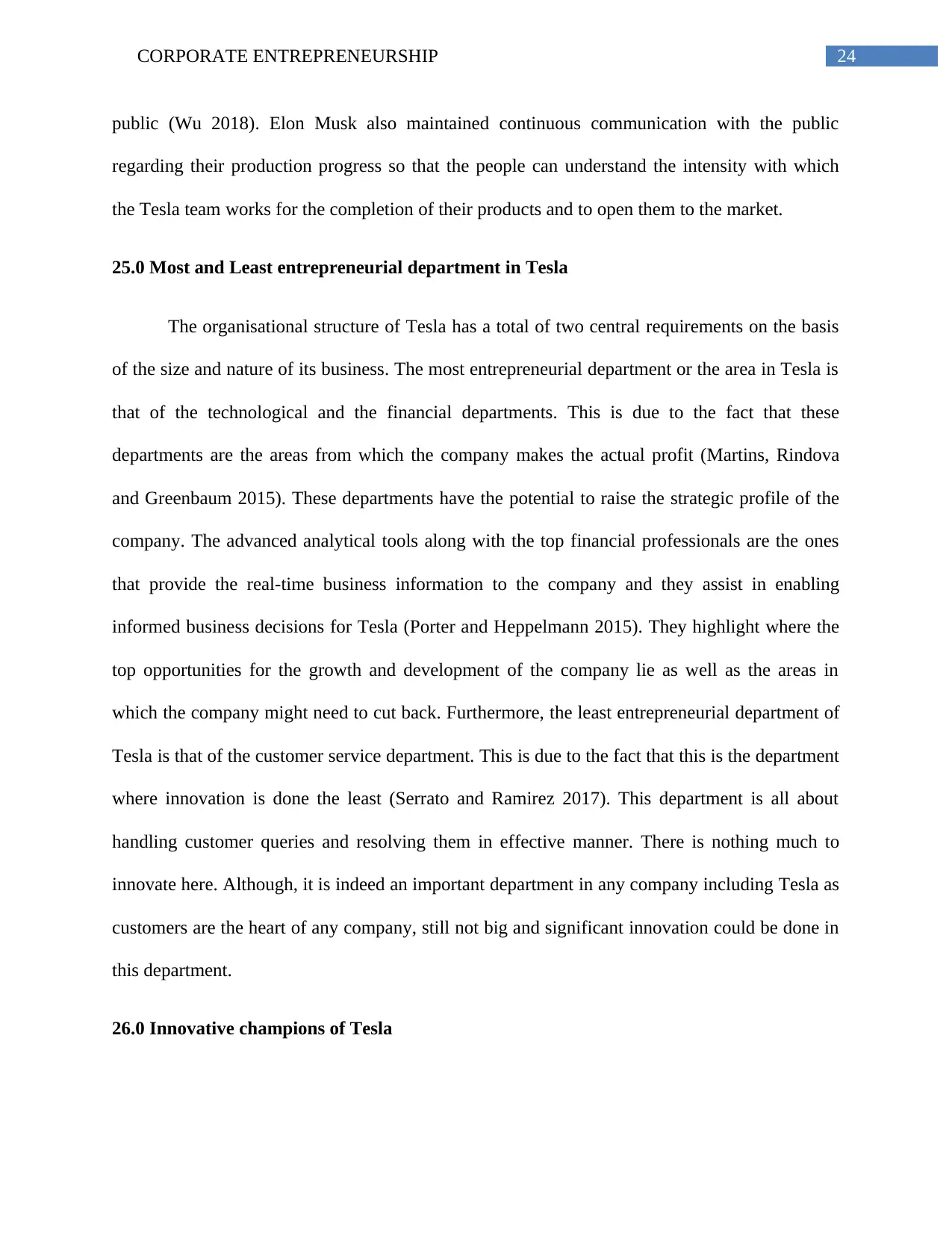
24CORPORATE ENTREPRENEURSHIP
public (Wu 2018). Elon Musk also maintained continuous communication with the public
regarding their production progress so that the people can understand the intensity with which
the Tesla team works for the completion of their products and to open them to the market.
25.0 Most and Least entrepreneurial department in Tesla
The organisational structure of Tesla has a total of two central requirements on the basis
of the size and nature of its business. The most entrepreneurial department or the area in Tesla is
that of the technological and the financial departments. This is due to the fact that these
departments are the areas from which the company makes the actual profit (Martins, Rindova
and Greenbaum 2015). These departments have the potential to raise the strategic profile of the
company. The advanced analytical tools along with the top financial professionals are the ones
that provide the real-time business information to the company and they assist in enabling
informed business decisions for Tesla (Porter and Heppelmann 2015). They highlight where the
top opportunities for the growth and development of the company lie as well as the areas in
which the company might need to cut back. Furthermore, the least entrepreneurial department of
Tesla is that of the customer service department. This is due to the fact that this is the department
where innovation is done the least (Serrato and Ramirez 2017). This department is all about
handling customer queries and resolving them in effective manner. There is nothing much to
innovate here. Although, it is indeed an important department in any company including Tesla as
customers are the heart of any company, still not big and significant innovation could be done in
this department.
26.0 Innovative champions of Tesla
public (Wu 2018). Elon Musk also maintained continuous communication with the public
regarding their production progress so that the people can understand the intensity with which
the Tesla team works for the completion of their products and to open them to the market.
25.0 Most and Least entrepreneurial department in Tesla
The organisational structure of Tesla has a total of two central requirements on the basis
of the size and nature of its business. The most entrepreneurial department or the area in Tesla is
that of the technological and the financial departments. This is due to the fact that these
departments are the areas from which the company makes the actual profit (Martins, Rindova
and Greenbaum 2015). These departments have the potential to raise the strategic profile of the
company. The advanced analytical tools along with the top financial professionals are the ones
that provide the real-time business information to the company and they assist in enabling
informed business decisions for Tesla (Porter and Heppelmann 2015). They highlight where the
top opportunities for the growth and development of the company lie as well as the areas in
which the company might need to cut back. Furthermore, the least entrepreneurial department of
Tesla is that of the customer service department. This is due to the fact that this is the department
where innovation is done the least (Serrato and Ramirez 2017). This department is all about
handling customer queries and resolving them in effective manner. There is nothing much to
innovate here. Although, it is indeed an important department in any company including Tesla as
customers are the heart of any company, still not big and significant innovation could be done in
this department.
26.0 Innovative champions of Tesla
Paraphrase This Document
Need a fresh take? Get an instant paraphrase of this document with our AI Paraphraser
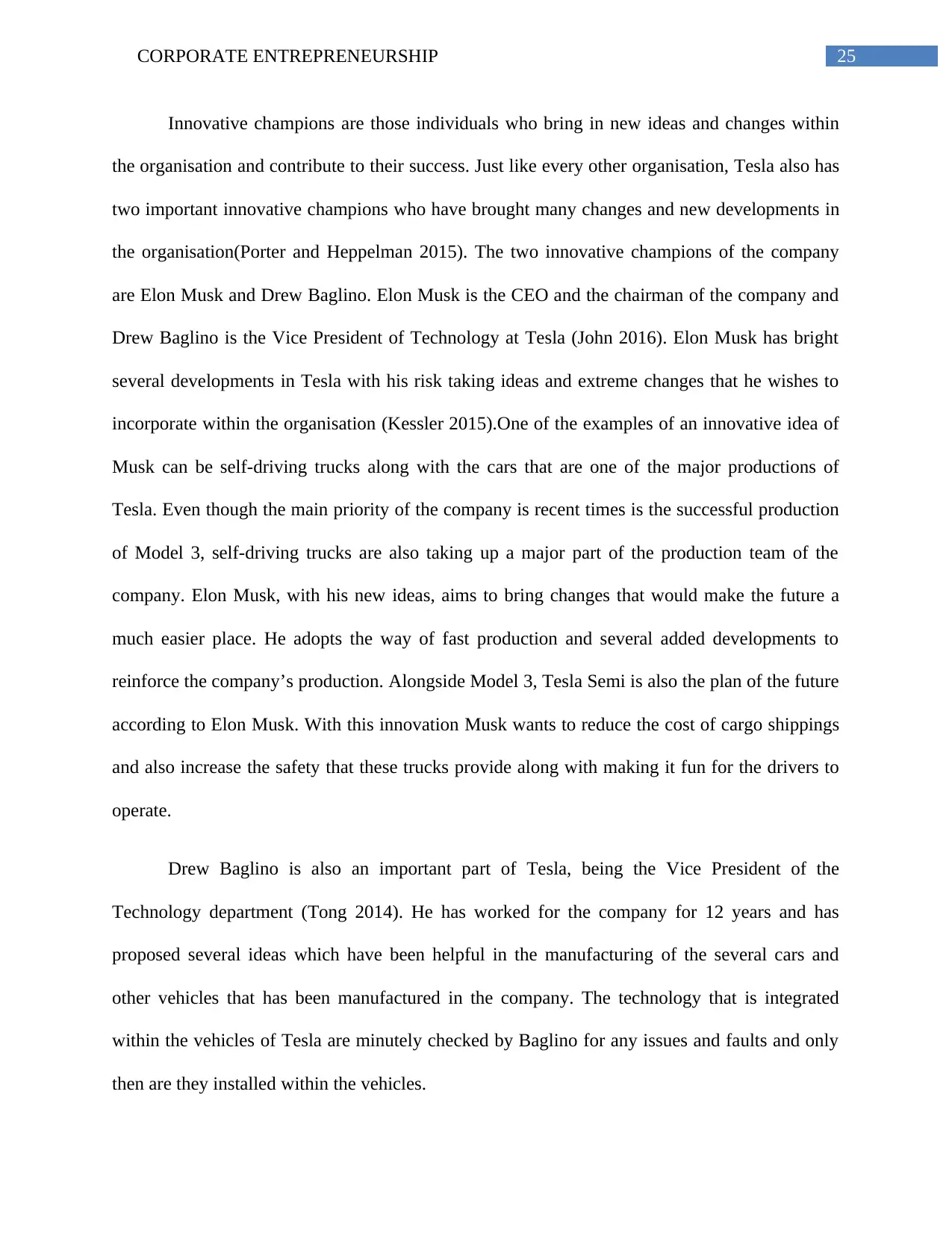
25CORPORATE ENTREPRENEURSHIP
Innovative champions are those individuals who bring in new ideas and changes within
the organisation and contribute to their success. Just like every other organisation, Tesla also has
two important innovative champions who have brought many changes and new developments in
the organisation(Porter and Heppelman 2015). The two innovative champions of the company
are Elon Musk and Drew Baglino. Elon Musk is the CEO and the chairman of the company and
Drew Baglino is the Vice President of Technology at Tesla (John 2016). Elon Musk has bright
several developments in Tesla with his risk taking ideas and extreme changes that he wishes to
incorporate within the organisation (Kessler 2015).One of the examples of an innovative idea of
Musk can be self-driving trucks along with the cars that are one of the major productions of
Tesla. Even though the main priority of the company is recent times is the successful production
of Model 3, self-driving trucks are also taking up a major part of the production team of the
company. Elon Musk, with his new ideas, aims to bring changes that would make the future a
much easier place. He adopts the way of fast production and several added developments to
reinforce the company’s production. Alongside Model 3, Tesla Semi is also the plan of the future
according to Elon Musk. With this innovation Musk wants to reduce the cost of cargo shippings
and also increase the safety that these trucks provide along with making it fun for the drivers to
operate.
Drew Baglino is also an important part of Tesla, being the Vice President of the
Technology department (Tong 2014). He has worked for the company for 12 years and has
proposed several ideas which have been helpful in the manufacturing of the several cars and
other vehicles that has been manufactured in the company. The technology that is integrated
within the vehicles of Tesla are minutely checked by Baglino for any issues and faults and only
then are they installed within the vehicles.
Innovative champions are those individuals who bring in new ideas and changes within
the organisation and contribute to their success. Just like every other organisation, Tesla also has
two important innovative champions who have brought many changes and new developments in
the organisation(Porter and Heppelman 2015). The two innovative champions of the company
are Elon Musk and Drew Baglino. Elon Musk is the CEO and the chairman of the company and
Drew Baglino is the Vice President of Technology at Tesla (John 2016). Elon Musk has bright
several developments in Tesla with his risk taking ideas and extreme changes that he wishes to
incorporate within the organisation (Kessler 2015).One of the examples of an innovative idea of
Musk can be self-driving trucks along with the cars that are one of the major productions of
Tesla. Even though the main priority of the company is recent times is the successful production
of Model 3, self-driving trucks are also taking up a major part of the production team of the
company. Elon Musk, with his new ideas, aims to bring changes that would make the future a
much easier place. He adopts the way of fast production and several added developments to
reinforce the company’s production. Alongside Model 3, Tesla Semi is also the plan of the future
according to Elon Musk. With this innovation Musk wants to reduce the cost of cargo shippings
and also increase the safety that these trucks provide along with making it fun for the drivers to
operate.
Drew Baglino is also an important part of Tesla, being the Vice President of the
Technology department (Tong 2014). He has worked for the company for 12 years and has
proposed several ideas which have been helpful in the manufacturing of the several cars and
other vehicles that has been manufactured in the company. The technology that is integrated
within the vehicles of Tesla are minutely checked by Baglino for any issues and faults and only
then are they installed within the vehicles.
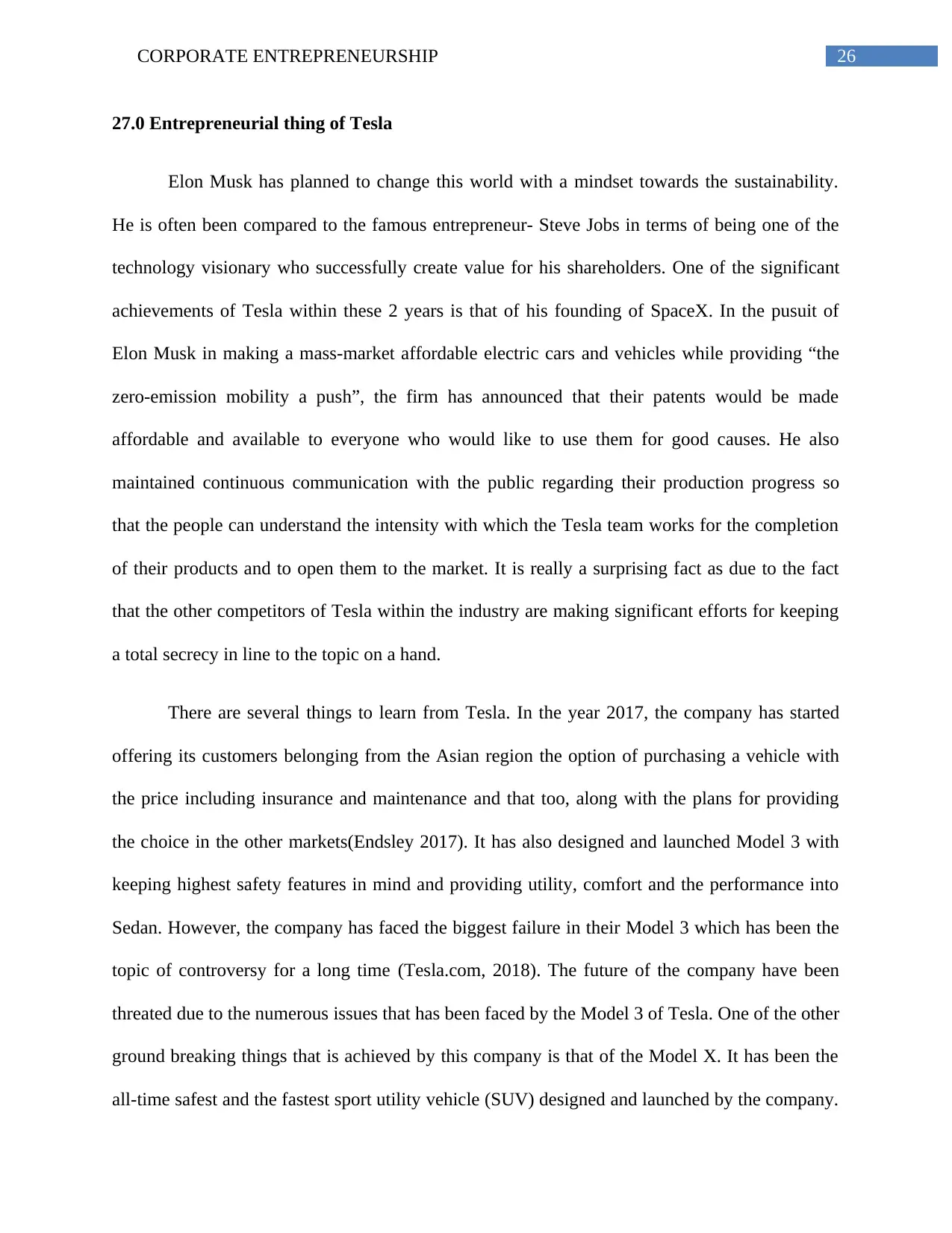
26CORPORATE ENTREPRENEURSHIP
27.0 Entrepreneurial thing of Tesla
Elon Musk has planned to change this world with a mindset towards the sustainability.
He is often been compared to the famous entrepreneur- Steve Jobs in terms of being one of the
technology visionary who successfully create value for his shareholders. One of the significant
achievements of Tesla within these 2 years is that of his founding of SpaceX. In the pusuit of
Elon Musk in making a mass-market affordable electric cars and vehicles while providing “the
zero-emission mobility a push”, the firm has announced that their patents would be made
affordable and available to everyone who would like to use them for good causes. He also
maintained continuous communication with the public regarding their production progress so
that the people can understand the intensity with which the Tesla team works for the completion
of their products and to open them to the market. It is really a surprising fact as due to the fact
that the other competitors of Tesla within the industry are making significant efforts for keeping
a total secrecy in line to the topic on a hand.
There are several things to learn from Tesla. In the year 2017, the company has started
offering its customers belonging from the Asian region the option of purchasing a vehicle with
the price including insurance and maintenance and that too, along with the plans for providing
the choice in the other markets(Endsley 2017). It has also designed and launched Model 3 with
keeping highest safety features in mind and providing utility, comfort and the performance into
Sedan. However, the company has faced the biggest failure in their Model 3 which has been the
topic of controversy for a long time (Tesla.com, 2018). The future of the company have been
threated due to the numerous issues that has been faced by the Model 3 of Tesla. One of the other
ground breaking things that is achieved by this company is that of the Model X. It has been the
all-time safest and the fastest sport utility vehicle (SUV) designed and launched by the company.
27.0 Entrepreneurial thing of Tesla
Elon Musk has planned to change this world with a mindset towards the sustainability.
He is often been compared to the famous entrepreneur- Steve Jobs in terms of being one of the
technology visionary who successfully create value for his shareholders. One of the significant
achievements of Tesla within these 2 years is that of his founding of SpaceX. In the pusuit of
Elon Musk in making a mass-market affordable electric cars and vehicles while providing “the
zero-emission mobility a push”, the firm has announced that their patents would be made
affordable and available to everyone who would like to use them for good causes. He also
maintained continuous communication with the public regarding their production progress so
that the people can understand the intensity with which the Tesla team works for the completion
of their products and to open them to the market. It is really a surprising fact as due to the fact
that the other competitors of Tesla within the industry are making significant efforts for keeping
a total secrecy in line to the topic on a hand.
There are several things to learn from Tesla. In the year 2017, the company has started
offering its customers belonging from the Asian region the option of purchasing a vehicle with
the price including insurance and maintenance and that too, along with the plans for providing
the choice in the other markets(Endsley 2017). It has also designed and launched Model 3 with
keeping highest safety features in mind and providing utility, comfort and the performance into
Sedan. However, the company has faced the biggest failure in their Model 3 which has been the
topic of controversy for a long time (Tesla.com, 2018). The future of the company have been
threated due to the numerous issues that has been faced by the Model 3 of Tesla. One of the other
ground breaking things that is achieved by this company is that of the Model X. It has been the
all-time safest and the fastest sport utility vehicle (SUV) designed and launched by the company.
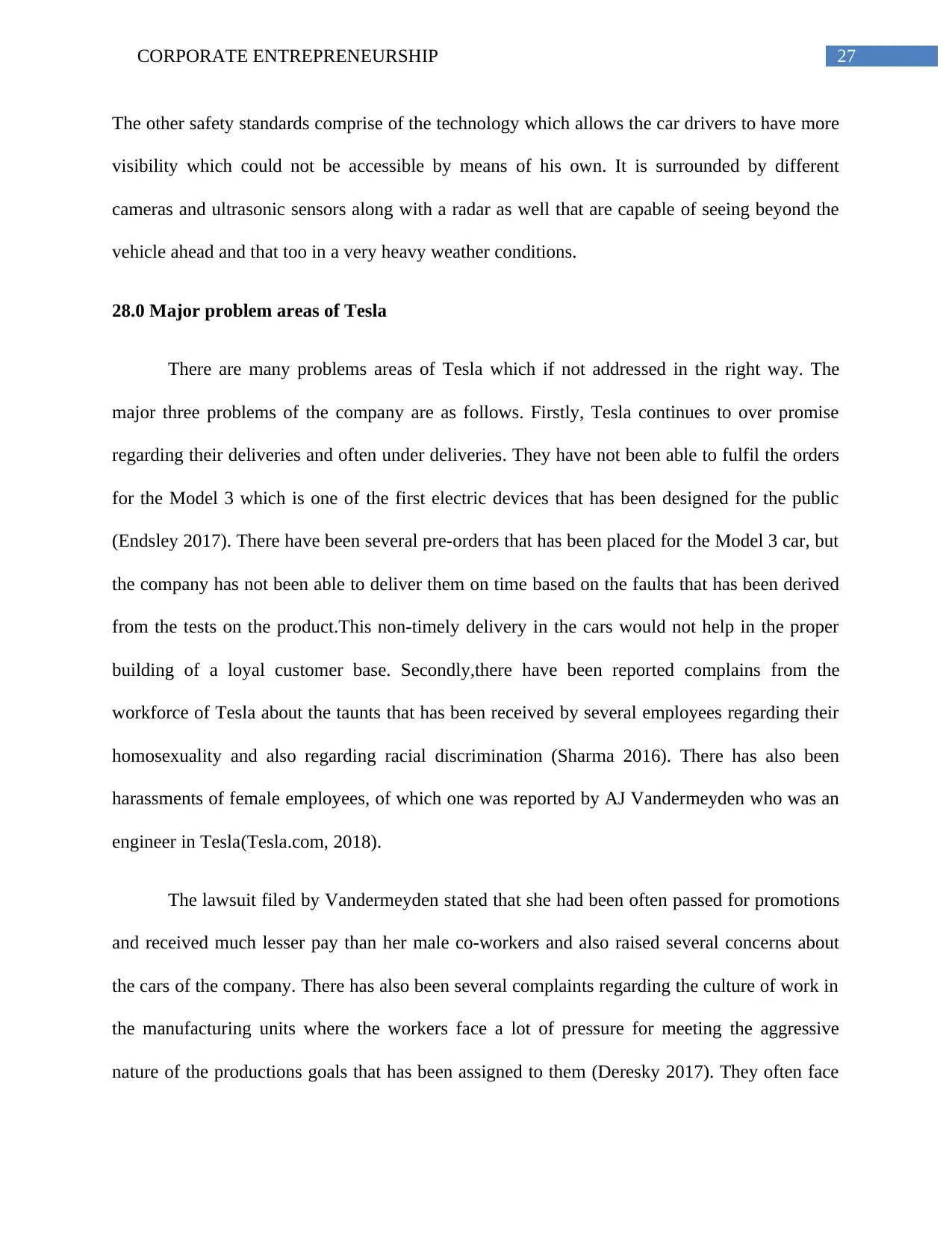
27CORPORATE ENTREPRENEURSHIP
The other safety standards comprise of the technology which allows the car drivers to have more
visibility which could not be accessible by means of his own. It is surrounded by different
cameras and ultrasonic sensors along with a radar as well that are capable of seeing beyond the
vehicle ahead and that too in a very heavy weather conditions.
28.0 Major problem areas of Tesla
There are many problems areas of Tesla which if not addressed in the right way. The
major three problems of the company are as follows. Firstly, Tesla continues to over promise
regarding their deliveries and often under deliveries. They have not been able to fulfil the orders
for the Model 3 which is one of the first electric devices that has been designed for the public
(Endsley 2017). There have been several pre-orders that has been placed for the Model 3 car, but
the company has not been able to deliver them on time based on the faults that has been derived
from the tests on the product.This non-timely delivery in the cars would not help in the proper
building of a loyal customer base. Secondly,there have been reported complains from the
workforce of Tesla about the taunts that has been received by several employees regarding their
homosexuality and also regarding racial discrimination (Sharma 2016). There has also been
harassments of female employees, of which one was reported by AJ Vandermeyden who was an
engineer in Tesla(Tesla.com, 2018).
The lawsuit filed by Vandermeyden stated that she had been often passed for promotions
and received much lesser pay than her male co-workers and also raised several concerns about
the cars of the company. There has also been several complaints regarding the culture of work in
the manufacturing units where the workers face a lot of pressure for meeting the aggressive
nature of the productions goals that has been assigned to them (Deresky 2017). They often face
The other safety standards comprise of the technology which allows the car drivers to have more
visibility which could not be accessible by means of his own. It is surrounded by different
cameras and ultrasonic sensors along with a radar as well that are capable of seeing beyond the
vehicle ahead and that too in a very heavy weather conditions.
28.0 Major problem areas of Tesla
There are many problems areas of Tesla which if not addressed in the right way. The
major three problems of the company are as follows. Firstly, Tesla continues to over promise
regarding their deliveries and often under deliveries. They have not been able to fulfil the orders
for the Model 3 which is one of the first electric devices that has been designed for the public
(Endsley 2017). There have been several pre-orders that has been placed for the Model 3 car, but
the company has not been able to deliver them on time based on the faults that has been derived
from the tests on the product.This non-timely delivery in the cars would not help in the proper
building of a loyal customer base. Secondly,there have been reported complains from the
workforce of Tesla about the taunts that has been received by several employees regarding their
homosexuality and also regarding racial discrimination (Sharma 2016). There has also been
harassments of female employees, of which one was reported by AJ Vandermeyden who was an
engineer in Tesla(Tesla.com, 2018).
The lawsuit filed by Vandermeyden stated that she had been often passed for promotions
and received much lesser pay than her male co-workers and also raised several concerns about
the cars of the company. There has also been several complaints regarding the culture of work in
the manufacturing units where the workers face a lot of pressure for meeting the aggressive
nature of the productions goals that has been assigned to them (Deresky 2017). They often face
Secure Best Marks with AI Grader
Need help grading? Try our AI Grader for instant feedback on your assignments.
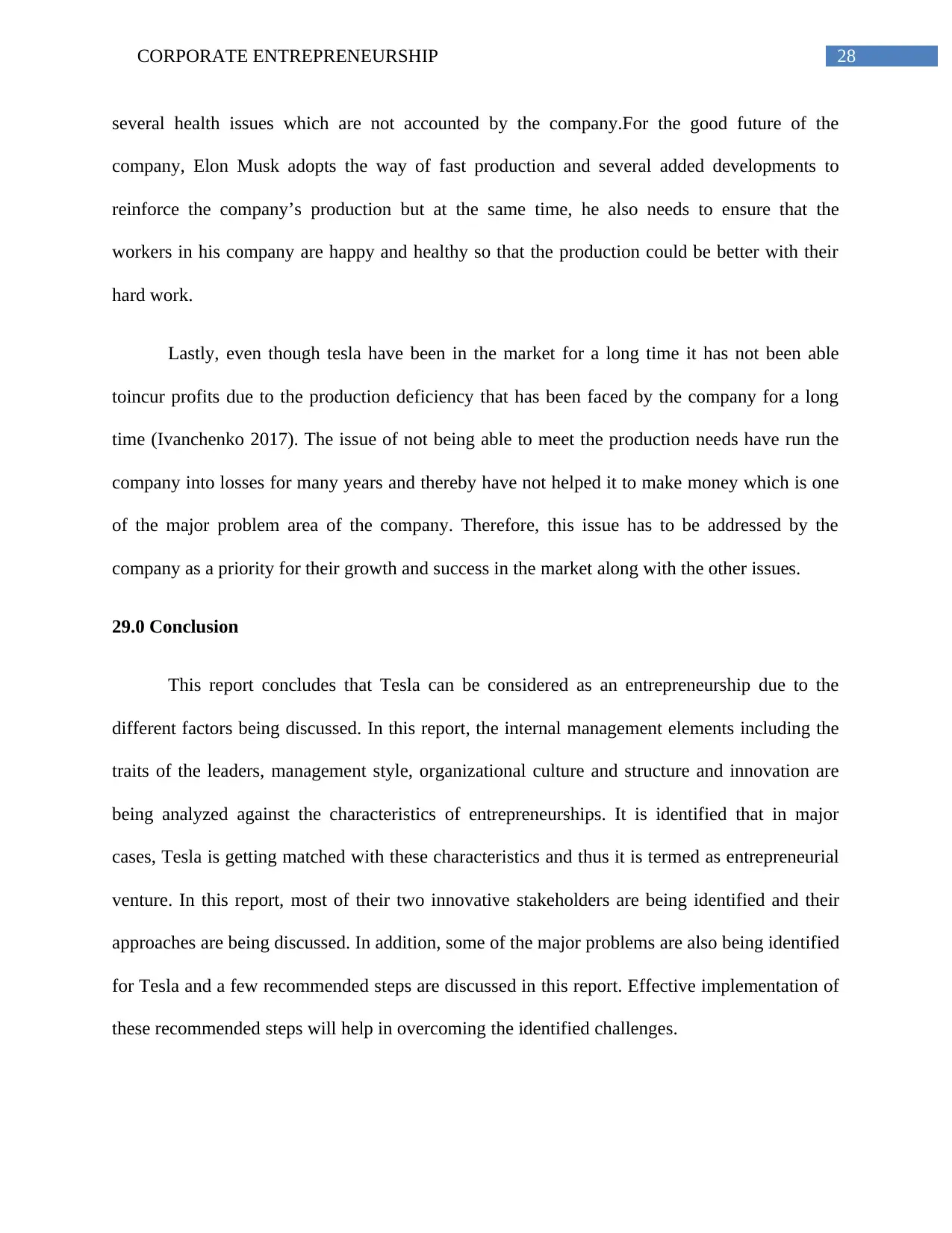
28CORPORATE ENTREPRENEURSHIP
several health issues which are not accounted by the company.For the good future of the
company, Elon Musk adopts the way of fast production and several added developments to
reinforce the company’s production but at the same time, he also needs to ensure that the
workers in his company are happy and healthy so that the production could be better with their
hard work.
Lastly, even though tesla have been in the market for a long time it has not been able
toincur profits due to the production deficiency that has been faced by the company for a long
time (Ivanchenko 2017). The issue of not being able to meet the production needs have run the
company into losses for many years and thereby have not helped it to make money which is one
of the major problem area of the company. Therefore, this issue has to be addressed by the
company as a priority for their growth and success in the market along with the other issues.
29.0 Conclusion
This report concludes that Tesla can be considered as an entrepreneurship due to the
different factors being discussed. In this report, the internal management elements including the
traits of the leaders, management style, organizational culture and structure and innovation are
being analyzed against the characteristics of entrepreneurships. It is identified that in major
cases, Tesla is getting matched with these characteristics and thus it is termed as entrepreneurial
venture. In this report, most of their two innovative stakeholders are being identified and their
approaches are being discussed. In addition, some of the major problems are also being identified
for Tesla and a few recommended steps are discussed in this report. Effective implementation of
these recommended steps will help in overcoming the identified challenges.
several health issues which are not accounted by the company.For the good future of the
company, Elon Musk adopts the way of fast production and several added developments to
reinforce the company’s production but at the same time, he also needs to ensure that the
workers in his company are happy and healthy so that the production could be better with their
hard work.
Lastly, even though tesla have been in the market for a long time it has not been able
toincur profits due to the production deficiency that has been faced by the company for a long
time (Ivanchenko 2017). The issue of not being able to meet the production needs have run the
company into losses for many years and thereby have not helped it to make money which is one
of the major problem area of the company. Therefore, this issue has to be addressed by the
company as a priority for their growth and success in the market along with the other issues.
29.0 Conclusion
This report concludes that Tesla can be considered as an entrepreneurship due to the
different factors being discussed. In this report, the internal management elements including the
traits of the leaders, management style, organizational culture and structure and innovation are
being analyzed against the characteristics of entrepreneurships. It is identified that in major
cases, Tesla is getting matched with these characteristics and thus it is termed as entrepreneurial
venture. In this report, most of their two innovative stakeholders are being identified and their
approaches are being discussed. In addition, some of the major problems are also being identified
for Tesla and a few recommended steps are discussed in this report. Effective implementation of
these recommended steps will help in overcoming the identified challenges.
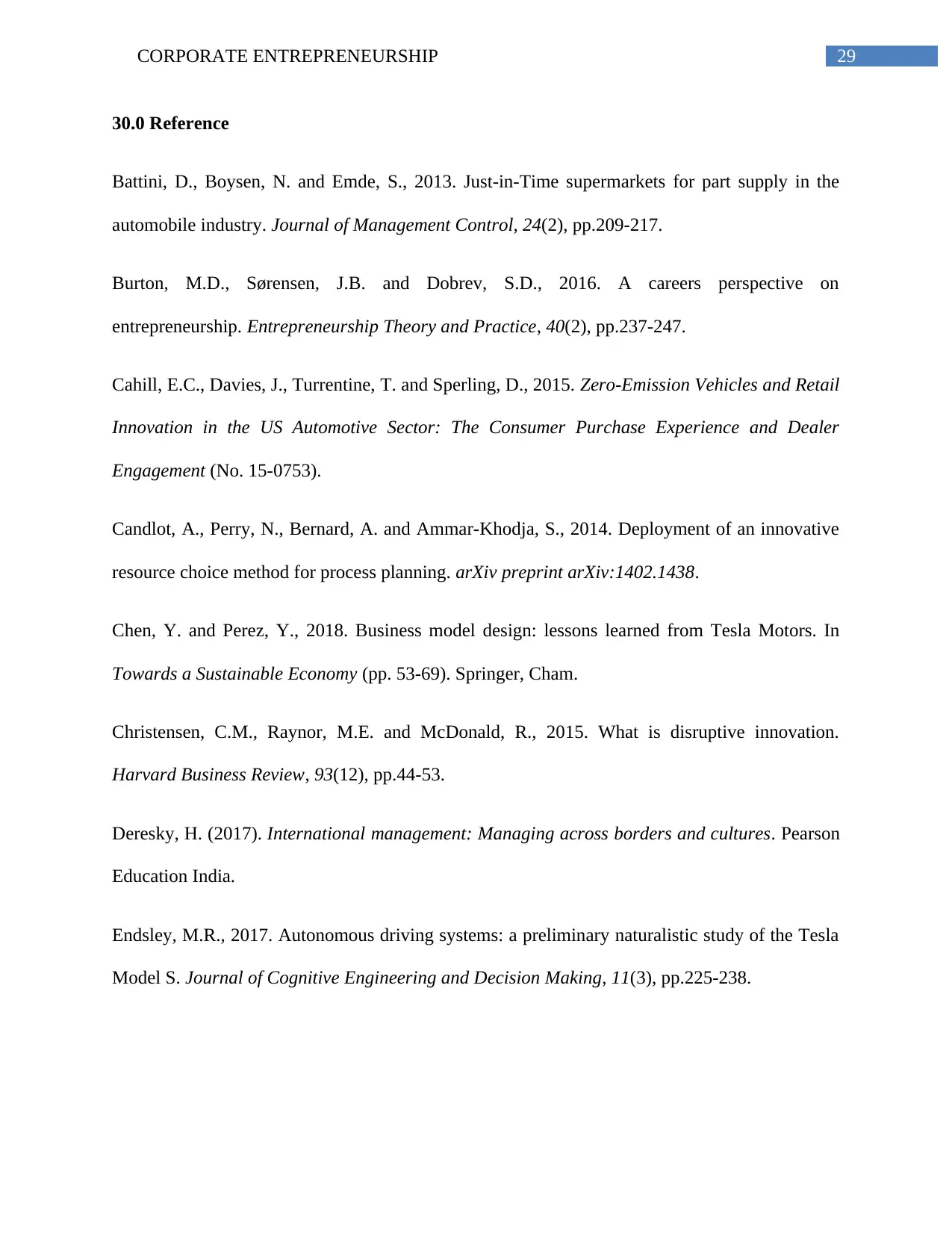
29CORPORATE ENTREPRENEURSHIP
30.0 Reference
Battini, D., Boysen, N. and Emde, S., 2013. Just-in-Time supermarkets for part supply in the
automobile industry. Journal of Management Control, 24(2), pp.209-217.
Burton, M.D., Sørensen, J.B. and Dobrev, S.D., 2016. A careers perspective on
entrepreneurship. Entrepreneurship Theory and Practice, 40(2), pp.237-247.
Cahill, E.C., Davies, J., Turrentine, T. and Sperling, D., 2015. Zero-Emission Vehicles and Retail
Innovation in the US Automotive Sector: The Consumer Purchase Experience and Dealer
Engagement (No. 15-0753).
Candlot, A., Perry, N., Bernard, A. and Ammar-Khodja, S., 2014. Deployment of an innovative
resource choice method for process planning. arXiv preprint arXiv:1402.1438.
Chen, Y. and Perez, Y., 2018. Business model design: lessons learned from Tesla Motors. In
Towards a Sustainable Economy (pp. 53-69). Springer, Cham.
Christensen, C.M., Raynor, M.E. and McDonald, R., 2015. What is disruptive innovation.
Harvard Business Review, 93(12), pp.44-53.
Deresky, H. (2017). International management: Managing across borders and cultures. Pearson
Education India.
Endsley, M.R., 2017. Autonomous driving systems: a preliminary naturalistic study of the Tesla
Model S. Journal of Cognitive Engineering and Decision Making, 11(3), pp.225-238.
30.0 Reference
Battini, D., Boysen, N. and Emde, S., 2013. Just-in-Time supermarkets for part supply in the
automobile industry. Journal of Management Control, 24(2), pp.209-217.
Burton, M.D., Sørensen, J.B. and Dobrev, S.D., 2016. A careers perspective on
entrepreneurship. Entrepreneurship Theory and Practice, 40(2), pp.237-247.
Cahill, E.C., Davies, J., Turrentine, T. and Sperling, D., 2015. Zero-Emission Vehicles and Retail
Innovation in the US Automotive Sector: The Consumer Purchase Experience and Dealer
Engagement (No. 15-0753).
Candlot, A., Perry, N., Bernard, A. and Ammar-Khodja, S., 2014. Deployment of an innovative
resource choice method for process planning. arXiv preprint arXiv:1402.1438.
Chen, Y. and Perez, Y., 2018. Business model design: lessons learned from Tesla Motors. In
Towards a Sustainable Economy (pp. 53-69). Springer, Cham.
Christensen, C.M., Raynor, M.E. and McDonald, R., 2015. What is disruptive innovation.
Harvard Business Review, 93(12), pp.44-53.
Deresky, H. (2017). International management: Managing across borders and cultures. Pearson
Education India.
Endsley, M.R., 2017. Autonomous driving systems: a preliminary naturalistic study of the Tesla
Model S. Journal of Cognitive Engineering and Decision Making, 11(3), pp.225-238.
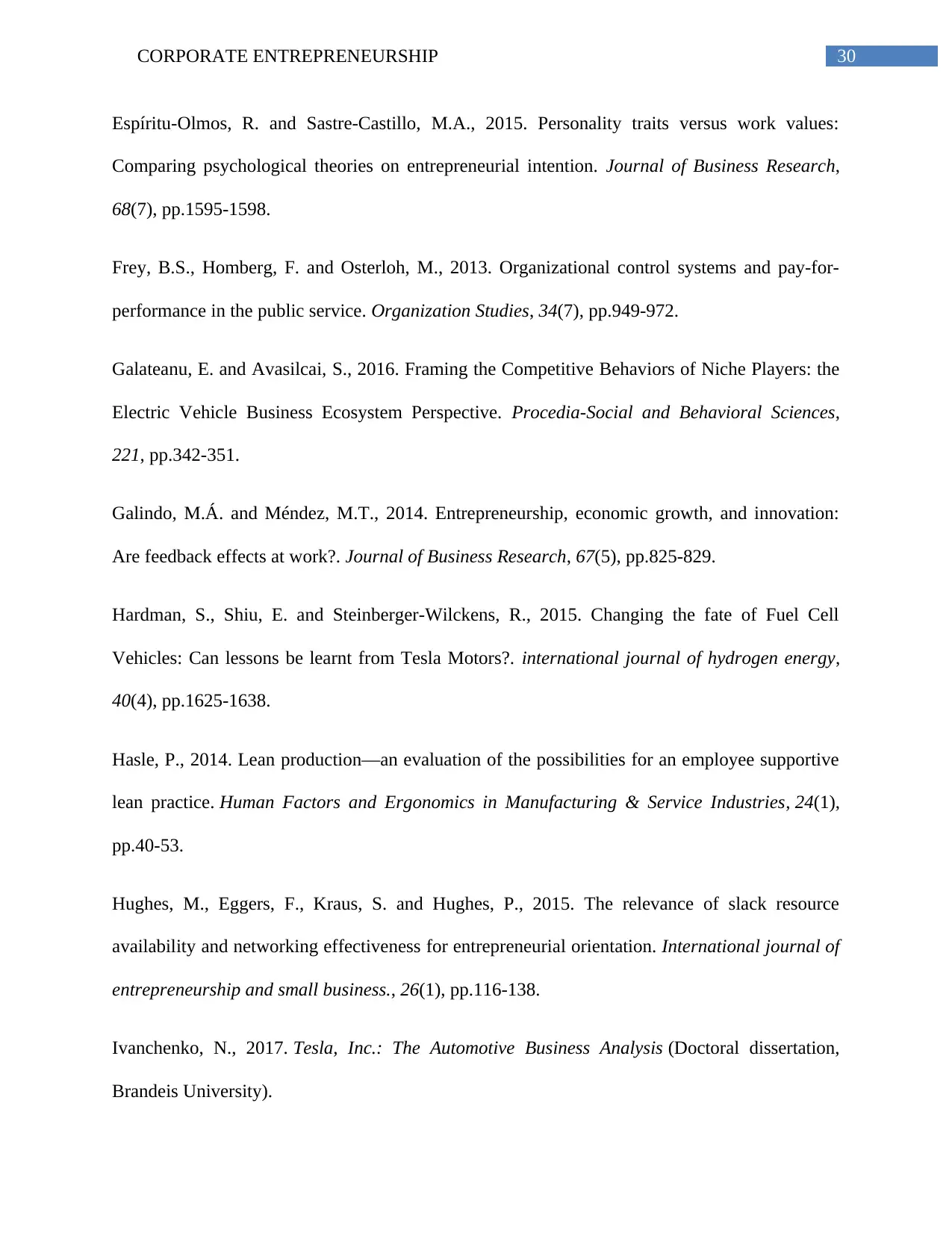
30CORPORATE ENTREPRENEURSHIP
Espíritu-Olmos, R. and Sastre-Castillo, M.A., 2015. Personality traits versus work values:
Comparing psychological theories on entrepreneurial intention. Journal of Business Research,
68(7), pp.1595-1598.
Frey, B.S., Homberg, F. and Osterloh, M., 2013. Organizational control systems and pay-for-
performance in the public service. Organization Studies, 34(7), pp.949-972.
Galateanu, E. and Avasilcai, S., 2016. Framing the Competitive Behaviors of Niche Players: the
Electric Vehicle Business Ecosystem Perspective. Procedia-Social and Behavioral Sciences,
221, pp.342-351.
Galindo, M.Á. and Méndez, M.T., 2014. Entrepreneurship, economic growth, and innovation:
Are feedback effects at work?. Journal of Business Research, 67(5), pp.825-829.
Hardman, S., Shiu, E. and Steinberger-Wilckens, R., 2015. Changing the fate of Fuel Cell
Vehicles: Can lessons be learnt from Tesla Motors?. international journal of hydrogen energy,
40(4), pp.1625-1638.
Hasle, P., 2014. Lean production—an evaluation of the possibilities for an employee supportive
lean practice. Human Factors and Ergonomics in Manufacturing & Service Industries, 24(1),
pp.40-53.
Hughes, M., Eggers, F., Kraus, S. and Hughes, P., 2015. The relevance of slack resource
availability and networking effectiveness for entrepreneurial orientation. International journal of
entrepreneurship and small business., 26(1), pp.116-138.
Ivanchenko, N., 2017. Tesla, Inc.: The Automotive Business Analysis (Doctoral dissertation,
Brandeis University).
Espíritu-Olmos, R. and Sastre-Castillo, M.A., 2015. Personality traits versus work values:
Comparing psychological theories on entrepreneurial intention. Journal of Business Research,
68(7), pp.1595-1598.
Frey, B.S., Homberg, F. and Osterloh, M., 2013. Organizational control systems and pay-for-
performance in the public service. Organization Studies, 34(7), pp.949-972.
Galateanu, E. and Avasilcai, S., 2016. Framing the Competitive Behaviors of Niche Players: the
Electric Vehicle Business Ecosystem Perspective. Procedia-Social and Behavioral Sciences,
221, pp.342-351.
Galindo, M.Á. and Méndez, M.T., 2014. Entrepreneurship, economic growth, and innovation:
Are feedback effects at work?. Journal of Business Research, 67(5), pp.825-829.
Hardman, S., Shiu, E. and Steinberger-Wilckens, R., 2015. Changing the fate of Fuel Cell
Vehicles: Can lessons be learnt from Tesla Motors?. international journal of hydrogen energy,
40(4), pp.1625-1638.
Hasle, P., 2014. Lean production—an evaluation of the possibilities for an employee supportive
lean practice. Human Factors and Ergonomics in Manufacturing & Service Industries, 24(1),
pp.40-53.
Hughes, M., Eggers, F., Kraus, S. and Hughes, P., 2015. The relevance of slack resource
availability and networking effectiveness for entrepreneurial orientation. International journal of
entrepreneurship and small business., 26(1), pp.116-138.
Ivanchenko, N., 2017. Tesla, Inc.: The Automotive Business Analysis (Doctoral dissertation,
Brandeis University).
Paraphrase This Document
Need a fresh take? Get an instant paraphrase of this document with our AI Paraphraser
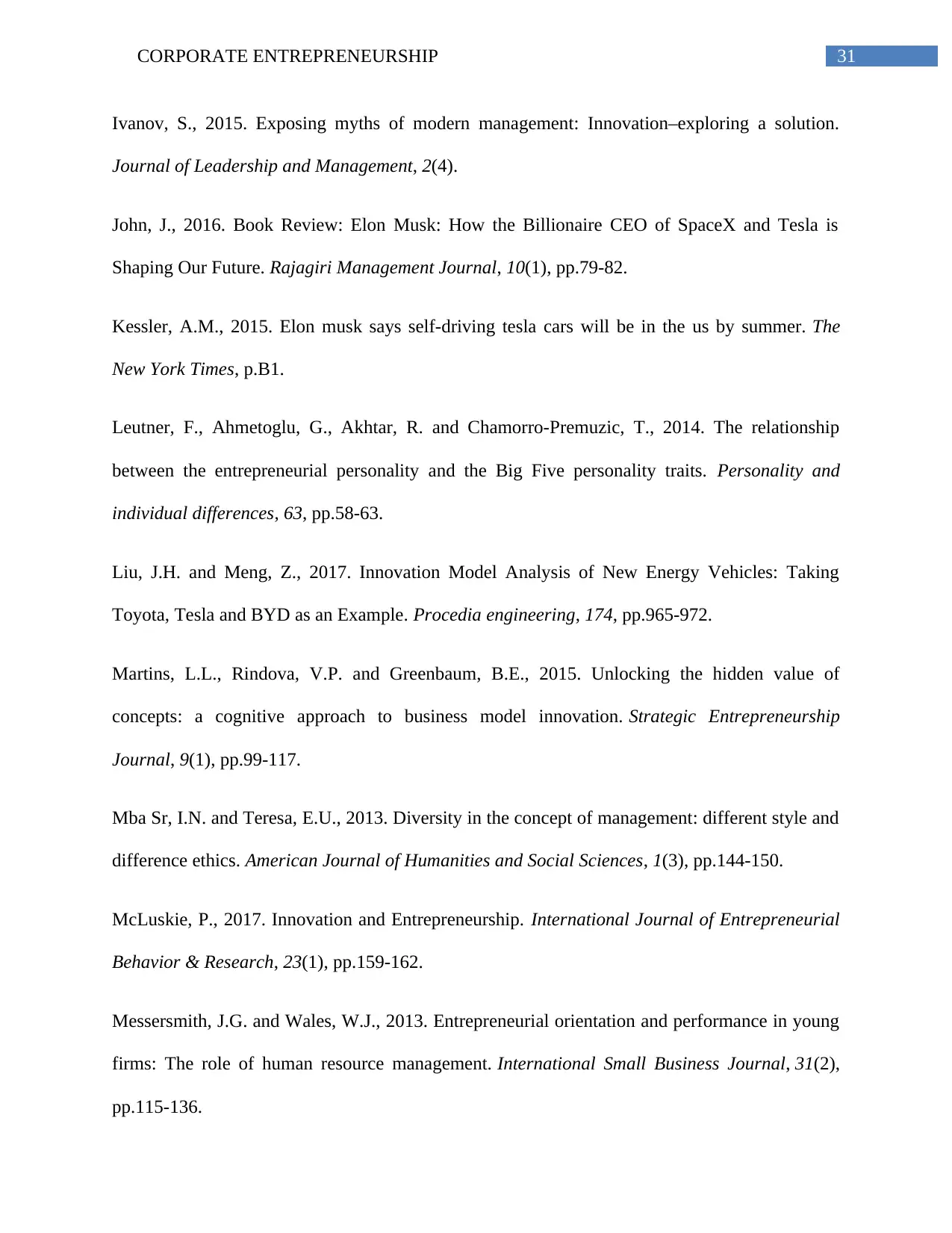
31CORPORATE ENTREPRENEURSHIP
Ivanov, S., 2015. Exposing myths of modern management: Innovation–exploring a solution.
Journal of Leadership and Management, 2(4).
John, J., 2016. Book Review: Elon Musk: How the Billionaire CEO of SpaceX and Tesla is
Shaping Our Future. Rajagiri Management Journal, 10(1), pp.79-82.
Kessler, A.M., 2015. Elon musk says self-driving tesla cars will be in the us by summer. The
New York Times, p.B1.
Leutner, F., Ahmetoglu, G., Akhtar, R. and Chamorro-Premuzic, T., 2014. The relationship
between the entrepreneurial personality and the Big Five personality traits. Personality and
individual differences, 63, pp.58-63.
Liu, J.H. and Meng, Z., 2017. Innovation Model Analysis of New Energy Vehicles: Taking
Toyota, Tesla and BYD as an Example. Procedia engineering, 174, pp.965-972.
Martins, L.L., Rindova, V.P. and Greenbaum, B.E., 2015. Unlocking the hidden value of
concepts: a cognitive approach to business model innovation. Strategic Entrepreneurship
Journal, 9(1), pp.99-117.
Mba Sr, I.N. and Teresa, E.U., 2013. Diversity in the concept of management: different style and
difference ethics. American Journal of Humanities and Social Sciences, 1(3), pp.144-150.
McLuskie, P., 2017. Innovation and Entrepreneurship. International Journal of Entrepreneurial
Behavior & Research, 23(1), pp.159-162.
Messersmith, J.G. and Wales, W.J., 2013. Entrepreneurial orientation and performance in young
firms: The role of human resource management. International Small Business Journal, 31(2),
pp.115-136.
Ivanov, S., 2015. Exposing myths of modern management: Innovation–exploring a solution.
Journal of Leadership and Management, 2(4).
John, J., 2016. Book Review: Elon Musk: How the Billionaire CEO of SpaceX and Tesla is
Shaping Our Future. Rajagiri Management Journal, 10(1), pp.79-82.
Kessler, A.M., 2015. Elon musk says self-driving tesla cars will be in the us by summer. The
New York Times, p.B1.
Leutner, F., Ahmetoglu, G., Akhtar, R. and Chamorro-Premuzic, T., 2014. The relationship
between the entrepreneurial personality and the Big Five personality traits. Personality and
individual differences, 63, pp.58-63.
Liu, J.H. and Meng, Z., 2017. Innovation Model Analysis of New Energy Vehicles: Taking
Toyota, Tesla and BYD as an Example. Procedia engineering, 174, pp.965-972.
Martins, L.L., Rindova, V.P. and Greenbaum, B.E., 2015. Unlocking the hidden value of
concepts: a cognitive approach to business model innovation. Strategic Entrepreneurship
Journal, 9(1), pp.99-117.
Mba Sr, I.N. and Teresa, E.U., 2013. Diversity in the concept of management: different style and
difference ethics. American Journal of Humanities and Social Sciences, 1(3), pp.144-150.
McLuskie, P., 2017. Innovation and Entrepreneurship. International Journal of Entrepreneurial
Behavior & Research, 23(1), pp.159-162.
Messersmith, J.G. and Wales, W.J., 2013. Entrepreneurial orientation and performance in young
firms: The role of human resource management. International Small Business Journal, 31(2),
pp.115-136.
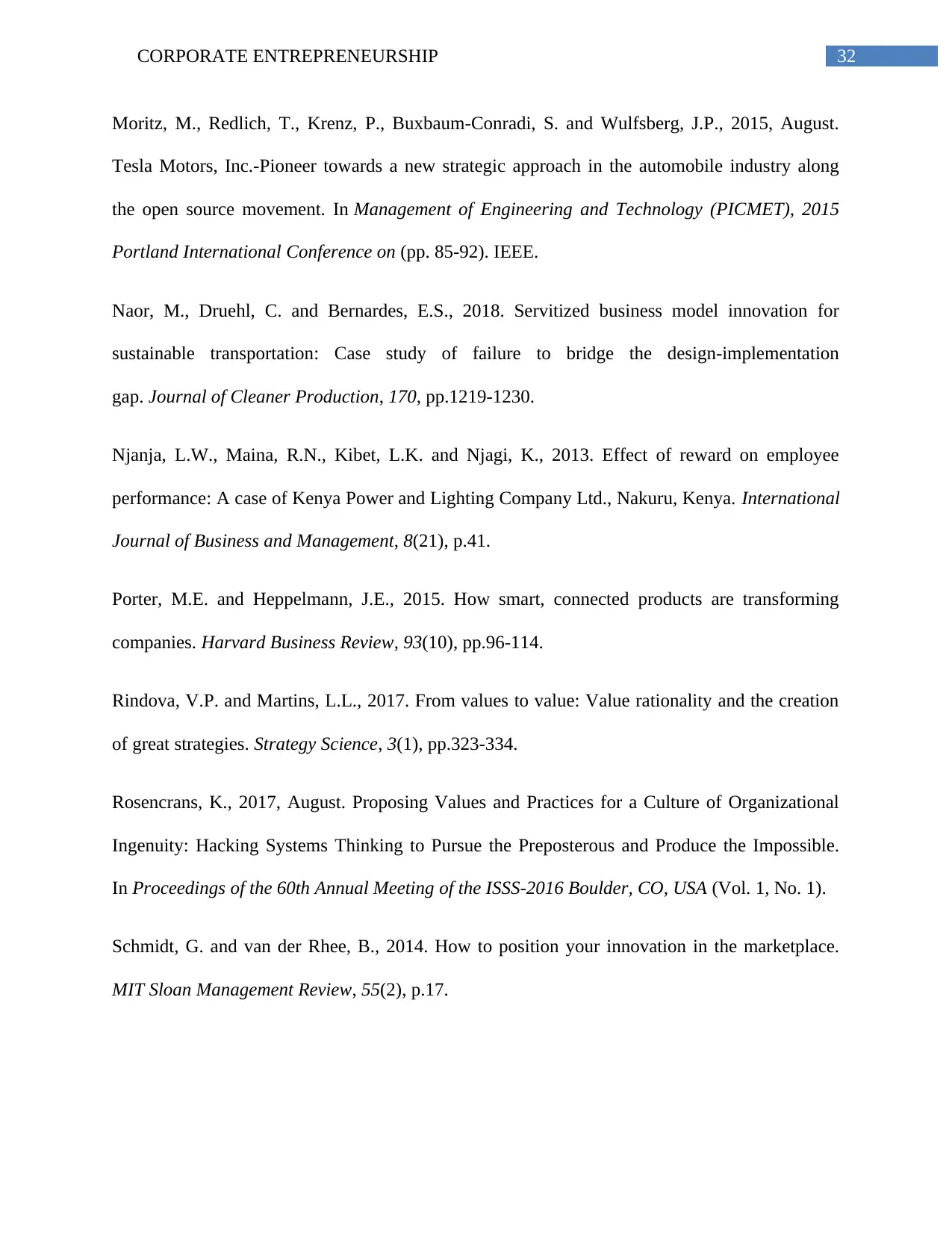
32CORPORATE ENTREPRENEURSHIP
Moritz, M., Redlich, T., Krenz, P., Buxbaum-Conradi, S. and Wulfsberg, J.P., 2015, August.
Tesla Motors, Inc.-Pioneer towards a new strategic approach in the automobile industry along
the open source movement. In Management of Engineering and Technology (PICMET), 2015
Portland International Conference on (pp. 85-92). IEEE.
Naor, M., Druehl, C. and Bernardes, E.S., 2018. Servitized business model innovation for
sustainable transportation: Case study of failure to bridge the design-implementation
gap. Journal of Cleaner Production, 170, pp.1219-1230.
Njanja, L.W., Maina, R.N., Kibet, L.K. and Njagi, K., 2013. Effect of reward on employee
performance: A case of Kenya Power and Lighting Company Ltd., Nakuru, Kenya. International
Journal of Business and Management, 8(21), p.41.
Porter, M.E. and Heppelmann, J.E., 2015. How smart, connected products are transforming
companies. Harvard Business Review, 93(10), pp.96-114.
Rindova, V.P. and Martins, L.L., 2017. From values to value: Value rationality and the creation
of great strategies. Strategy Science, 3(1), pp.323-334.
Rosencrans, K., 2017, August. Proposing Values and Practices for a Culture of Organizational
Ingenuity: Hacking Systems Thinking to Pursue the Preposterous and Produce the Impossible.
In Proceedings of the 60th Annual Meeting of the ISSS-2016 Boulder, CO, USA (Vol. 1, No. 1).
Schmidt, G. and van der Rhee, B., 2014. How to position your innovation in the marketplace.
MIT Sloan Management Review, 55(2), p.17.
Moritz, M., Redlich, T., Krenz, P., Buxbaum-Conradi, S. and Wulfsberg, J.P., 2015, August.
Tesla Motors, Inc.-Pioneer towards a new strategic approach in the automobile industry along
the open source movement. In Management of Engineering and Technology (PICMET), 2015
Portland International Conference on (pp. 85-92). IEEE.
Naor, M., Druehl, C. and Bernardes, E.S., 2018. Servitized business model innovation for
sustainable transportation: Case study of failure to bridge the design-implementation
gap. Journal of Cleaner Production, 170, pp.1219-1230.
Njanja, L.W., Maina, R.N., Kibet, L.K. and Njagi, K., 2013. Effect of reward on employee
performance: A case of Kenya Power and Lighting Company Ltd., Nakuru, Kenya. International
Journal of Business and Management, 8(21), p.41.
Porter, M.E. and Heppelmann, J.E., 2015. How smart, connected products are transforming
companies. Harvard Business Review, 93(10), pp.96-114.
Rindova, V.P. and Martins, L.L., 2017. From values to value: Value rationality and the creation
of great strategies. Strategy Science, 3(1), pp.323-334.
Rosencrans, K., 2017, August. Proposing Values and Practices for a Culture of Organizational
Ingenuity: Hacking Systems Thinking to Pursue the Preposterous and Produce the Impossible.
In Proceedings of the 60th Annual Meeting of the ISSS-2016 Boulder, CO, USA (Vol. 1, No. 1).
Schmidt, G. and van der Rhee, B., 2014. How to position your innovation in the marketplace.
MIT Sloan Management Review, 55(2), p.17.
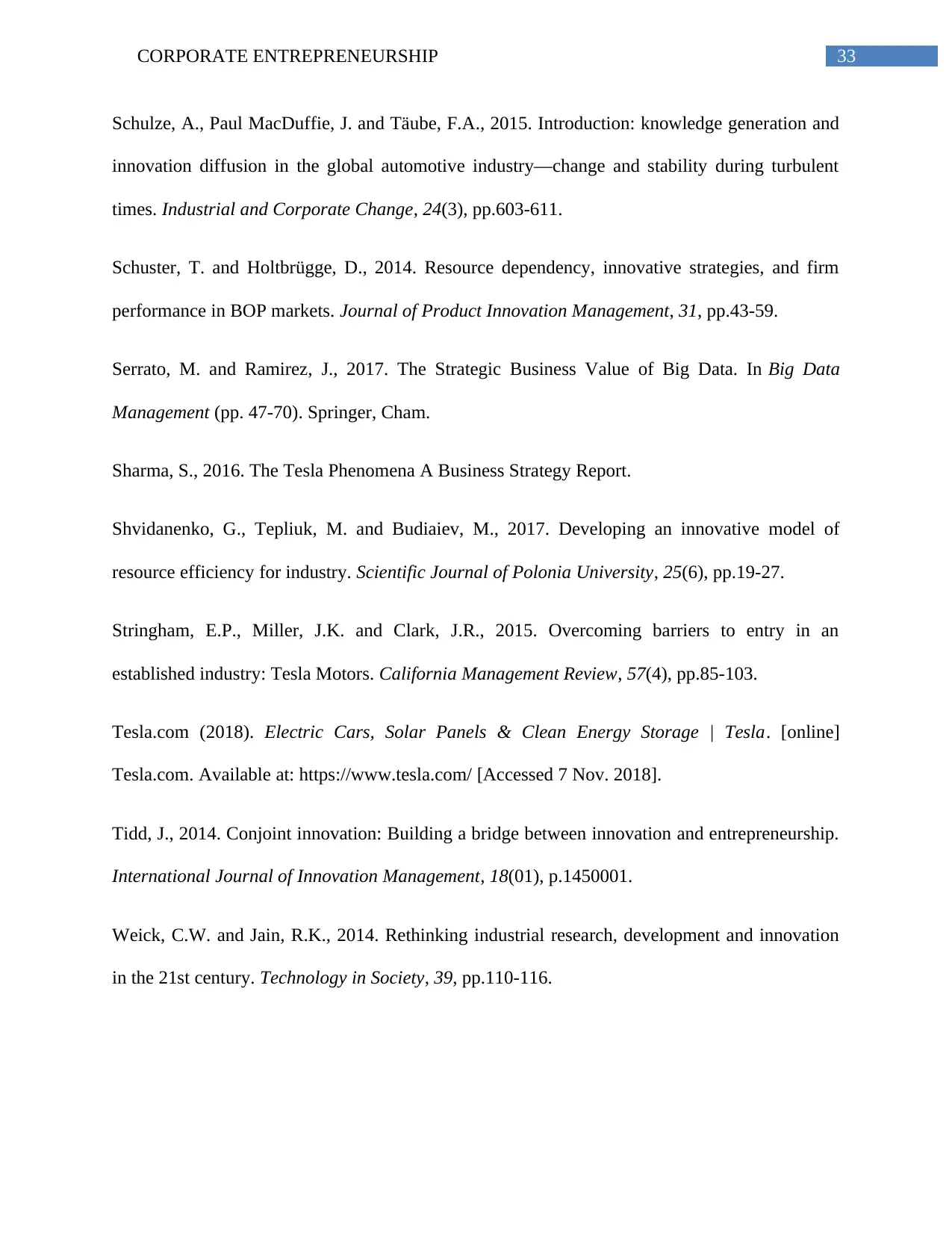
33CORPORATE ENTREPRENEURSHIP
Schulze, A., Paul MacDuffie, J. and Täube, F.A., 2015. Introduction: knowledge generation and
innovation diffusion in the global automotive industry—change and stability during turbulent
times. Industrial and Corporate Change, 24(3), pp.603-611.
Schuster, T. and Holtbrügge, D., 2014. Resource dependency, innovative strategies, and firm
performance in BOP markets. Journal of Product Innovation Management, 31, pp.43-59.
Serrato, M. and Ramirez, J., 2017. The Strategic Business Value of Big Data. In Big Data
Management (pp. 47-70). Springer, Cham.
Sharma, S., 2016. The Tesla Phenomena A Business Strategy Report.
Shvidanenko, G., Tepliuk, M. and Budiaiev, M., 2017. Developing an innovative model of
resource efficiency for industry. Scientific Journal of Polonia University, 25(6), pp.19-27.
Stringham, E.P., Miller, J.K. and Clark, J.R., 2015. Overcoming barriers to entry in an
established industry: Tesla Motors. California Management Review, 57(4), pp.85-103.
Tesla.com (2018). Electric Cars, Solar Panels & Clean Energy Storage | Tesla. [online]
Tesla.com. Available at: https://www.tesla.com/ [Accessed 7 Nov. 2018].
Tidd, J., 2014. Conjoint innovation: Building a bridge between innovation and entrepreneurship.
International Journal of Innovation Management, 18(01), p.1450001.
Weick, C.W. and Jain, R.K., 2014. Rethinking industrial research, development and innovation
in the 21st century. Technology in Society, 39, pp.110-116.
Schulze, A., Paul MacDuffie, J. and Täube, F.A., 2015. Introduction: knowledge generation and
innovation diffusion in the global automotive industry—change and stability during turbulent
times. Industrial and Corporate Change, 24(3), pp.603-611.
Schuster, T. and Holtbrügge, D., 2014. Resource dependency, innovative strategies, and firm
performance in BOP markets. Journal of Product Innovation Management, 31, pp.43-59.
Serrato, M. and Ramirez, J., 2017. The Strategic Business Value of Big Data. In Big Data
Management (pp. 47-70). Springer, Cham.
Sharma, S., 2016. The Tesla Phenomena A Business Strategy Report.
Shvidanenko, G., Tepliuk, M. and Budiaiev, M., 2017. Developing an innovative model of
resource efficiency for industry. Scientific Journal of Polonia University, 25(6), pp.19-27.
Stringham, E.P., Miller, J.K. and Clark, J.R., 2015. Overcoming barriers to entry in an
established industry: Tesla Motors. California Management Review, 57(4), pp.85-103.
Tesla.com (2018). Electric Cars, Solar Panels & Clean Energy Storage | Tesla. [online]
Tesla.com. Available at: https://www.tesla.com/ [Accessed 7 Nov. 2018].
Tidd, J., 2014. Conjoint innovation: Building a bridge between innovation and entrepreneurship.
International Journal of Innovation Management, 18(01), p.1450001.
Weick, C.W. and Jain, R.K., 2014. Rethinking industrial research, development and innovation
in the 21st century. Technology in Society, 39, pp.110-116.
Secure Best Marks with AI Grader
Need help grading? Try our AI Grader for instant feedback on your assignments.
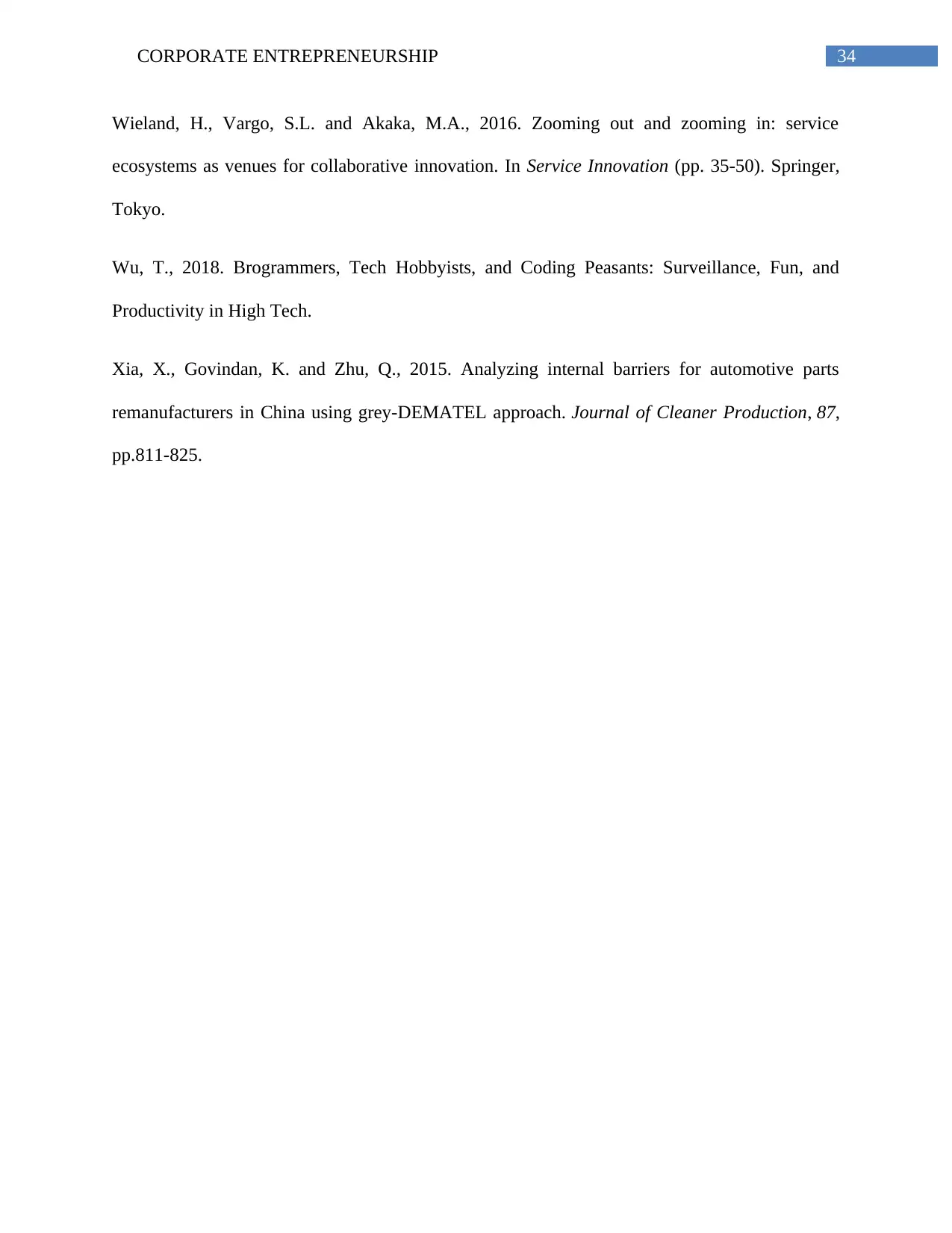
34CORPORATE ENTREPRENEURSHIP
Wieland, H., Vargo, S.L. and Akaka, M.A., 2016. Zooming out and zooming in: service
ecosystems as venues for collaborative innovation. In Service Innovation (pp. 35-50). Springer,
Tokyo.
Wu, T., 2018. Brogrammers, Tech Hobbyists, and Coding Peasants: Surveillance, Fun, and
Productivity in High Tech.
Xia, X., Govindan, K. and Zhu, Q., 2015. Analyzing internal barriers for automotive parts
remanufacturers in China using grey-DEMATEL approach. Journal of Cleaner Production, 87,
pp.811-825.
Wieland, H., Vargo, S.L. and Akaka, M.A., 2016. Zooming out and zooming in: service
ecosystems as venues for collaborative innovation. In Service Innovation (pp. 35-50). Springer,
Tokyo.
Wu, T., 2018. Brogrammers, Tech Hobbyists, and Coding Peasants: Surveillance, Fun, and
Productivity in High Tech.
Xia, X., Govindan, K. and Zhu, Q., 2015. Analyzing internal barriers for automotive parts
remanufacturers in China using grey-DEMATEL approach. Journal of Cleaner Production, 87,
pp.811-825.
1 out of 35
Related Documents
Your All-in-One AI-Powered Toolkit for Academic Success.
+13062052269
info@desklib.com
Available 24*7 on WhatsApp / Email
![[object Object]](/_next/static/media/star-bottom.7253800d.svg)
Unlock your academic potential
© 2024 | Zucol Services PVT LTD | All rights reserved.





